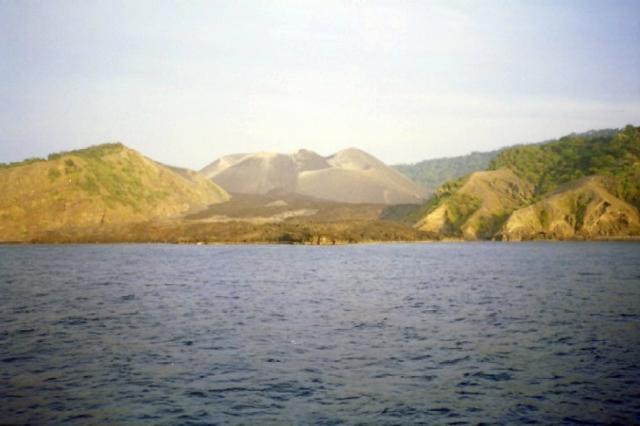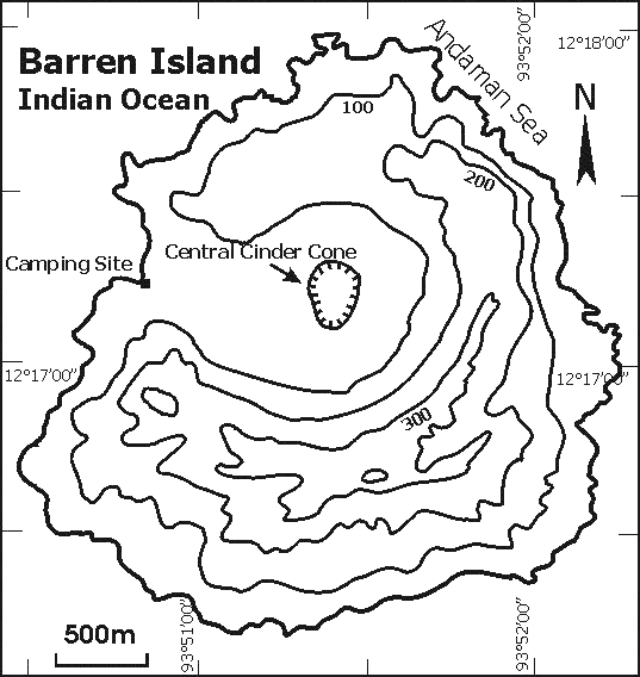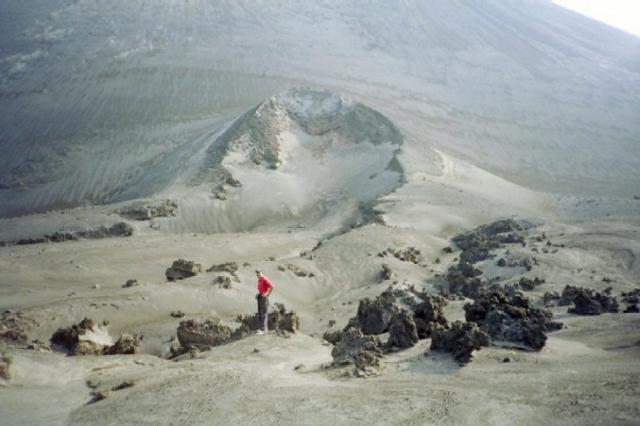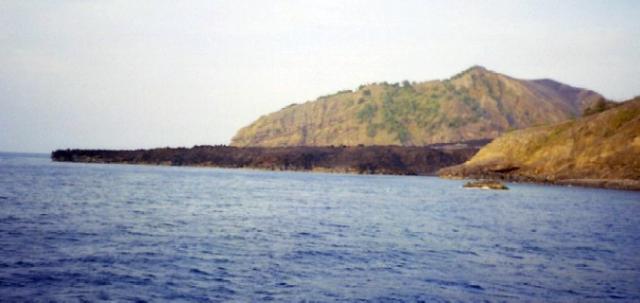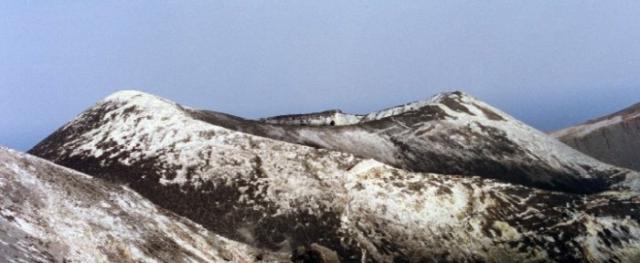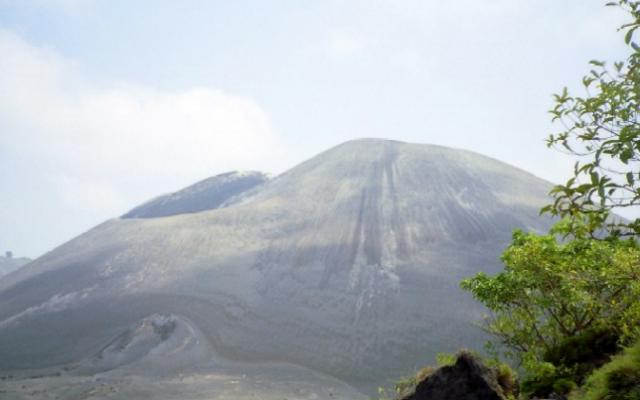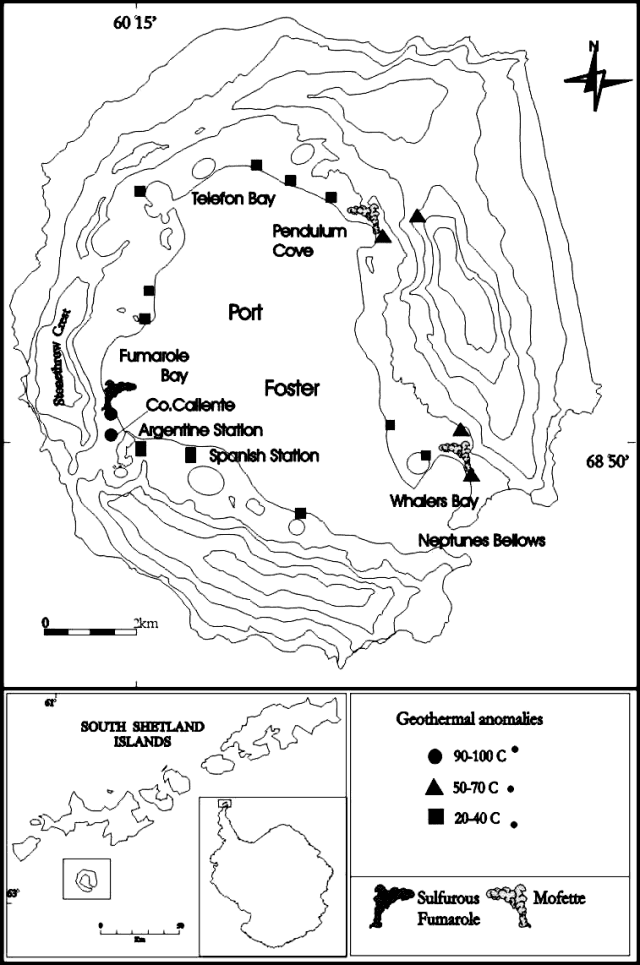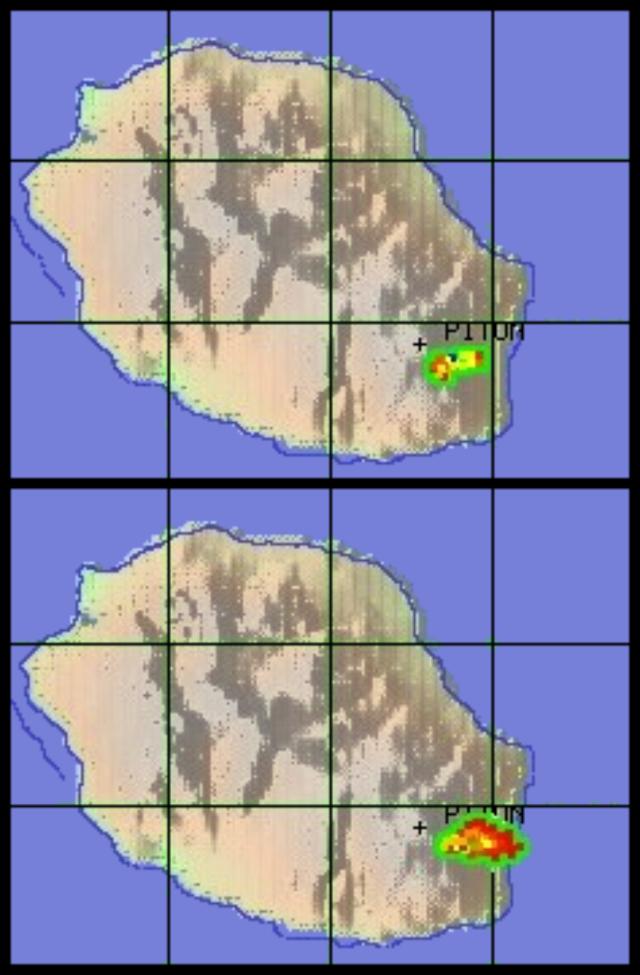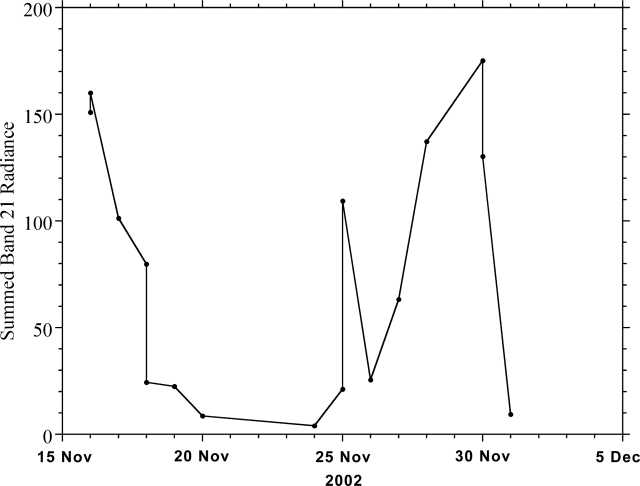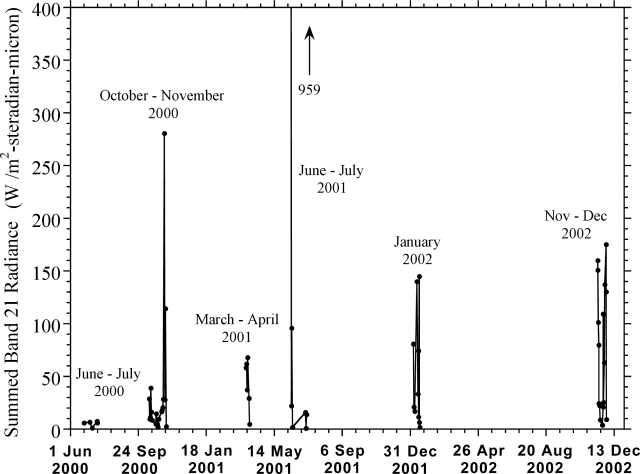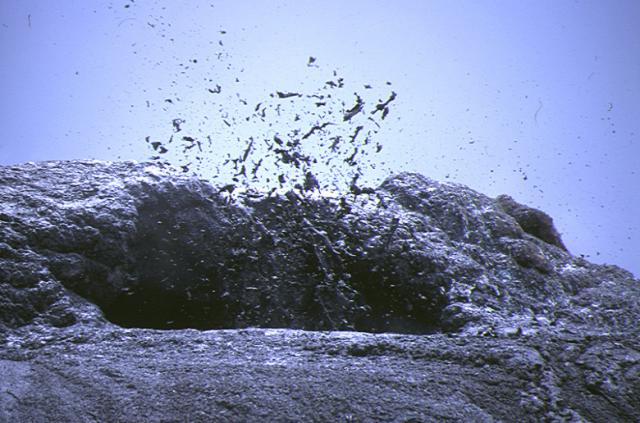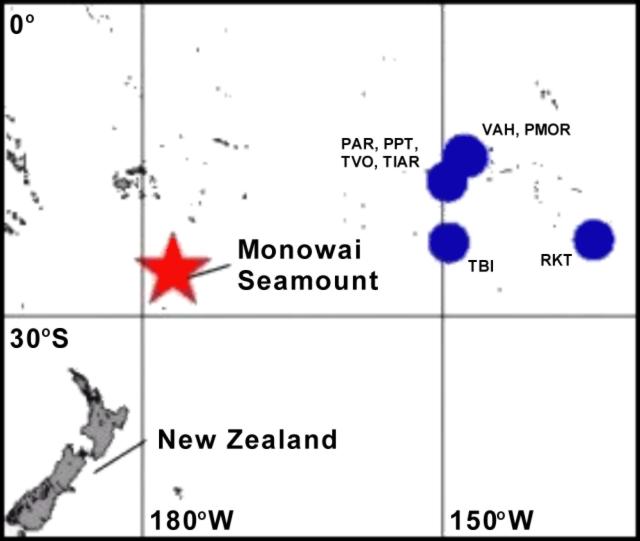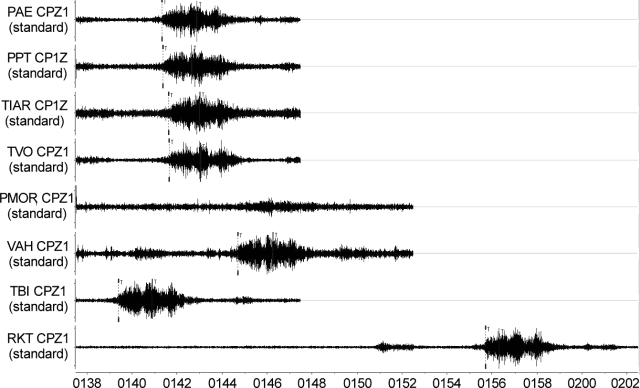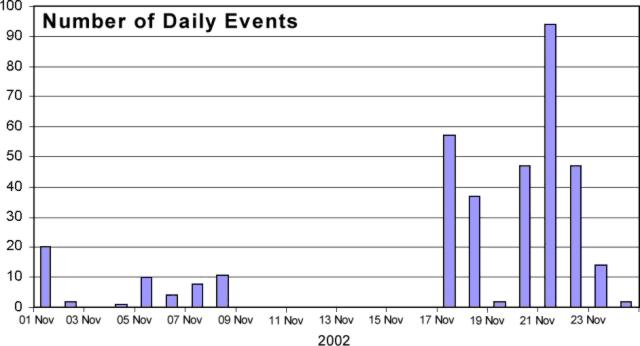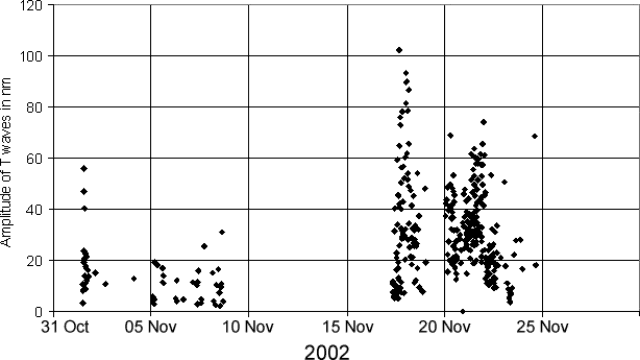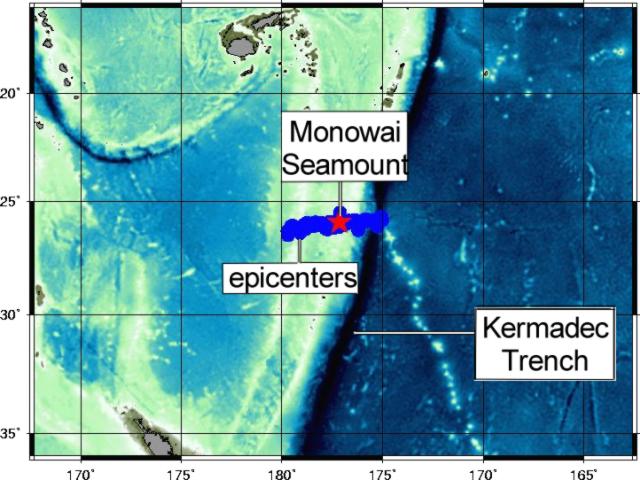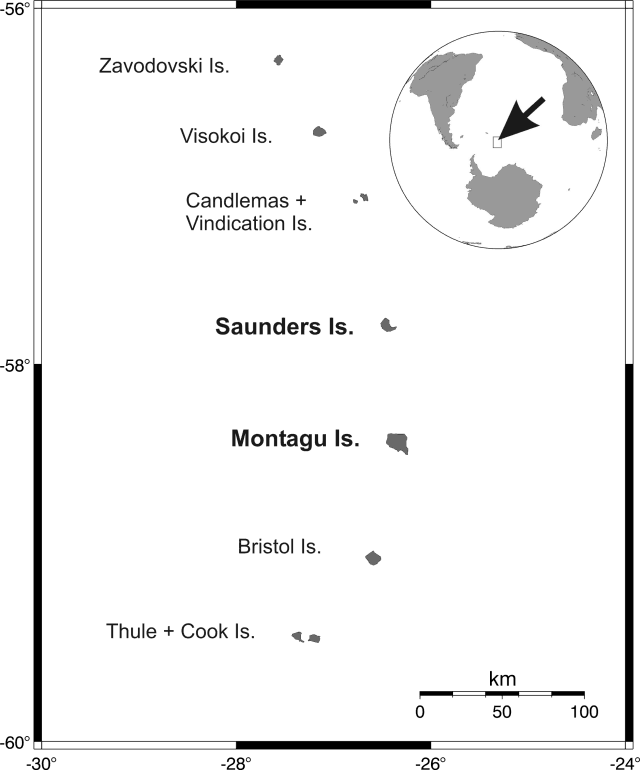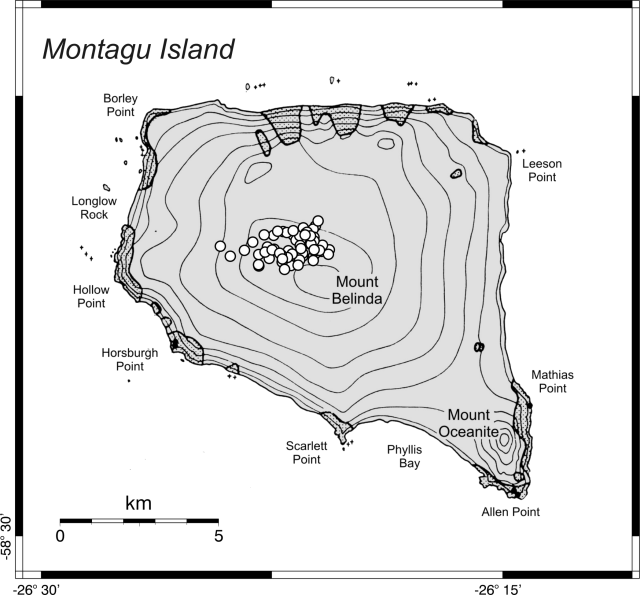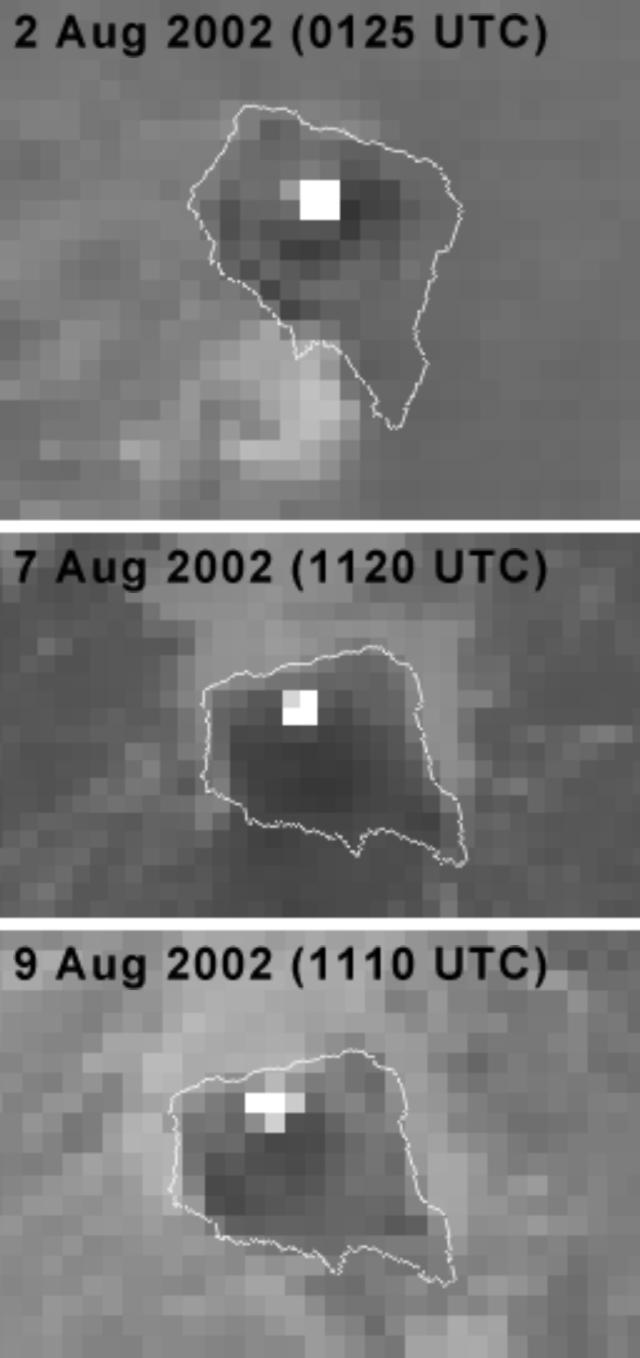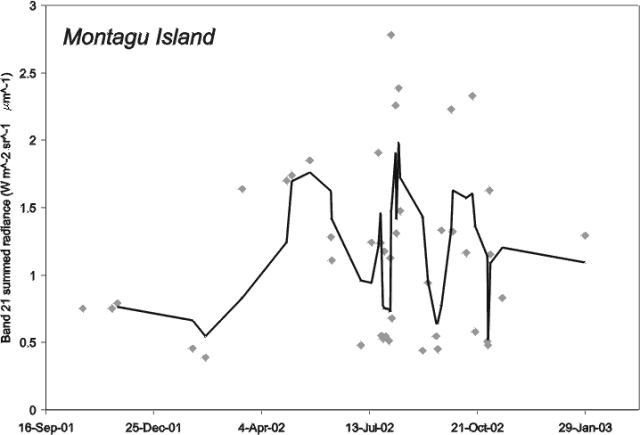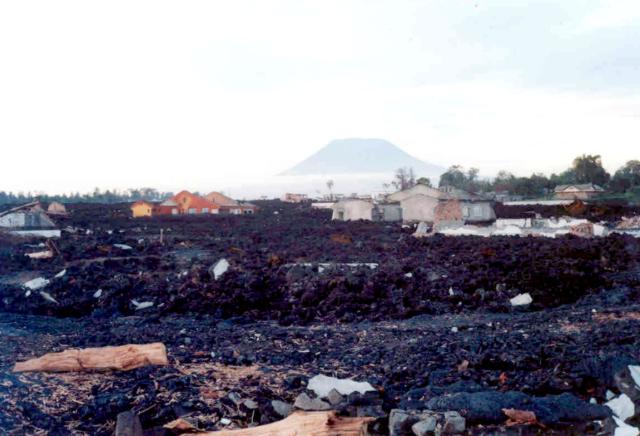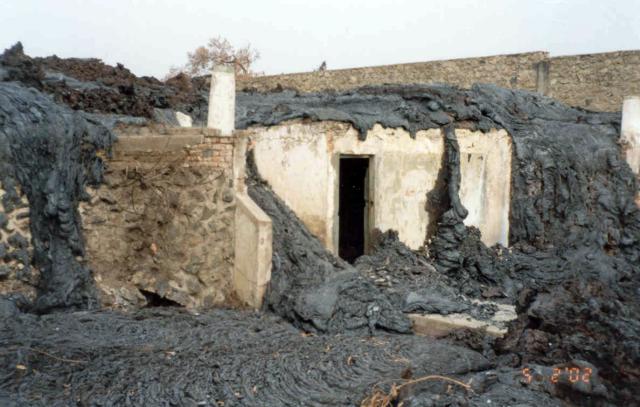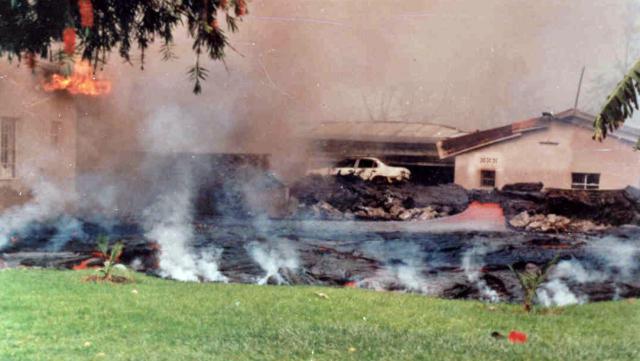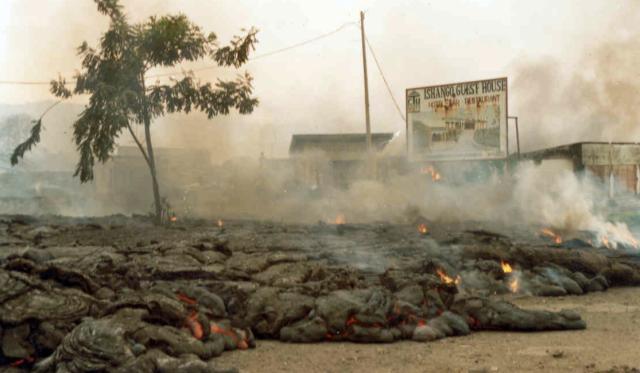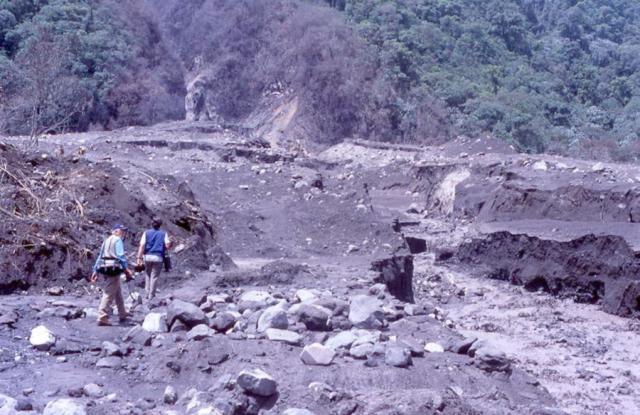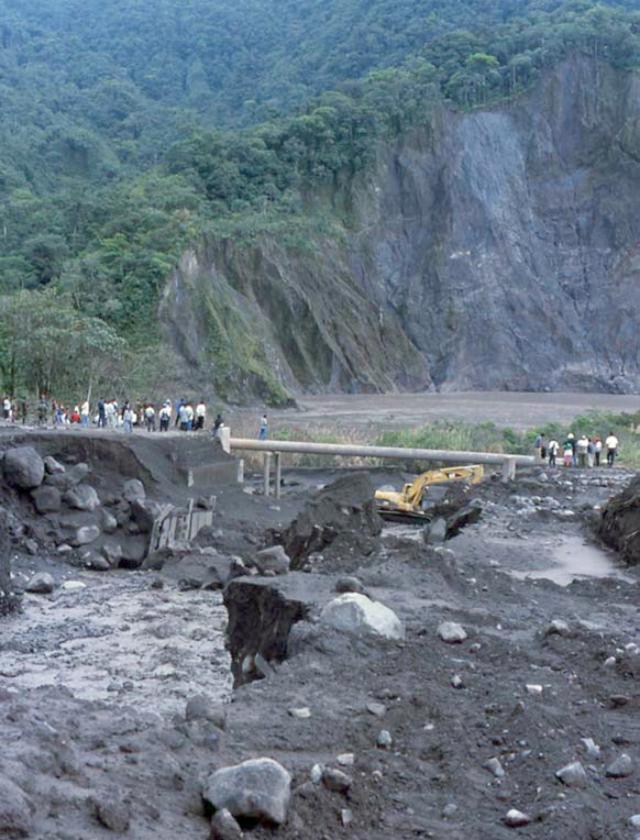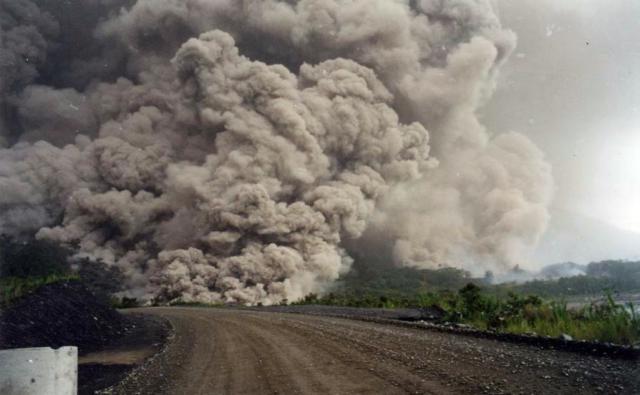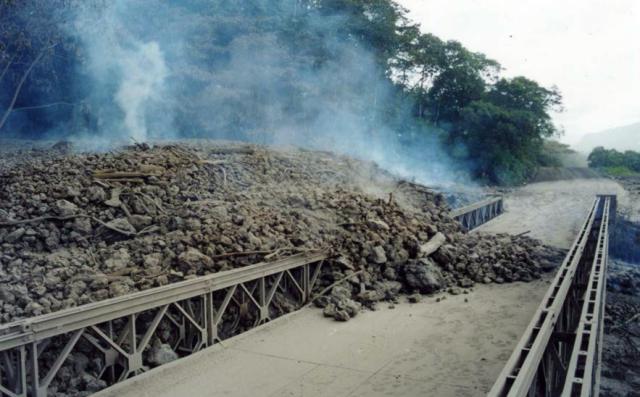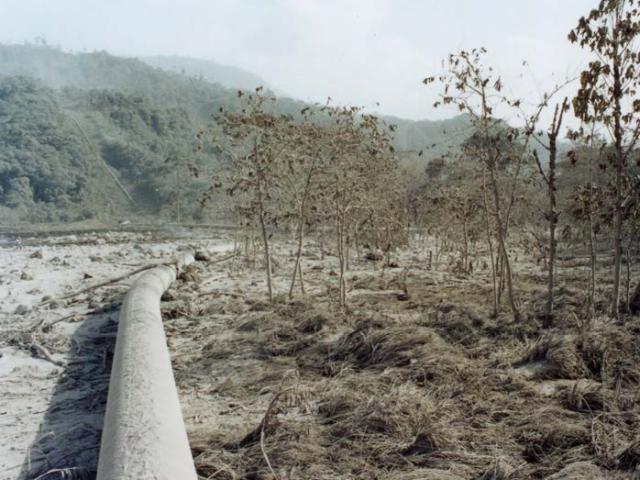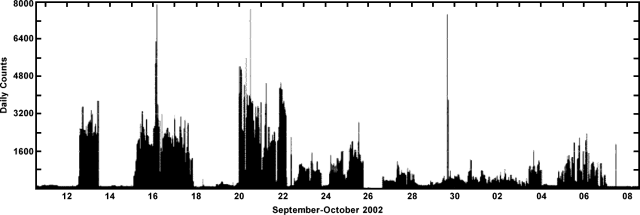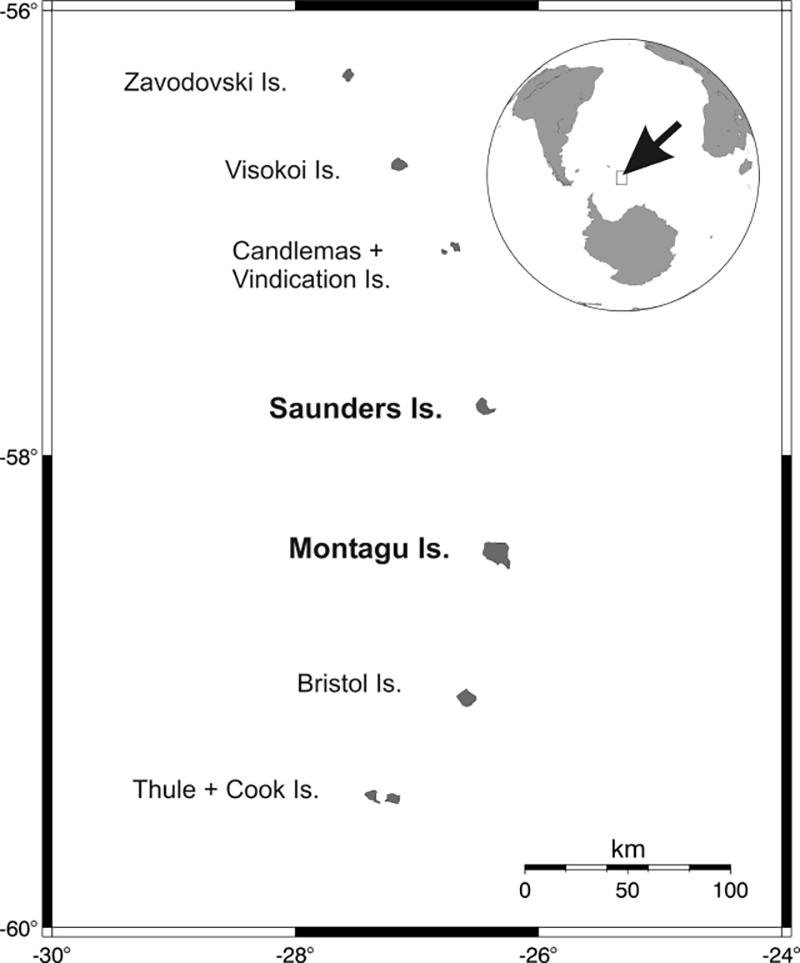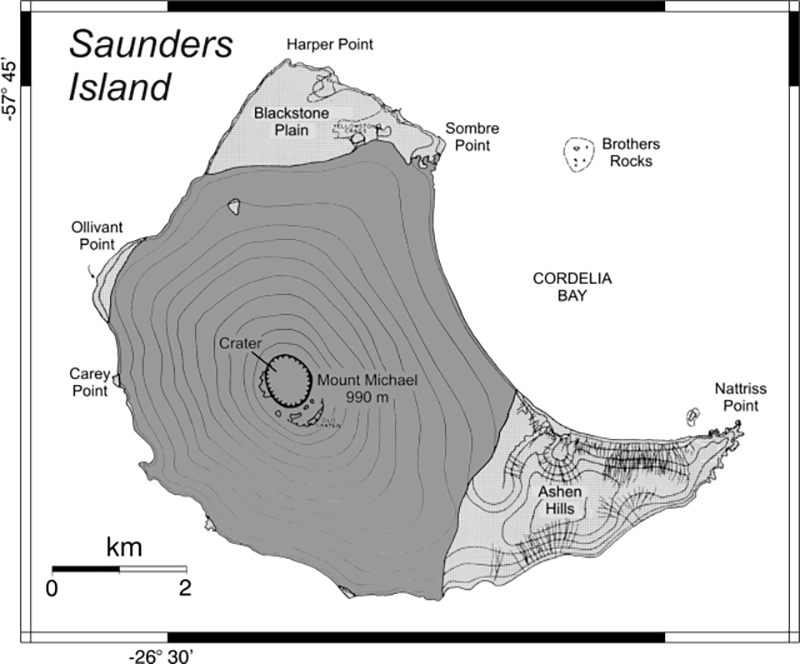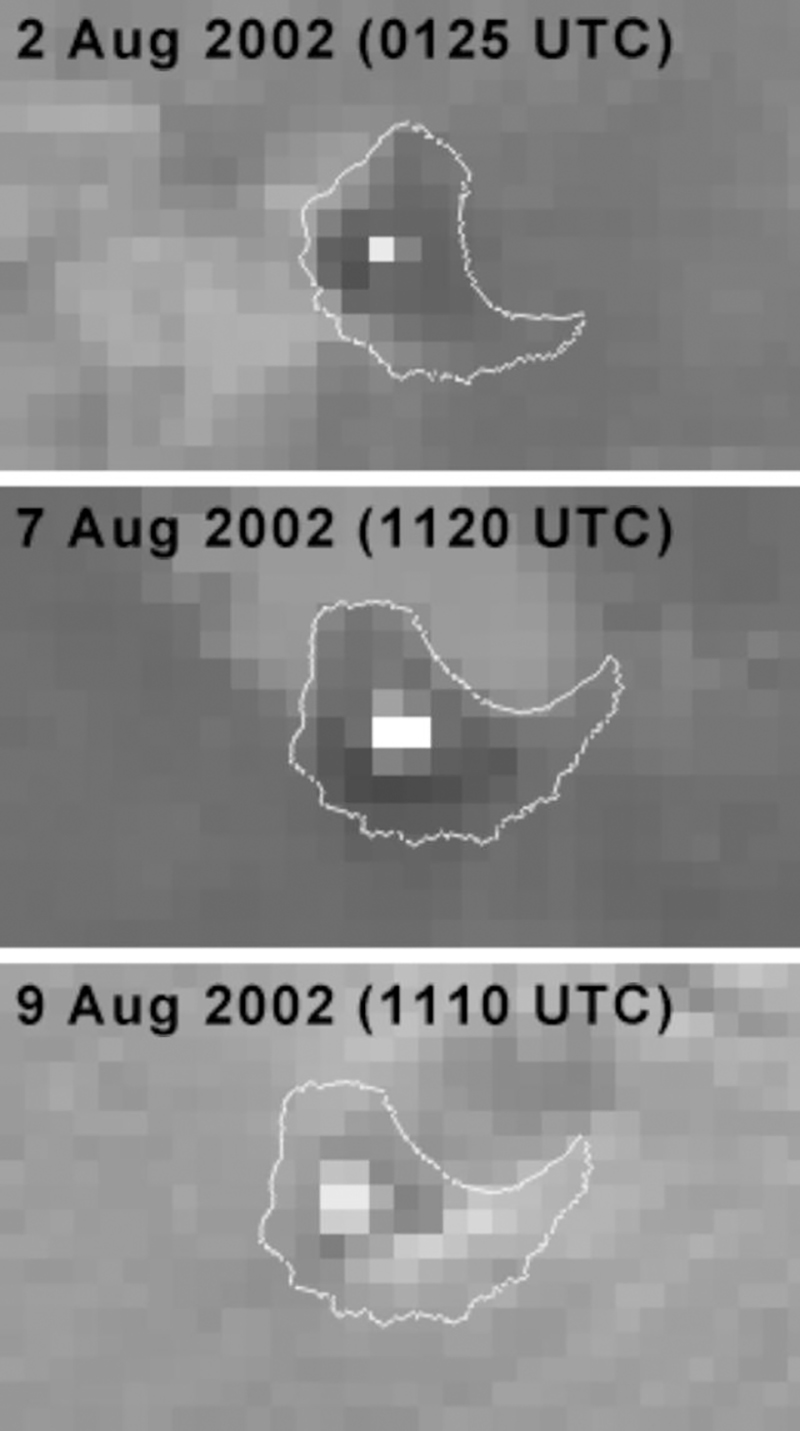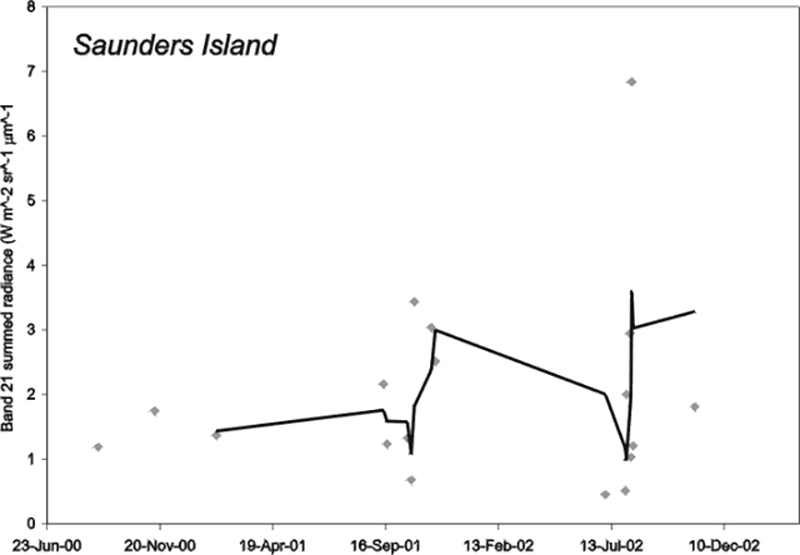Recently Published Bulletin Reports
Erebus (Antarctica) Lava lake remains active; most thermal alerts recorded since 2019
Rincon de la Vieja (Costa Rica) Frequent phreatic explosions during July-December 2023
Bezymianny (Russia) Explosion on 18 October 2023 sends ash plume 8 km high; lava flows and incandescent avalanches
Kilauea (United States) Low-level lava effusions in the lava lake at Halema’uma’u during July-December 2022
Nyamulagira (DR Congo) Lava flows and thermal activity during May-October 2023
Bagana (Papua New Guinea) Explosions, ash plumes, ashfall, and lava flows during April-September 2023
Mayon (Philippines) Lava flows, pyroclastic flows, ash emissions, and seismicity during April-September 2023
Nishinoshima (Japan) Eruption plumes and gas-and-steam plumes during May-August 2023
Krakatau (Indonesia) White gas-and-steam plumes and occasional ash plumes during May-August 2023
Villarrica (Chile) Strombolian activity, gas-and-ash emissions, and crater incandescence during April-September 2023
Merapi (Indonesia) Frequent incandescent avalanches during April-September 2023
Ebeko (Russia) Moderate explosive activity with ash plumes continued during June-November 2023
Erebus (Antarctica) — January 2024  Cite this Report
Cite this Report
Erebus
Antarctica
77.53°S, 167.17°E; summit elev. 3794 m
All times are local (unless otherwise noted)
Lava lake remains active; most thermal alerts recorded since 2019
The lava lake in the summit crater of Erebus has been active since at least 1972. Located in Antarctica overlooking the McMurdo Station on Ross Island, it is the southernmost active volcano on the planet. Because of the remote location, activity is primarily monitored by satellites. This report covers activity during 2023.
The number of thermal alerts recorded by the Hawai'i Institute of Geophysics and Planetology’s MODVOLC Thermal Alerts System increased considerably in 2023 compared to the years 2020-2022 (table 9). In contrast to previous years, the MODIS instruments aboard the Aqua and Terra satellites captured data from Erebus every month during 2023. Consistent with previous years, the lowest number of anomalous pixels were recorded in January, November, and December.
Table 9. Number of monthly MODIS-MODVOLC thermal alert pixels recorded at Erebus during 2017-2023. See BGVN 42:06 for data from 2000 through 2016. The table was compiled using data provided by the HIGP – MODVOLC Thermal Alerts System.
| Year |
Jan |
Feb |
Mar |
Apr |
May |
Jun |
Jul |
Aug |
Sep |
Oct |
Nov |
Dec |
SUM |
| 2017 |
0 |
21 |
9 |
0 |
0 |
1 |
11 |
61 |
76 |
52 |
0 |
3 |
234 |
| 2018 |
0 |
21 |
58 |
182 |
55 |
17 |
137 |
172 |
103 |
29 |
0 |
0 |
774 |
| 2019 |
2 |
21 |
162 |
151 |
55 |
56 |
75 |
53 |
29 |
19 |
1 |
0 |
624 |
| 2020 |
0 |
2 |
16 |
18 |
4 |
4 |
1 |
3 |
18 |
3 |
1 |
6 |
76 |
| 2021 |
0 |
9 |
1 |
0 |
2 |
56 |
46 |
47 |
35 |
52 |
5 |
3 |
256 |
| 2022 |
1 |
13 |
55 |
22 |
15 |
32 |
39 |
19 |
31 |
11 |
0 |
0 |
238 |
| 2023 |
2 |
33 |
49 |
82 |
41 |
32 |
70 |
64 |
42 |
17 |
5 |
11 |
448 |
Sentinel-2 infrared images showed one or two prominent heat sources within the summit crater, accompanied by adjacent smaller sources, similar to recent years (see BGVN 46:01, 47:02, and 48:01). A unique image was obtained on 25 November 2023 by the OLI-2 (Operational Land Imager-2) on Landsat 9, showing the upper part of the volcano surrounded by clouds (figure 32).
Geologic Background. Mount Erebus, the world's southernmost historically active volcano, overlooks the McMurdo research station on Ross Island. It is the largest of three major volcanoes forming the crudely triangular Ross Island. The summit of the dominantly phonolitic volcano has been modified by one or two generations of caldera formation. A summit plateau at about 3,200 m elevation marks the rim of the youngest caldera, which formed during the late-Pleistocene and within which the modern cone was constructed. An elliptical 500 x 600 m wide, 110-m-deep crater truncates the summit and contains an active lava lake within a 250-m-wide, 100-m-deep inner crater; other lava lakes are sometimes present. The glacier-covered volcano was erupting when first sighted by Captain James Ross in 1841. Continuous lava-lake activity with minor explosions, punctuated by occasional larger Strombolian explosions that eject bombs onto the crater rim, has been documented since 1972, but has probably been occurring for much of the volcano's recent history.
Information Contacts: Hawai'i Institute of Geophysics and Planetology (HIGP) - MODVOLC Thermal Alerts System, School of Ocean and Earth Science and Technology (SOEST), Univ. of Hawai'i, 2525 Correa Road, Honolulu, HI 96822, USA (URL: http://modis.higp.hawaii.edu/); Copernicus Browser, Copernicus Data Space Ecosystem, European Space Agency (URL: https://dataspace.copernicus.eu/browser/); NASA Earth Observatory, EOS Project Science Office, NASA Goddard Space Flight Center, Goddard, Maryland, USA (URL: https://earthobservatory.nasa.gov/images/152134/erebus-breaks-through).
Rincon de la Vieja (Costa Rica) — January 2024  Cite this Report
Cite this Report
Rincon de la Vieja
Costa Rica
10.83°N, 85.324°W; summit elev. 1916 m
All times are local (unless otherwise noted)
Frequent phreatic explosions during July-December 2023
Rincón de la Vieja is a volcanic complex in Costa Rica with a hot convecting acid lake that exhibits frequent weak phreatic explosions, gas-and-steam emissions, and occasional elevated sulfur dioxide levels (BGVN 45:10, 46:03, 46:11). The current eruption period began June 2021. This report covers activity during July-December 2023 and is based on weekly bulletins and occasional daily reports from the Observatorio Vulcanologico Sismologica de Costa Rica-Universidad Nacional (OVSICORI-UNA).
Numerous weak phreatic explosions continued during July-December 2023, along with gas-and-steam emissions and plumes that rose as high as 3 km above the crater rim. Many weekly OVSICORI-UNA bulletins included the previous week's number of explosions and emissions (table 9). For many explosions, the time of explosion was given (table 10). Frequent seismic activity (long-period earthquakes, volcano-tectonic earthquakes, and tremor) accompanied the phreatic activity.
Table 9. Number of reported weekly phreatic explosions and gas-and-steam emissions at Rincón de la Vieja, July-December 2023. Counts are reported for the week before the Weekly Bulletin date; not all reports included these data. Courtesy of OVSICORI-UNA.
| OVSICORI Weekly Bulletin |
Number of explosions |
Number of emissions |
| 28 Jul 2023 |
6 |
14 |
| 4 Aug 2023 |
10 |
12 |
| 1 Sep 2023 |
13 |
11 |
| 22 Sep 2023 |
12 |
13 |
| 29 Sep 2023 |
6 |
11 |
| 6 Oct 2023 |
12 |
5 |
| 13 Oct 2023 |
7 |
9 |
| 20 Oct 2023 |
1 |
15 |
| 27 Oct 2023 |
3 |
23 |
| 3 Nov 2023 |
3 |
10 |
| 17 Nov 2023 |
0 |
Some |
| 24 Nov 2023 |
0 |
14 |
| 8 Dec 2023 |
4 |
16 |
| 22 Dec 2023 |
8 |
18 |
Table 10. Summary of activity at Rincón de la Vieja during July-December 2023. Weak phreatic explosions and gas emissions are noted where the time of explosion was indicated in the weekly or daily bulletins. Height of plumes or emissions are distance above the crater rim. Courtesy of OVSICORI-UNA.
| Date |
Time |
Description of Activity |
| 1 Jul 2023 |
0156 |
Explosion. |
| 2 Jul 2023 |
0305 |
Explosion. |
| 4 Jul 2023 |
0229, 0635 |
Event at 0635 produced a gas-and-steam plume that rose 700 m and drifted W; seen by residents in Liberia (21 km SW). |
| 9 Jul 2023 |
1843 |
Explosion. |
| 21 Jul 2023 |
0705 |
Explosion. |
| 26 Jul 2023 |
1807 |
Explosion. |
| 28 Jul 2023 |
0802 |
Explosion generated a gas-and-steam plume that rose 500 m. |
| 30 Jul 2023 |
1250 |
Explosion. |
| 31 Jul 2023 |
2136 |
Explosion. |
| 11 Aug 2023 |
0828 |
Explosion. |
| 18 Aug 2023 |
1304 |
Explosion. |
| 21 Aug 2023 |
1224 |
Explosion generated gas-and-steam plumes rose 500-600 m. |
| 22 Aug 2023 |
0749 |
Explosion generated gas-and-steam plumes rose 500-600 m. |
| 24 Aug 2023 |
1900 |
Explosion. |
| 25 Aug 2023 |
0828 |
Event produced a steam-and-gas plume that rose 3 km and drifted NW. |
| 27-28 Aug 2023 |
0813 |
Four small events; the event at 0813 on 28 August lasted two minutes and generated a steam-and-gas plume that rose 2.5 km. |
| 1 Sep 2023 |
1526 |
Explosion generated plume that rose 2 km and ejected material onto the flanks. |
| 2-3 Sep 2023 |
- |
Small explosions detected in infrasound data. |
| 4 Sep 2023 |
1251 |
Gas-and-steam plume rose 1 km and drifted W. |
| 7 Nov 2023 |
1113 |
Explosion. |
| 8 Nov 2023 |
0722 |
Explosion. |
| 12 Nov 2023 |
0136 |
Small gas emissions. |
| 14 Nov 2023 |
0415 |
Small gas emissions. |
According to OVSICORI-UNA, during July-October the average weekly sulfur dioxide (SO2) flux ranged from 68 to 240 tonnes/day. However, in mid-November the flux increased to as high as 334 tonnes/day, the highest value measured in recent years. The high SO2 flux in mid-November was also detected by the TROPOMI instrument on the Sentinel-5P satellite (figure 43).
Geologic Background. Rincón de la Vieja, the largest volcano in NW Costa Rica, is a remote volcanic complex in the Guanacaste Range. The volcano consists of an elongated, arcuate NW-SE-trending ridge constructed within the 15-km-wide early Pleistocene Guachipelín caldera, whose rim is exposed on the south side. Sometimes known as the "Colossus of Guanacaste," it has an estimated volume of 130 km3 and contains at least nine major eruptive centers. Activity has migrated to the SE, where the youngest-looking craters are located. The twin cone of Santa María volcano, the highest peak of the complex, is located at the eastern end of a smaller, 5-km-wide caldera and has a 500-m-wide crater. A Plinian eruption producing the 0.25 km3 Río Blanca tephra about 3,500 years ago was the last major magmatic eruption. All subsequent eruptions, including numerous historical eruptions possibly dating back to the 16th century, have been from the prominent active crater containing a 500-m-wide acid lake located ENE of Von Seebach crater.
Information Contacts: Observatorio Vulcanológico Sismológica de Costa Rica-Universidad Nacional (OVSICORI-UNA), Apartado 86-3000, Heredia, Costa Rica (URL: http://www.ovsicori.una.ac.cr/); NASA Global Sulfur Dioxide Monitoring Page, Atmospheric Chemistry and Dynamics Laboratory, NASA Goddard Space Flight Center (NASA/GSFC), 8800 Greenbelt Road, Goddard MD 20771, USA (URL: https://so2.gsfc.nasa.gov/).
Bezymianny (Russia) — November 2023  Cite this Report
Cite this Report
Bezymianny
Russia
55.972°N, 160.595°E; summit elev. 2882 m
All times are local (unless otherwise noted)
Explosion on 18 October 2023 sends ash plume 8 km high; lava flows and incandescent avalanches
Bezymianny, located on Russia’s Kamchatka Peninsula, has had eruptions since 1955 characterized by dome growth, explosions, pyroclastic flows, ash plumes, and ashfall. Activity during November 2022-April 2023 included gas-and-steam emissions, lava dome collapses generating avalanches, and persistent thermal activity. Similar eruptive activity continued from May through October 2023, described here based on information from weekly and daily reports of the Kamchatka Volcano Eruptions Response Team (KVERT), notices from Tokyo VAAC (Volcanic Ash Advisory Center), and from satellite data.
Overall activity decreased after the strong period of activity in late March through April 2023, which included ash explosions during 29 March and 7-8 April 2023 that sent plumes as high as 10-12 km altitude, along with dome growth and lava flows (BGVN 48:05). This reduced activity can be seen in the MIROVA thermal detection system graph (figure 56), which was consistent with data from the MODVOLC thermal detection system and with Sentinel-2 satellite images that showed persistent hotspots in the summit crater when conditions allowed observations. A renewed period of strong activity began in mid-October 2023.
Activity increased significantly on 17 October 2023 when large collapses began during 0700-0830 on the E flanks of the lava dome and continued to after 0930 the next day (figure 57). Ash plumes rose to an altitude of 4.5-5 km, extending 220 km NNE by 18 October. A large explosion at 1630 on 18 October produced an ash plume that rose to an altitude of 11 km (8 km above the summit) and drifted NNE and then NW, extending 900 km NW within two days at an altitude of 8 km. Minor ashfall was noted in Kozyrevsk (45 km WNW). At 0820 on 20 October an ash plume was identified in satellite images drifting 100 km ENE at altitudes of 4-4.5 km.
Lava flows and hot avalanches from the dome down the SE flank continued over the next few days, including 23 October when clear conditions allowed good observations (figures 58 and 59). A large thermal anomaly was observed over the volcano through 24 October, and in the summit crater on 30 October (figure 60). Strong fumarolic activity continued, with numerous avalanches and occasional incandescence. By the last week of October, volcanic activity had decreased to a level consistent with that earlier in the reporting period.
Aviation warnings were frequently updated during 17-20 October. KVERT issued a Volcano Observatory Notice for Aviation (VONA) on 17 October at 1419 and 1727 (0219 and 0527 UTC) raising the Aviation Color Code (ACC) from Yellow to Orange (second highest level). The next day, KVERT issued a VONA at 1705 (0505 UTC) raising the ACC to Red (highest level) but lowered it back to Orange at 2117 (0917 UTC). After another decrease to Yellow and back to Orange, the ACC was reduced to Yellow on 20 October at 1204 (0004 UTC). In addition, the Tokyo VAAC issued a series of Volcanic Ash Advisories beginning on 16 October and continuing through 30 October.
Geologic Background. The modern Bezymianny, much smaller than its massive neighbors Kamen and Kliuchevskoi on the Kamchatka Peninsula, was formed about 4,700 years ago over a late-Pleistocene lava-dome complex and an edifice built about 11,000-7,000 years ago. Three periods of intensified activity have occurred during the past 3,000 years. The latest period, which was preceded by a 1,000-year quiescence, began with the dramatic 1955-56 eruption. This eruption, similar to that of St. Helens in 1980, produced a large open crater that was formed by collapse of the summit and an associated lateral blast. Subsequent episodic but ongoing lava-dome growth, accompanied by intermittent explosive activity and pyroclastic flows, has largely filled the 1956 crater.
Information Contacts: Kamchatka Volcanic Eruptions Response Team (KVERT), Far Eastern Branch, Russian Academy of Sciences, 9 Piip Blvd., Petropavlovsk-Kamchatsky, 683006, Russia (URL: http://www.kscnet.ru/ivs/kvert/); Kamchatka Volcanological Station, Kamchatka Branch of Geophysical Survey, (KB GS RAS), Klyuchi, Kamchatka Krai, Russia (URL: http://volkstat.ru/); Tokyo Volcanic Ash Advisory Center (VAAC), 1-3-4 Otemachi, Chiyoda-ku, Tokyo 100-8122, Japan (URL: http://ds.data.jma.go.jp/svd/vaac/data/); Hawai'i Institute of Geophysics and Planetology (HIGP) - MODVOLC Thermal Alerts System, School of Ocean and Earth Science and Technology (SOEST), Univ. of Hawai'i, 2525 Correa Road, Honolulu, HI 96822, USA (URL: http://modis.higp.hawaii.edu/); MIROVA (Middle InfraRed Observation of Volcanic Activity), a collaborative project between the Universities of Turin and Florence (Italy) supported by the Centre for Volcanic Risk of the Italian Civil Protection Department (URL: http://www.mirovaweb.it/); Copernicus Browser, Copernicus Data Space Ecosystem, European Space Agency (URL: https://dataspace.copernicus.eu/browser/).chr
Kilauea (United States) — January 2023  Cite this Report
Cite this Report
Kilauea
United States
19.421°N, 155.287°W; summit elev. 1222 m
All times are local (unless otherwise noted)
Low-level lava effusions in the lava lake at Halema’uma’u during July-December 2022
Kīlauea is the southeastern-most volcano in Hawaii and overlaps the E flank of the Mauna Loa volcano. Its East Rift Zone (ERZ) has been intermittently active for at least 2,000 years. An extended eruption period began in January 1983 and was characterized by open lava lakes and lava flows from the summit caldera and the East Rift Zone. During May 2018 magma migrated into the Lower East Rift Zone (LERZ) and opened 24 fissures along a 6-km-long NE-trending fracture zone that produced lava flows traveling in multiple directions. As lava emerged from the fissures, the lava lake at Halema'uma'u drained and explosions sent ash plumes to several kilometers altitude (BGVN 43:10).
The current eruption period started during September 2021 and has recently been characterized by lava effusions, spatter, and sulfur dioxide emissions in the active Halema’uma’u lava lake (BGVN 47:08). Lava effusions, some spatter, and sulfur dioxide emissions have continued during this reporting period of July through December 2022 using daily reports, volcanic activity notices, and abundant photo, map, and video data from the US Geological Survey's (USGS) Hawaiian Volcano Observatory (HVO).
Summary of activity during July-December 2022. Low-level effusions have continued at the western vent of the Halema’uma’u crater during July through early December 2022. Occasional weak ooze-outs (also called lava break outs) would occur along the margins of the crater floor. The overall level of the active lava lake throughout the reporting period gradually increased due to infilling, however it stagnated in mid-September (table 13). During September through November, activity began to decline, though lava effusions persisted at the western vent. By 9 December, the active part of the lava lake had completely crusted over, and incandescence was no longer visible.
Table 13. Summary of measurements taken during overflights at Kīlauea that show a gradual increase in the active lava lake level and the volume of lava effused since 29 September 2021. Lower activity was reported during September-October. Data collected during July-December 2022. Courtesy of HVO.
| Date: |
Level of the active lava lake (m): |
Cumulative volume of lava effused (million cubic meters): |
| 7 Jul 2022 |
130 |
95 |
| 19 Jul 2022 |
133 |
98 |
| 4 Aug 2022 |
136 |
102 |
| 16 Aug 2022 |
137 |
104 |
| 12 Sep 2022 |
143 |
111 |
| 5 Oct 2022 |
143 |
111 |
| 28 Oct 2022 |
143 |
111 |
Activity during July 2022. Lava effusions were reported from the western vent in the Halema’uma’u crater, along with occasional weak ooze-outs along the margins of the crater floor. The height of the lava lake was variable due to deflation-inflation tilt events; for example, the lake level dropped approximately 3-4 m during a summit deflation-inflation event reported on 1 July. Webcam images taken during the night of 6-12 July showed intermittent low-level spattering at the western vent that rose less than 10 m above the vent (figure 519). Measurements made during an overflight on 7 July indicated that the crater floor was infilled about 130 m and that 95 million cubic meters of lava had been effused since 29 September 2021. A single, relatively small lava ooze-out was active to the S of the lava lake. Around midnight on 8 July there were two brief periods of lava overflow onto the lake margins. On 9 July lava ooze-outs were reported near the SE and NE edges of the crater floor and during 10-11 July they occurred near the E, NE, and NW edges. On 16 July crater incandescence was reported, though the ooze-outs and spattering were not visible. On 18 July overnight webcam images showed incandescence in the western vent complex and two ooze-outs were reported around 0000 and 0200 on 19 July. By 0900 there were active ooze-outs along the SW edge of the crater floor. Measurements made from an overflight on 19 July indicated that the crater floor was infilled about 133 m and 98 million cubic meters of lava had erupted since 29 September 2021 (figure 520). On 20 July around 1600 active ooze-outs were visible along the N edge of the crater, which continued through the next day. Extensive ooze-outs occurred along the W margin during 24 July until 1900; on 26 July minor ooze-outs were noted along the N margin. Minor spattering was visible on 29 July along the E margin of the lake. The sulfur dioxide emission rates ranged 650-2,800 tons per day (t/d), the higher of which was measured on 8 July (figure 519).
Activity during August 2022. The eruption continued in the Halema’uma’u crater at the western vent. According to HVO the lava in the active lake remained at the level of the bounding levees. Occasional minor ooze-outs were observed along the margins of the crater floor. Strong nighttime crater incandescence was visible after midnight on 6 August over the western vent cone. During 6-7 August scattered small lava lobes were active along the crater floor and incandescence persisted above the western vent through 9 August. During 7-9 August HVO reported a single lava effusion source was active along the NW margin of the crater floor. Measurements from an overflight on 4 August indicated that the crater floor was infilled about 136 m total and that 102 million cubic meters of lava had been erupted since the start of the eruption. Lava breakouts were reported along the N, NE, E, S, and W margins of the crater during 10-16 August. Another overflight survey conducted on 16 August indicated that the crater floor infilled about 137 m and 104 million cubic meters of lava had been erupted since September 2021. Measured sulfur dioxide emissions rates ranged 1,150-2,450 t/d, the higher of which occurred on 8 August.
Activity during September 2022. During September, lava effusion continued from the western vent into the active lava lake and onto the crater floor. Intermittent minor ooze-outs were reported through the month. A small ooze-out was visible on the W crater floor margin at 0220 on 2 September, which showed decreasing surface activity throughout the day, but remained active through 3 September. On 3 September around 1900 a lava outbreak occurred along the NW margin of the crater floor but had stopped by the evening of 4 September. Field crews monitoring the summit lava lake on 9 September observed spattering on the NE margin of the lake that rose no higher than 10 m, before falling back onto the lava lake crust (figure 521). Overflight measurements on 12 September indicated that the crater floor was infilled a total of 143 m and 111 million cubic meters of lava had been erupted since September 2021. Extensive breakouts in the W and N part of the crater floor were reported at 1600 on 20 September and continued into 26 September. The active part of the lava lake dropped by 10 m while other parts of the crater floor dropped by several meters. Summit tiltmeters recorded a summit seismic swarm of more than 80 earthquakes during 1500-1800 on 21 September, which occurred about 1.5 km below Halema’uma’u; a majority of these were less than Mw 2. By 22 September the active part of the lava lake was infilled about 2 m. On 23 September the western vent areas exhibited several small spatter cones with incandescent openings, along with weak, sporadic spattering (figure 522). The sulfur dioxide emission rate ranged from 930 t/d to 2,000 t/d, the higher of which was measured on 6 September.
Activity during October 2022. Activity during October declined slightly compared to previous months, though lava effusions persisted from the western vent into the active lava lake and onto the crater floor during October (figure 523). Slight variations in the lava lake were noted throughout the month. HVO reported that around 0600 on 3 October the level of the lava lake has lowered slightly. Overflight measurements taken on 5 October indicated that the crater floor was infilled a total of about 143 m and that 111 million cubic meters of lava had been effused since September 2021. During 6-7 October the lake gradually rose 0.5 m. Sulfur dioxide measurements made on 22 October had an emission rate of 700 t/d. Another overflight taken on 28 October showed that there was little to no change in the elevation of the crater floor: the crater floor was infilled a total of 143 m and 111 million cubic meters of lava had erupted since the start of the eruption.
Activity during November 2022. Activity remained low during November, though HVO reported that lava from the western vent continued to effuse into the active lava lake and onto the crater floor throughout the month. The rate of sulfur dioxide emissions during November ranged from 300-600 t/d, the higher amount of which occurred on 9 November.
Activity during December 2022. Similar low activity was reported during December, with lava effusing from the western vent into the active lava lake and onto the crater floor. During 4-5 December the active part of the lava lake was slightly variable in elevation and fluctuated within 1 m. On 9 December HVO reported that lava was no longer erupting from the western vent in the Halema’uma’u crater and that sulfur dioxide emissions had returned to near pre-eruption background levels; during 10-11 December, the lava lake had completely crusted over, and no incandescence was visible (figure 524). Time lapse camera images covering the 4-10 December showed that the crater floor showed weak deflation and no inflation. Some passive events of crustal overturning were reported during 14-15 December, which brought fresh incandescent lava to the lake surface. The sulfur dioxide emission rate was approximately 200 t/d on 14 December. A smaller overturn event on 17 December and another that occurred around 0000 and into the morning of 20 December were also detected. A small seismic swarm was later detected on 30 December.
Geologic Background. Kilauea overlaps the E flank of the massive Mauna Loa shield volcano in the island of Hawaii. Eruptions are prominent in Polynesian legends; written documentation since 1820 records frequent summit and flank lava flow eruptions interspersed with periods of long-term lava lake activity at Halemaumau crater in the summit caldera until 1924. The 3 x 5 km caldera was formed in several stages about 1,500 years ago and during the 18th century; eruptions have also originated from the lengthy East and Southwest rift zones, which extend to the ocean in both directions. About 90% of the surface of the basaltic shield volcano is formed of lava flows less than about 1,100 years old; 70% of the surface is younger than 600 years. The long-term eruption from the East rift zone between 1983 and 2018 produced lava flows covering more than 100 km2, destroyed hundreds of houses, and added new coastline.
Information Contacts: Hawaiian Volcano Observatory (HVO), U.S. Geological Survey, PO Box 51, Hawai'i National Park, HI 96718, USA (URL: http://hvo.wr.usgs.gov/).
Nyamulagira (DR Congo) — November 2023  Cite this Report
Cite this Report
Nyamulagira
DR Congo
1.408°S, 29.2°E; summit elev. 3058 m
All times are local (unless otherwise noted)
Lava flows and thermal activity during May-October 2023
Nyamulagira (also known as Nyamuragira) is a shield volcano in the Democratic Republic of Congo with the summit truncated by a small 2 x 2.3 km caldera with walls up to about 100 m high. Documented eruptions have occurred within the summit caldera, as well as from numerous flank fissures and cinder cones. The current eruption period began in April 2018 and has more recently been characterized by summit crater lava flows and thermal activity (BGVN 48:05). This report describes lava flows and variable thermal activity during May through October 2023, based on information from the Observatoire Volcanologique de Goma (OVG) and various satellite data.
Lava lake activity continued during May. The MIROVA (Middle InfraRed Observation of Volcanic Activity) system recorded moderate-to-strong thermal activity throughout the reporting period; activity was more intense during May and October and relatively weaker from June through September (figure 95). The MODVOLC thermal algorithm, detected a total of 209 thermal alerts. There were 143 hotspots detected during May, eight during June, nine during September, and 49 during October. This activity was also reflected in infrared satellite images, where a lava flow was visible in the NW part of the crater on 7 May and strong activity was seen in the center of the crater on 4 October (figure 96). Another infrared satellite image taken on 12 May showed still active lava flows along the NW margin of the crater. According to OVG lava effusions were active during 7-29 May and moved to the N and NW parts of the crater beginning on 9 May. Strong summit crater incandescence was visible from Goma (27 km S) during the nights of 17, 19, and 20 May (figure 97). On 17 May there was an increase in eruptive activity, which peaked at 0100 on 20 May. Notable sulfur dioxide plumes drifted NW and W during 19-20 May (figure 98). Drone footage acquired in partnership with the USGS (United States Geological Survey) on 20 May captured images of narrow lava flows that traveled about 100 m down the W flank (figure 99). Data from the Rumangabo seismic station indicated a decreasing trend in activity during 17-21 May. Although weather clouds prevented clear views of the summit, a strong thermal signature on the NW flank was visible in an infrared satellite image on 22 May, based on an infrared satellite image. On 28 May the lava flows on the upper W flank began to cool and solidify. By 29 May seismicity returned to levels similar to those recorded before the 17 May increase. Lava effusion continued but was confined to the summit crater; periodic crater incandescence was observed.
Low-level activity was noted during June through October. On 1 June OVG reported that seismicity remained at lower levels and that crater incandescence had been absent for three days, though infrared satellite imagery showed continued lava effusion in the summit crater. The lava flows on the flanks covered an estimated 0.6 km2. Satellite imagery continued to show thermal activity confined to the lava lake through October (figure 96), although no lava flows or significant sulfur dioxide emissions were reported.
Geologic Background. Africa's most active volcano, Nyamulagira (also known as Nyamuragira), is a massive high-potassium basaltic shield about 25 km N of Lake Kivu and 13 km NNW of the steep-sided Nyiragongo volcano. The summit is truncated by a small 2 x 2.3 km caldera that has walls up to about 100 m high. Documented eruptions have occurred within the summit caldera, as well as from the numerous flank fissures and cinder cones. A lava lake in the summit crater, active since at least 1921, drained in 1938, at the time of a major flank eruption. Recent lava flows extend down the flanks more than 30 km from the summit as far as Lake Kivu; extensive lava flows from this volcano have covered 1,500 km2 of the western branch of the East African Rift.
Information Contacts: Observatoire Volcanologique de Goma (OVG), Departement de Geophysique, Centre de Recherche en Sciences Naturelles, Lwiro, D.S. Bukavu, DR Congo; Hawai'i Institute of Geophysics and Planetology (HIGP) - MODVOLC Thermal Alerts System, School of Ocean and Earth Science and Technology (SOEST), Univ. of Hawai'i, 2525 Correa Road, Honolulu, HI 96822, USA (URL: http://modis.higp.hawaii.edu/); MIROVA (Middle InfraRed Observation of Volcanic Activity), a collaborative project between the Universities of Turin and Florence (Italy) supported by the Centre for Volcanic Risk of the Italian Civil Protection Department (URL: http://www.mirovaweb.it/); NASA Global Sulfur Dioxide Monitoring Page, Atmospheric Chemistry and Dynamics Laboratory, NASA Goddard Space Flight Center (NASA/GSFC), 8800 Greenbelt Road, Goddard, Maryland, USA (URL: https://so2.gsfc.nasa.gov/); Copernicus Browser, Copernicus Data Space Ecosystem, European Space Agency (URL: https://dataspace.copernicus.eu/browser/); Charles Balagizi, Goma Volcano Observatory, Departement de Geophysique, Centre de Recherche en Sciences Naturelles, Lwiro, D.S. Bukavu, DR Congo.
Bagana (Papua New Guinea) — October 2023  Cite this Report
Cite this Report
Bagana
Papua New Guinea
6.137°S, 155.196°E; summit elev. 1855 m
All times are local (unless otherwise noted)
Explosions, ash plumes, ashfall, and lava flows during April-September 2023
The remote volcano of Bagana is located in central Bougainville Island, Papua New Guinea. Recorded eruptions date back to 1842 and activity has consisted of effusive activity that has built a small lava dome in the summit crater and occasional explosions that produced pyroclastic flows. The most recent eruption has been ongoing since February 2000 and has produced occasional explosions, ash plumes, and lava flows. More recently, activity has been characterized by ongoing effusive activity and ash emissions (BGVN 48:04). This report updates activity from April through September 2023 that has consisted of explosions, ash plumes, ashfall, and lava flows, using information from the Darwin Volcanic Ash Advisory Center (VAAC) and satellite data.
An explosive eruption was reported on 7 July that generated a large gas-and-ash plume to high altitudes and caused significant ashfall in local communities; the eruption plume had reached upper tropospheric (16-18 km altitude) altitudes by 2200, according to satellite images. Sulfur dioxide plumes were detected in satellite images on 8 July and indicated that the plume was likely a mixture of gas, ice, and ash. A report issued by the Autonomous Bougainville Government (ABG) (Torokina District, Education Section) on 10 July noted that significant ash began falling during 2000-2100 on 7 July and covered most areas in the Vuakovi, Gotana (9 km SW), Koromaketo, Laruma (25 km W) and Atsilima (27 km NW) villages. Pyroclastic flows also occurred, according to ground-based reports; small deposits confined to one drainage were inspected by RVO during an overflight on 17 July and were confirmed to be from the 7 July event. Ashfall continued until 10 July and covered vegetation, which destroyed bushes and gardens and contaminated rivers and streams.
RVO reported another eruption on 14 July. The Darwin VAAC stated that an explosive event started around 0830 on 15 July and produced an ash plume that rose to 16.5 km altitude by 1000 and drifted N, according to satellite images. The plume continued to drift N and remained visible through 1900, and by 2150 it had dissipated.
Ashfall likely from both the 7 and 15 July events impacted about 8,111 people in Torokina (20 km SW), including Tsito/Vuakovi, Gotana, Koromaketo, Kenaia, Longkogari, Kenbaki, Piva (13 km SW), and Atsinima, and in the Tsitovi district, according to ABG. Significant ashfall was also reported in Ruruvu (22 km N) in the Wakunai District of Central Bougainville, though the thickness of these deposits could not be confirmed. An evacuation was called for the villages in Wakunai, where heavy ashfall had contaminated water sources; the communities of Ruruvu, Togarau, Kakarapaia, Karauturi, Atao, and Kuritaturi were asked to evacuate to a disaster center at the Wakunai District Station, and communities in Torokina were asked to evacuate to the Piva District station. According to a news article, more than 7,000 people needed temporary accommodations, with about 1,000 people in evacuation shelters. Ashfall had deposited over a broad area, contaminating water supplies, affecting crops, and collapsing some roofs and houses in rural areas. Schools were temporarily shut down. Intermittent ash emissions continued through the end of July and drifted NNW, NW, and SW. Fine ashfall was reported on the coast of Torokina, and ash plumes also drifted toward Laruma and Atsilima.
A small explosive eruption occurred at 2130 on 28 July that ejected material from the crater vents, according to reports from Torokina, in addition to a lava flow that contained two lobes. A second explosion was detected at 2157. Incandescence from the lava flow was visible from Piva as it descended the W flank around 2000 on 29 July (figure 47). The Darwin VAAC reported that a strong thermal anomaly was visible in satellite images during 30-31 July and that ash emissions rose to 2.4 km altitude and drifted WSW on 30 July. A ground report from RVO described localized emissions at 0900 on 31 July.
The Darwin VAAC reported that ash plumes were identified in satellite imagery at 0800 and 1220 on 12 August and rose to 2.1 km and 3 km altitude and drifted NW and W, respectively. A news report stated that aid was sent to more than 6,300 people that were adversely affected by the eruption. Photos taken during 17-19 August showed ash emissions rising no higher than 1 km above the summit and drifting SE. A small explosion generated an ash plume during the morning of 19 August. Deposits from small pyroclastic flows were also captured in the photos. Satellite images captured lava flows and pyroclastic flow deposits. Two temporary seismic stations were installed near Bagana on 17 August at distances of 7 km WSW (Vakovi station) and 11 km SW (Kepox station). The Kepox station immediately started to record continuous, low-frequency background seismicity.
Satellite data. Little to no thermal activity was detected during April through mid-July 2023; only one anomaly was recorded during early April and one during early June, according to MIROVA (Middle InfraRed Observation of Volcanic Activity) data (figure 48). Thermal activity increased in both power and frequency during mid-July through September, although there were still some short gaps in detected activity. MODVOLC also detected increased thermal activity during August; thermal hotspots were detected a total of five times on 19, 20, and 27 August. Weak thermal anomalies were also captured in infrared satellite images on clear weather days throughout the reporting period on 7, 12, and 17 April, 27 May, 1, 6, 16, and 31 July, and 19 September (figure 48); a strong thermal anomaly was visible on 31 July. Distinct sulfur dioxide plumes that drifted generally NW were intermittently captured by the TROPOMI instrument on the Sentinel-5P satellite and sometimes exceeded two Dobson Units (DUs) (figure 49).
Geologic Background. Bagana volcano, in a remote portion of central Bougainville Island, is frequently active. This massive symmetrical cone was largely constructed by an accumulation of viscous andesitic lava flows. The entire edifice could have been constructed in about 300 years at its present rate of lava production. Eruptive activity is characterized by non-explosive effusion of viscous lava that maintains a small lava dome in the summit crater, although occasional explosive activity produces pyroclastic flows. Lava flows with tongue-shaped lobes up to 50 m thick and prominent levees descend the flanks on all sides.
Information Contacts: Rabaul Volcano Observatory (RVO), Geohazards Management Division, Department of Mineral Policy and Geohazards Management (DMPGM), PO Box 3386, Kokopo, East New Britain Province, Papua New Guinea; Darwin Volcanic Ash Advisory Centre (VAAC), Bureau of Meteorology, Northern Territory Regional Office, PO Box 40050, Casuarina, NT 0811, Australia (URL: http://www.bom.gov.au/info/vaac/); MIROVA (Middle InfraRed Observation of Volcanic Activity), a collaborative project between the Universities of Turin and Florence (Italy) supported by the Centre for Volcanic Risk of the Italian Civil Protection Department (URL: http://www.mirovaweb.it/); Hawai'i Institute of Geophysics and Planetology (HIGP) - MODVOLC Thermal Alerts System, School of Ocean and Earth Science and Technology (SOEST), Univ. of Hawai'i, 2525 Correa Road, Honolulu, HI 96822, USA (URL: http://modis.higp.hawaii.edu/); NASA Global Sulfur Dioxide Monitoring Page, Atmospheric Chemistry and Dynamics Laboratory, NASA Goddard Space Flight Center (NASA/GSFC), 8800 Greenbelt Road, Goddard, Maryland, USA (URL: https://so2.gsfc.nasa.gov/); Copernicus Browser, Copernicus Data Space Ecosystem, European Space Agency (URL: https://dataspace.copernicus.eu/browser/); Autonomous Bougainville Government, P.O Box 322, Buka, AROB, PNG (URL: https://abg.gov.pg/); Andrew Tupper (Twitter: @andrewcraigtupp); Simon Carn, Geological and Mining Engineering and Sciences, Michigan Technological University, 1400 Townsend Drive, Houghton, MI 49931, USA (URL: http://www.volcarno.com/, Twitter: @simoncarn); Radio NZ (URL: https://www.rnz.co.nz/news/pacific/494464/more-than-7-000-people-in-bougainville-need-temporary-accommodation-after-eruption); USAID, 1300 Pennsylvania Ave, NW, Washington DC 20004, USA (URL: https://www.usaid.gov/pacific-islands/press-releases/aug-08-2023-united-states-provides-immediate-emergency-assistance-support-communities-affected-mount-bagana-volcanic-eruptions).
Mayon (Philippines) — October 2023  Cite this Report
Cite this Report
Mayon
Philippines
13.257°N, 123.685°E; summit elev. 2462 m
All times are local (unless otherwise noted)
Lava flows, pyroclastic flows, ash emissions, and seismicity during April-September 2023
Mayon is located in the Philippines and has steep upper slopes capped by a small summit crater. Historical eruptions date back to 1616 CE that have been characterized by Strombolian eruptions, lava flows, pyroclastic flows, and mudflows. Eruptions mostly originated from a central conduit. Pyroclastic flows and mudflows have commonly descended many of the approximately 40 drainages that surround the volcano. The most recent eruption occurred during June through October 2022 and consisted of lava dome growth and gas-and-steam emissions (BGVN 47:12). A new eruption was reported during late April 2023 and has included lava flows, pyroclastic density currents, ash emissions, and seismicity. This report covers activity during April through September 2023 based on daily bulletins from the Philippine Institute of Volcanology and Seismology (PHIVOLCS).
During April through September 2023, PHIVOLCS reported near-daily rockfall events, frequent volcanic earthquakes, and sulfur dioxide measurements. Gas-and-steam emissions rose 100-900 m above the crater and drifted in different directions. Nighttime crater incandescence was often visible during clear weather and was accompanied by incandescent avalanches of material. Activity notably increased during June when lava flows were reported on the S, SE, and E flanks (figure 52). The MIROVA graph (Middle InfraRed Observation of Volcanic Activity) showed strong thermal activity coincident with these lava flows, which remained active through September (figure 53). According to the MODVOLC thermal algorithm, a total of 110 thermal alerts were detected during the reporting period: 17 during June, 40 during July, 27 during August, and 26 during September. During early June, pyroclastic density currents (PDCs) started to occur more frequently.
Low activity was reported during much of April and May; gas-and-steam emissions rose 100-900 m above the crater and generally drifted in different directions. A total of 52 rockfall events and 18 volcanic earthquakes were detected during April and 147 rockfall events and 13 volcanic events during May. Sulfur dioxide flux measurements ranged between 400-576 tons per day (t/d) during April, the latter of which was measured on 29 April and between 162-343 t/d during May, the latter of which was measured on 13 May.
Activity during June increased, characterized by lava flows, pyroclastic density currents (PDCs), crater incandescence and incandescent rockfall events, gas-and-steam emissions, and continued seismicity. Weather clouds often prevented clear views of the summit, but during clear days, moderate gas-and-steam emissions rose 100-2,500 m above the crater and drifted in multiple directions. A total of 6,237 rockfall events and 288 volcanic earthquakes were detected. The rockfall events often deposited material on the S and SE flanks within 700-1,500 m of the summit crater and ash from the events drifted SW, S, SE, NE, and E. Sulfur dioxide emissions ranged between 149-1,205 t/d, the latter of which was measured on 10 June. Short-term observations from EDM and electronic tiltmeter monitoring indicated that the upper slopes were inflating since February 2023. Longer-term ground deformation parameters based on EDM, precise leveling, continuous GPS, and electronic tilt monitoring indicated that the volcano remained inflated, especially on the NW and SE flanks. At 1000 on 5 June the Volcano Alert Level (VAL) was raised to 2 (on a 0-5 scale). PHIVOLCS noted that although low-level volcanic earthquakes, ground deformation, and volcanic gas emissions indicated unrest, the steep increase in rockfall frequency may indicate increased dome activity.
A total of 151 dome-collapse PDCs occurred during 8-9 and 11-30 June, traveled 500-2,000 m, and deposited material on the S flank within 2 km of the summit crater. During 8-9 June the VAL was raised to 3. At approximately 1947 on 11 June lava flow activity was reported; two lobes traveled within 500 m from the crater and deposited material on the S (Mi-isi), SE (Bonga), and E (Basud) flanks. Weak seismicity accompanied the lava flow and slight inflation on the upper flanks. This lava flow remained active through 30 June, moving down the S and SE flank as far as 2.5 km and 1.8 km, respectively and depositing material up to 3.3 km from the crater. During 15-16 June traces of ashfall from the PDCs were reported in Sitio Buga, Nabonton, City of Ligao and Purok, and San Francisco, Municipality of Guinobatan. During 28-29 June there were two PDCs generated by the collapse of the lava flow front, which generated a light-brown ash plume 1 km high. Satellite monitors detected significant concentrations of sulfur dioxide beginning on 29 June. On 30 June PDCs primarily affected the Basud Gully on the E flank, the largest of which occurred at 1301 and lasted eight minutes, based on the seismic record. Four PDCs generated between 1800 and 2000 that lasted approximately four minutes each traveled 3-4 km on the E flank and generated an ash plume that rose 1 km above the crater and drifted N and NW. Ashfall was recorded in Tabaco City.
Similar strong activity continued during July; slow lava effusion remained active on the S and SE flanks and traveled as far as 2.8 km and 2.8 km, respectively and material was deposited as far as 4 km from the crater. There was a total of 6,983 rockfall events and 189 PDCs that affected the S, SE, and E flanks. The volcano network detected a total of 2,124 volcanic earthquakes. Continuous gas-and-steam emissions rose 200-2,000 m above the crater and drifted in multiple directions. Sulfur dioxide emissions averaged 792-4,113 t/d, the latter of which was measured on 28 July. During 2-4 July three PDCs were generated from the collapse of the lava flow and resulting light brown plumes rose 200-300 m above the crater. Continuous tremor pulses were reported beginning at 1547 on 3 July through 7 July at 1200, at 2300 on 8 July and going through 0300 on 10 July, and at 2300 on 16 July, as recorded by the seismic network. During 6-9 July there were 10 lava flow-collapse-related PDCs that generated light brown plumes 300-500 m above the crater. During 10-11 July light ashfall was reported in some areas of Mabinit, Legazpi City, Budiao and Salvacion, Daraga, and Camalig, Albay. By 18 July the lava flow advanced 600 m on the E flank as well.
During 1733 on 18 July and 0434 on 19 July PHIVOLCS reported 30 “ashing” events, which are degassing events accompanied by audible thunder-like sounds and entrained ash at the crater, which produced short, dark plumes that drifted SW. These events each lasted 20-40 seconds, and plume heights ranged from 150-300 m above the crater, as recorded by seismic, infrasound, visual, and thermal monitors. Three more ashing events occurred during 19-20 July. Short-term observations from electronic tilt and GPS monitoring indicate deflation on the E lower flanks in early July and inflation on the NW middle flanks during the third week of July. Longer-term ground deformation parameters from EDM, precise leveling, continuous GPS, and electronic tilt monitoring indicated that the volcano was still generally inflated relative to baseline levels. A short-lived lava pulse lasted 28 seconds at 1956 on 21 July, which was accompanied by seismic and infrasound signals. By 22 July, the only lava flow that remained active was on the SE flank, and continued to extend 3.4 km, while those on the S and E flanks weakened markedly. One ashing event was detected during 30-31 July, whereas there were 57 detected during 31 July-1 August; according to PHIVOLCS beginning at approximately 1800 on 31 July eruptive activity was dominated by phases of intermittent ashing, as well as increased in the apparent rates of lava effusion from the summit crater. The ashing phases consisted of discrete events recorded as low-frequency volcanic earthquakes (LFVQ) typically 30 seconds in duration, based on seismic and infrasound signals. Gray ash plume rose 100 m above the crater and generally drifted NE. Shortly after these ashing events began, new lava began to effuse rapidly from the crater, feeding the established flowed on the SE, E, and E flanks and generating frequent rockfall events.
Intensified unrest persisted during August. There was a total of 4,141 rockfall events, 2,881 volcanic earthquakes, which included volcanic tremor events, 32 ashing events, and 101 PDCs detected throughout the month. On clear weather days, gas-and-steam emissions rose 300-1,500 m above the crater and drifted in different directions (figure 54). Sulfur dioxide emissions averaged 735-4,756 t/d, the higher value of which was measured on 16 August. During 1-2 August the rate of lava effusion decreased, but continued to feed the flows on the SE, S, and E flanks, maintaining their advances to 3.4 km, 2.8 km, and 1.1 km from the crater, respectively (figure 55). Rockfall and PDCs generated by collapses at the lava flow margins and from the summit dome deposited material within 4 km of the crater. During 3-4 August there were 10 tremor events detected that lasted 1-4 minutes. Short-lived lava pulse lasted 35 seconds and was accompanied by seismic and infrasound signals at 0442 on 6 August. Seven collapses were recorded at the front of the lava flow during 12-14 August.
During September, similar activity of slow lava effusion, PDCs, gas-and-steam emissions, and seismicity continued. There was a total of 4,452 rockfall events, 329 volcanic earthquakes, which included volcanic tremor events, two ashing events, and 85 PDCs recorded throughout the month. On clear weather days, gas-and-steam emissions rose 100-1,500 m above the crater and drifted in multiple directions. Sulfur dioxide emissions averaged 609-2,252 t/d, the higher average of which was measured on 6 September. Slow lava effusion continued advancing on the SE, S, and E flanks, maintaining lengths of 3.4 km, 2.8 km, and 1.1 km, respectively. Rockfall and PDC events generated by collapses along the lava flow margins and at the summit dome deposited material within 4 km of the crater.
Geologic Background. Symmetrical Mayon, which rises above the Albay Gulf NW of Legazpi City, is the most active volcano of the Philippines. The steep upper slopes are capped by a small summit crater. Recorded eruptions since 1616 CE range from Strombolian to basaltic Plinian, with cyclical activity beginning with basaltic eruptions, followed by longer periods of andesitic lava flows. Eruptions occur predominately from the central conduit and have also produced lava flows that travel far down the flanks. Pyroclastic density currents and mudflows have commonly swept down many of the approximately 40 ravines that radiate from the summit and have often damaged populated lowland areas. A violent eruption in 1814 killed more than 1,200 people and devastated several towns.
Information Contacts: Philippine Institute of Volcanology and Seismology (PHIVOLCS), Department of Science and Technology, University of the Philippines Campus, Diliman, Quezon City, Philippines (URL: http://www.phivolcs.dost.gov.ph/); MIROVA (Middle InfraRed Observation of Volcanic Activity), a collaborative project between the Universities of Turin and Florence (Italy) supported by the Centre for Volcanic Risk of the Italian Civil Protection Department (URL: http://www.mirovaweb.it/); Hawai'i Institute of Geophysics and Planetology (HIGP) - MODVOLC Thermal Alerts System, School of Ocean and Earth Science and Technology (SOEST), Univ. of Hawai'i, 2525 Correa Road, Honolulu, HI 96822, USA (URL: http://modis.higp.hawaii.edu/); Copernicus Browser, Copernicus Data Space Ecosystem, European Space Agency (URL: https://dataspace.copernicus.eu/browser/); William Rogers, Legazpi City, Albay Province, Philippines.
Nishinoshima (Japan) — October 2023  Cite this Report
Cite this Report
Nishinoshima
Japan
27.247°N, 140.874°E; summit elev. 100 m
All times are local (unless otherwise noted)
Eruption plumes and gas-and-steam plumes during May-August 2023
Nishinoshima, located about 1,000 km S of Tokyo, is a small island in the Ogasawara Arc in Japan. The island is the summit of a massive submarine volcano that has prominent submarine peaks to the S, W, and NE. Eruptions date back to 1973 and the current eruption period began in October 2022. Recent activity has consisted of small ash plumes and fumarolic activity (BGVN 48:07). This report covers activity during May through August 2023, using information from monthly reports of the Japan Meteorological Agency (JMA) monthly reports and satellite data.
Activity during May through June was relatively low. The Japan Coast Guard (JCG) did overflights on 14 and 22 June and reported white gas-and-steam emissions rising 600 m and 1,200 m from the central crater of the pyroclastic cone, respectively (figure 125). In addition, multiple white gas-and-steam emissions rose from the inner rim of the W side of the crater and from the SE flank of the pyroclastic cone. Discolored brown-to-green water was observed around almost the entire perimeter of the island; on 22 June light green discolored water was observed off the S coast of the island.
Observations from the Himawari meteorological satellite confirmed an eruption on 9 and 10 July. An eruption plume rose 1.6 km above the crater and drifted N around 1300 on 9 July. Satellite images acquired at 1420 and 2020 on 9 July and at 0220 on 10 July showed continuing emissions that rose 1.3-1.6 km above the crater and drifted NE and N. The Tokyo VAAC reported that an ash plume seen by a pilot and identified in a satellite image at 0630 on 21 July rose to 3 km altitude and drifted S.
Aerial observations conducted by JCG on 8 August showed a white-and-gray plume rising from the central crater of the pyroclastic cone, and multiple white gas-and-steam emissions were rising from the inner edge of the western crater and along the NW-SE flanks of the island (figure 126). Brown-to-green discolored water was also noted around the perimeter of the island.
Intermittent low-to-moderate power thermal anomalies were recorded in the MIROVA graph (Middle InfraRed Observation of Volcanic Activity), showing an increase in both frequency and power beginning in July (figure 127). This increase in activity coincides with eruptive activity on 9 and 10 July, characterized by eruption plumes. According to the MODVOLC thermal alert algorithm, one thermal hotspot was recorded on 20 July. Weak thermal anomalies were also detected in infrared satellite imagery, accompanied by strong gas-and-steam plumes (figure 128).
Geologic Background. The small island of Nishinoshima was enlarged when several new islands coalesced during an eruption in 1973-74. Multiple eruptions that began in 2013 completely covered the previous exposed surface and continued to enlarge the island. The island is the summit of a massive submarine volcano that has prominent peaks to the S, W, and NE. The summit of the southern cone rises to within 214 m of the ocean surface 9 km SSE.
Information Contacts: Japan Meteorological Agency (JMA), 1-3-4 Otemachi, Chiyoda-ku, Tokyo 100-8122, Japan (URL: http://www.jma.go.jp/jma/indexe.html); Tokyo Volcanic Ash Advisory Center (VAAC), 1-3-4 Otemachi, Chiyoda-ku, Tokyo 100-8122, Japan (URL: http://ds.data.jma.go.jp/svd/vaac/data/); MIROVA (Middle InfraRed Observation of Volcanic Activity), a collaborative project between the Universities of Turin and Florence (Italy) supported by the Centre for Volcanic Risk of the Italian Civil Protection Department (URL: http://www.mirovaweb.it/); Copernicus Browser, Copernicus Data Space Ecosystem, European Space Agency (URL: https://dataspace.copernicus.eu/browser/).
Krakatau (Indonesia) — October 2023  Cite this Report
Cite this Report
Krakatau
Indonesia
6.1009°S, 105.4233°E; summit elev. 285 m
All times are local (unless otherwise noted)
White gas-and-steam plumes and occasional ash plumes during May-August 2023
Krakatau is located in the Sunda Strait between Java and Sumatra, Indonesia. Caldera collapse during the catastrophic 1883 eruption destroyed Danan and Perbuwatan cones and left only a remnant of Rakata. The post-collapse cone of Anak Krakatau (Child of Krakatau) was constructed within the 1883 caldera at a point between the former Danan and Perbuwatan cones; it has been the site of frequent eruptions since 1927. The current eruption period began in May 2021 and has recently consisted of Strombolian eruptions and ash plumes (BGVN 48:07). This report describes lower levels of activity consisting of ash and white gas-and-steam plumes during May through August 2023, based on information provided by the Indonesian Center for Volcanology and Geological Hazard Mitigation, referred to as Pusat Vulkanologi dan Mitigasi Bencana Geologi (PVMBG), MAGMA Indonesia, and satellite data.
Activity was relatively low during May and June. Daily white gas-and-steam emissions rose 25-200 m above the crater and drifted in different directions. Five ash plumes were detected at 0519 on 10 May, 1241 on 11 May, 0920 on 12 May, 2320 on 12 May, and at 0710 on 13 May, and rose 1-2.5 km above the crater and drifted SW. A webcam image taken on 12 May showed ejection of incandescent material above the vent. A total of nine ash plumes were detected during 6-11 June: at 1434 and 00220 on 6 and 7 June the ash plumes rose 500 m above the crater and drifted NW, at 1537 on 8 June the ash plume rose 1 km above the crater and drifted SW, at 0746 and at 0846 on 9 June the ash plumes rose 800 m and 3 km above the crater and drifted SW, respectively, at 0423, 1431, and 1750 on 10 June the ash plumes rose 2 km, 1.5 km, and 3.5 km above the crater and drifted NW, respectively, and at 0030 on 11 June an ash plume rose 2 km above the crater and drifted NW. Webcam images taken on 10 and 11 June at 0455 and 0102, respectively, showed incandescent material ejected above the vent. On 19 June an ash plume at 0822 rose 1.5 km above the crater and drifted SE.
Similar low activity of white gas-and-steam emissions and few ash plumes were reported during July and August. Daily white gas-and-steam emissions rose 25-300 m above the crater and drifted in multiple directions. Three ash plumes were reported at 0843, 0851, and 0852 on 20 July that rose 500-2,000 m above the crater and drifted NW.
The MIROVA (Middle InfraRed Observation of Volcanic Activity) graph of MODIS thermal anomaly data showed intermittent low-to-moderate power thermal anomalies during May through August 2023 (figure 140). Although activity was often obscured by weather clouds, a thermal anomaly was visible in an infrared satellite image of the crater on 12 May, accompanied by an eruption plume that drifted SW (figure 141).
Geologic Background. The renowned Krakatau (frequently mis-named as Krakatoa) volcano lies in the Sunda Strait between Java and Sumatra. Collapse of an older edifice, perhaps in 416 or 535 CE, formed a 7-km-wide caldera. Remnants of that volcano are preserved in Verlaten and Lang Islands; subsequently the Rakata, Danan, and Perbuwatan cones were formed, coalescing to create the pre-1883 Krakatau Island. Caldera collapse during the catastrophic 1883 eruption destroyed Danan and Perbuwatan, and left only a remnant of Rakata. This eruption caused more than 36,000 fatalities, most as a result of tsunamis that swept the adjacent coastlines of Sumatra and Java. Pyroclastic surges traveled 40 km across the Sunda Strait and reached the Sumatra coast. After a quiescence of less than a half century, the post-collapse cone of Anak Krakatau (Child of Krakatau) was constructed within the 1883 caldera at a point between the former Danan and Perbuwatan cones. Anak Krakatau has been the site of frequent eruptions since 1927.
Information Contacts: Pusat Vulkanologi dan Mitigasi Bencana Geologi (PVMBG, also known as Indonesian Center for Volcanology and Geological Hazard Mitigation, CVGHM), Jalan Diponegoro 57, Bandung 40122, Indonesia (URL: http://www.vsi.esdm.go.id/); MAGMA Indonesia, Kementerian Energi dan Sumber Daya Mineral (URL: https://magma.esdm.go.id/v1); MIROVA (Middle InfraRed Observation of Volcanic Activity), a collaborative project between the Universities of Turin and Florence (Italy) supported by the Centre for Volcanic Risk of the Italian Civil Protection Department (URL: http://www.mirovaweb.it/); Copernicus Browser, Copernicus Data Space Ecosystem, European Space Agency (URL: https://dataspace.copernicus.eu/browser/).
Villarrica (Chile) — October 2023  Cite this Report
Cite this Report
Villarrica
Chile
39.42°S, 71.93°W; summit elev. 2847 m
All times are local (unless otherwise noted)
Strombolian activity, gas-and-ash emissions, and crater incandescence during April-September 2023
Villarrica, in central Chile, consists of a 2-km-wide caldera that formed about 3,500 years ago and is located at the base of the presently active cone at the NW margin of a 6-km-wide caldera. Historical eruptions eruptions date back to 1558 and have been characterized by mild-to-moderate explosive activity with occasional lava effusions. The current eruption period began in December 2014 and has recently consisted of nighttime crater incandescence, ash emissions, and seismicity (BGVN 48:04). This report covers activity during April through September 2023 and describes occasional Strombolian activity, gas-and-ash emissions, and nighttime crater incandescence. Information for this report primarily comes from the Southern Andes Volcano Observatory (Observatorio Volcanológico de Los Andes del Sur, OVDAS), part of Chile's National Service of Geology and Mining (Servicio Nacional de Geología y Minería, SERNAGEOMIN) and satellite data.
Seismicity during April consisted of long period (LP) events and tremor (TRE); a total of 9,413 LP-type events and 759 TR-type events were detected throughout the month. Nighttime crater incandescence persisted and was visible in the degassing column. Sulfur dioxide data was obtained using Differential Absorption Optical Spectroscopy Equipment (DOAS) that showed an average value of 1,450 ± 198 tons per day (t/d) during 1-15 April and 1,129 ± 201 t/d during 16-30 April, with a maximum daily value of 2,784 t/d on 9 April. Gas-and-steam emissions of variable intensities rose above the active crater as high as 1.3 km above the crater on 13 April. Strombolian explosions were not observed and there was a slight decrease in the lava lake level.
There were 14,123 LP-type events and 727 TR-type events detected during May. According to sulfur dioxide measurements taken with DOAS equipment, the active crater emitted an average value of 1,826 ± 482 t/d during 1-15 May and 912 ± 41 t/d during 16-30 May, with a daily maximum value of 5,155 t/d on 13 May. Surveillance cameras showed continuous white gas-and-steam emissions that rose as high as 430 m above the crater on 27 May. Nighttime incandescence illuminated the gas column less than 300 m above the crater rim was and no pyroclastic emissions were reported. A landslide was identified on 13 May on the E flank of the volcano 50 m from the crater rim and extending 300 m away; SERNAGEOMIN noted that this event may have occurred on 12 May. During the morning of 27 and 28 May minor Strombolian explosions characterized by incandescent ejecta were recorded at the crater rim; the last reported Strombolian explosions had occurred at the end of March.
Seismic activity during June consisted of five volcano-tectonic (VT)-type events, 21,606 LP-type events, and 2,085 TR-type events. The average value of sulfur dioxide flux obtained by DOAS equipment was 1,420 ± 217 t/d during 1-15 June and 2,562 ± 804 t/d, with a maximum daily value of 4,810 t/d on 17 June. White gas-and-steam emissions rose less than 480 m above the crater; frequent nighttime crater incandescence was reflected in the degassing plume. On 12 June an emission rose 100 m above the crater and drifted NNW. On 15 June one or several emissions resulted in ashfall to the NE as far as 5.5 km from the crater, based on a Skysat satellite image. Several Strombolian explosions occurred within the crater; activity on 15 June was higher energy and ejected blocks 200-300 m on the NE slope. Surveillance cameras showed white gas-and-steam emissions rising 480 m above the crater on 16 June. On 19 and 24 June low-intensity Strombolian activity was observed, ejecting material as far as 200 m from the center of the crater to the E.
During July, seismicity included 29,319 LP-type events, 3,736 TR-type events, and two VT-type events. DOAS equipment recorded two days of sulfur dioxide emissions of 4,220 t/d and 1,009 t/d on 1 and 13 July, respectively. Constant nighttime incandescence was also recorded and was particularly noticeable when accompanied by eruptive columns on 12 and 16 July. Minor explosive events were detected in the crater. According to Skysat satellite images taken on 12, 13, and 16 July, ashfall deposits were identified 155 m S of the crater. According to POVI, incandescence was visible from two vents on the crater floor around 0336 on 12 July. Gas-and-ash emissions rose as high as 1.2 km above the crater on 13 July and drifted E and NW. A series of gas-and-steam pulses containing some ash deposited material on the upper E flank around 1551 on 13 July. During 16-31 July, average sulfur dioxide emissions of 1,679 ± 406 t/d were recorded, with a maximum daily value of 2,343 t/d on 28 July. Fine ash emissions were also reported on 16, 17, and 23 July.
Seismicity persisted during August, characterized by 27,011 LP-type events, 3,323 TR-type events, and three VT-type events. The average value of sulfur dioxide measurements taken during 1-15 August was 1,642 ± 270 t/d and 2,207 ± 4,549 t/d during 16-31 August, with a maximum daily value of 3,294 t/d on 27 August. Nighttime crater incandescence remained visible in degassing columns. White gas-and-steam emissions rose 480 m above the crater on 6 August. According to a Skysat satellite image from 6 August, ash accumulation was observed proximal to the crater and was mainly distributed toward the E slope. White gas-and-steam emissions rose 320 m above the crater on 26 August. Nighttime incandescence and Strombolian activity that generated ash emissions were reported on 27 August.
Seismicity during September was characterized by five VT-type events, 12,057 LP-type events, and 2,058 TR-type events. Nighttime incandescence persisted. On 2 September an ash emission rose 180 m above the crater and drifted SE at 1643 (figure 125) and a white gas-and-steam plume rose 320 m above the crater. According to the Buenos Aires VAAC, periods of continuous gas-and-ash emissions were visible in webcam images from 1830 on 2 September to 0110 on 3 September. Strombolian activity was observed on 2 September and during the early morning of 3 September, the latter event of which generated an ash emission that rose 60 m above the crater and drifted 100 m from the center of the crater to the NE and SW. Ashfall was reported to the SE and S as far as 750 m from the crater. The lava lake was active during 3-4 September and lava fountaining was visible for the first time since 26 March 2023, according to POVI. Fountains captured in webcam images at 2133 on 3 September and at 0054 on 4 September rose as high as 60 m above the crater rim and ejected material onto the upper W flank. Sulfur dioxide flux of 1,730 t/d and 1,281 t/d was measured on 3 and 4 September, respectively, according to data obtained by DOAS equipment.
Strong Strombolian activity and larger gas-and-ash plumes were reported during 18-20 September. On 18 September activity was also associated with energetic LP-type events and notable sulfur dioxide fluxes (as high as 4,277 t/d). On 19 September Strombolian activity and incandescence were observed. On 20 September at 0914 ash emissions rose 50 m above the crater and drifted SSE, accompanied by Strombolian activity that ejected material less than 100 m SSE, causing fall deposits on that respective flank. SERNAGEOMIN reported that a Planet Scope satellite image taken on 20 September showed the lava lake in the crater, measuring 32 m x 35 m and an area of 0.001 km2. Several ash emissions were recorded at 0841, 0910, 1251, 1306, 1312, 1315, and 1324 on 23 September and rose less than 150 m above the crater. The sulfur dioxide flux value was 698 t/d on 23 September and 1,097 t/d on 24 September. On 24 September the Volcanic Alert Level (VAL) was raised to Orange (the third level on a four-color scale). SENAPRED maintained the Alert Level at Yellow (the middle level on a three-color scale) for the communities of Villarrica, Pucón (16 km N), Curarrehue, and Panguipulli.
During 24-25 September there was an increase in seismic energy (observed at TR-events) and acoustic signals, characterized by 1 VT-type event, 213 LP-type events, and 124 TR-type events. Mainly white gas-and-steam emissions, in addition to occasional fine ash emissions were recorded. During the early morning of 25 September Strombolian explosions were reported and ejected material 250 m in all directions, though dominantly toward the NW. On 25 September the average value of sulfur dioxide flux was 760 t/d. Seismicity during 25-30 September consisted of five VT-type events, 1,937 LP-type events, and 456 TR-type events.
During 25-29 September moderate Strombolian activity was observed and ejected material as far as the crater rim. In addition, ash pulses lasting roughly 50 minutes were observed around 0700 and dispersed ENE. During 26-27 September a TR episode lasted 6.5 hours and was accompanied by discrete acoustic signals. Satellite images from 26 September showed a spatter cone on the crater floor with one vent that measured 10 x 14 m and a smaller vent about 35 m NE of the cone. SERNAGEOMIN reported an abundant number of bomb-sized blocks up to 150 m from the crater, as well as impact marks on the snow, which indicated explosive activity. A low-altitude ash emission was observed drifting NW around 1140 on 28 September, based on webcam images. Between 0620 and 0850 on 29 September an ash emission rose 60 m above the crater and drifted NW. During an overflight taken around 1000 on 29 September scientists observed molten material in the vent, a large accumulation of pyroclasts inside the crater, and energetic degassing, some of which contained a small amount of ash. Block-sized pyroclasts were deposited on the internal walls and near the crater, and a distal ash deposit was also visible. The average sulfur dioxide flux measured on 28 September was 344 t/d. Satellite images taken on 29 September ashfall was deposited roughly 3 km WNW from the crater and nighttime crater incandescence remained visible. The average sulfur dioxide flux value from 29 September was 199 t/d. On 30 September at 0740 a pulsating ash emission rose 1.1 km above the crater and drifted NNW (figure 126). Deposits on the S flank extended as far as 4.5 km from the crater rim, based on satellite images from 30 September.
Infrared MODIS satellite data processed by MIROVA (Middle InfraRed Observation of Volcanic Activity) showed intermittent thermal activity during April through September, with slightly stronger activity detected during late September (figure 127). Small clusters of thermal activity were detected during mid-June, early July, early August, and late September. According to the MODVOLC thermal alert system, a total of four thermal hotspots were detected on 7 July and 3 and 23 September. This activity was also intermittently captured in infrared satellite imagery on clear weather days (figure 128).
Geologic Background. The glacier-covered Villarrica stratovolcano, in the northern Lakes District of central Chile, is ~15 km south of the city of Pucon. A 2-km-wide caldera that formed about 3,500 years ago is located at the base of the presently active, dominantly basaltic to basaltic andesite cone at the NW margin of a 6-km-wide Pleistocene caldera. More than 30 scoria cones and fissure vents are present on the flanks. Plinian eruptions and pyroclastic flows that have extended up to 20 km from the volcano were produced during the Holocene. Lava flows up to 18 km long have issued from summit and flank vents. Eruptions documented since 1558 CE have consisted largely of mild-to-moderate explosive activity with occasional lava effusion. Glaciers cover 40 km2 of the volcano, and lahars have damaged towns on its flanks.
Information Contacts: Servicio Nacional de Geología y Minería (SERNAGEOMIN), Observatorio Volcanológico de Los Andes del Sur (OVDAS), Avda Sta María No. 0104, Santiago, Chile (URL: http://www.sernageomin.cl/); Proyecto Observación Villarrica Internet (POVI) (URL: http://www.povi.cl/); Sistema y Servicio Nacional de Prevención y Repuesta Ante Desastres (SENAPRED), Av. Beauchef 1671, Santiago, Chile (URL: https://web.senapred.cl/); Buenos Aires Volcanic Ash Advisory Center (VAAC), Servicio Meteorológico Nacional-Fuerza Aérea Argentina, 25 de mayo 658, Buenos Aires, Argentina (URL: http://www.smn.gov.ar/vaac/buenosaires/inicio.php); MIROVA (Middle InfraRed Observation of Volcanic Activity), a collaborative project between the Universities of Turin and Florence (Italy) supported by the Centre for Volcanic Risk of the Italian Civil Protection Department (URL: http://www.mirovaweb.it/); Hawai'i Institute of Geophysics and Planetology (HIGP) - MODVOLC Thermal Alerts System, School of Ocean and Earth Science and Technology (SOEST), Univ. of Hawai'i, 2525 Correa Road, Honolulu, HI 96822, USA (URL: http://modis.higp.hawaii.edu/); Copernicus Browser, Copernicus Data Space Ecosystem, European Space Agency (URL: https://dataspace.copernicus.eu/browser/).
Merapi (Indonesia) — October 2023  Cite this Report
Cite this Report
Merapi
Indonesia
7.54°S, 110.446°E; summit elev. 2910 m
All times are local (unless otherwise noted)
Frequent incandescent avalanches during April-September 2023
Merapi, located just north of the major city of Yogyakarta in central Java, Indonesia, has had activity within the last 20 years characterized by pyroclastic flows and lahars accompanying growth and collapse of the steep-sided active summit lava dome. The current eruption period began in late December 2020 and has more recently consisted of ash plumes, intermittent incandescent avalanches of material, and pyroclastic flows (BGVN 48:04). This report covers activity during April through September 2023, based on information from Balai Penyelidikan dan Pengembangan Teknologi Kebencanaan Geologi (BPPTKG), the Center for Research and Development of Geological Disaster Technology, a branch of PVMBG which specifically monitors Merapi. Additional information comes from the Pusat Vulkanologi dan Mitigasi Bencana Geologi (PVMBG, also known as Indonesian Center for Volcanology and Geological Hazard Mitigation, CVGHM), MAGMA Indonesia, the Darwin Volcanic Ash Advisory Centre (VAAC), and various satellite data.
Activity during April through September 2023 primarily consisted of incandescent avalanches of material that mainly affected the SW and W flanks and traveled as far as 2.3 km from the summit (table 25) and white gas-and-steam emissions that rose 10-1,000 m above the crater.
Table 25. Monthly summary of avalanches and avalanche distances recorded at Merapi during April through September 2023. The number of reported avalanches does not include instances where possible avalanches were heard but could not be visually confirmed as a result of inclement weather. Data courtesy of BPPTKG (April-September 2023 daily reports).
| Month |
Average number of avalanches per day |
Distance avalanches traveled (m) |
| Apr 2023 |
19 |
1,200-2,000 |
| May 2023 |
22 |
500-2,000 |
| Jun 2023 |
18 |
1,200-2,000 |
| Jul 2023 |
30 |
300-2,000 |
| Aug 2023 |
25 |
400-2,300 |
| Sep 2023 |
23 |
600-2,000 |
BPPTKG reported that during April and May white gas-and-steam emissions rose 10-750 m above the crater, incandescent avalanches descended 500-2,000 m on the SW and W flanks (figure 135). Cloudy weather often prevented clear views of the summit, and sometimes avalanches could not be confirmed. According to a webcam image, a pyroclastic flow was visible on 17 April at 0531. During the week of 28 April and 4 May a pyroclastic flow was reported on the SW flank, traveling up to 2.5 km. According to a drone overflight taken on 17 May the SW lava dome volume was an estimated 2,372,800 cubic meters and the dome in the main crater was an estimated 2,337,300 cubic meters.
During June and July similar activity persisted with white gas-and-steam emissions rising 10-350 m above the crater and frequent incandescent avalanches that traveled 300-2,000 m down the SW, W, and S flanks (figure 136). Based on an analysis of aerial photos taken on 24 June the volume of the SW lava dome was approximately 2.5 million cubic meters. A pyroclastic flow was observed on 5 July that traveled 2.7 km on the SW flank. According to the Darwin VAAC multiple minor ash plumes were identified in satellite images on 19 July that rose to 3.7 km altitude and drifted S and SW. During 22, 25, and 26 July a total of 17 avalanches descended as far as 1.8 km on the S flank.
Frequent white gas-and-steam emissions continued during August and September, rising 10-450 m above the crater. Incandescent avalanches mainly affected the SW and W flanks and traveled 400-2,300 m from the vent (figure 137). An aerial survey conducted on 10 August was analyzed and reported that estimates of the SW dome volume was 2,764,300 cubic meters and the dome in the main crater was 2,369,800 cubic meters.
Frequent and moderate-power thermal activity continued throughout the reporting period, according to a MIROVA (Middle InfraRed Observation of Volcanic Activity) analysis of MODIS satellite data (figure 138). There was an increase in the number of detected anomalies during mid-May. The MODVOLC thermal algorithm recorded a total of 47 thermal hotspots: six during April, nine during May, eight during June, 15 during July, four during August, and five during September. Some of this activity was captured in infrared satellite imagery on clear weather days, sometimes accompanied by incandescent material on the SW flank (figure 139).
Geologic Background. Merapi, one of Indonesia's most active volcanoes, lies in one of the world's most densely populated areas and dominates the landscape immediately north of the major city of Yogyakarta. It is the youngest and southernmost of a volcanic chain extending NNW to Ungaran volcano. Growth of Old Merapi during the Pleistocene ended with major edifice collapse perhaps about 2,000 years ago, leaving a large arcuate scarp cutting the eroded older Batulawang volcano. Subsequent growth of the steep-sided Young Merapi edifice, its upper part unvegetated due to frequent activity, began SW of the earlier collapse scarp. Pyroclastic flows and lahars accompanying growth and collapse of the steep-sided active summit lava dome have devastated cultivated lands on the western-to-southern flanks and caused many fatalities.
Information Contacts: Balai Penyelidikan dan Pengembangan Teknologi Kebencanaan Geologi (BPPTKG), Center for Research and Development of Geological Disaster Technology (URL: http://merapi.bgl.esdm.go.id/, Twitter: @BPPTKG); MAGMA Indonesia, Kementerian Energi dan Sumber Daya Mineral (URL: https://magma.esdm.go.id/v1); Pusat Vulkanologi dan Mitigasi Bencana Geologi (PVMBG, also known as Indonesian Center for Volcanology and Geological Hazard Mitigation, CVGHM), Jalan Diponegoro 57, Bandung 40122, Indonesia (URL: http://www.vsi.esdm.go.id/); Darwin Volcanic Ash Advisory Centre (VAAC), Bureau of Meteorology, Northern Territory Regional Office, PO Box 40050, Casuarina, NT 0811, Australia (URL: http://www.bom.gov.au/info/vaac/); MIROVA (Middle InfraRed Observation of Volcanic Activity), a collaborative project between the Universities of Turin and Florence (Italy) supported by the Centre for Volcanic Risk of the Italian Civil Protection Department (URL: http://www.mirovaweb.it/); Hawai'i Institute of Geophysics and Planetology (HIGP) - MODVOLC Thermal Alerts System, School of Ocean and Earth Science and Technology (SOEST), Univ. of Hawai'i, 2525 Correa Road, Honolulu, HI 96822, USA (URL: http://modis.higp.hawaii.edu/); Copernicus Browser, Copernicus Data Space Ecosystem, European Space Agency (URL: https://dataspace.copernicus.eu/browser/); Øystein Lund Andersen (URL: https://www.oysteinlundandersen.com/, https://twitter.com/oysteinvolcano).
Ebeko
Russia
50.686°N, 156.014°E; summit elev. 1103 m
All times are local (unless otherwise noted)
Moderate explosive activity with ash plumes continued during June-November 2023
Ebeko, located on the N end of Paramushir Island in Russia’s Kuril Islands just S of the Kamchatka Peninsula, consists of three summit craters along a SSW-NNE line at the northern end of a complex of five volcanic cones. Observed eruptions date back to the late 18th century and have been characterized as small-to-moderate explosions from the summit crater, accompanied by intense fumarolic activity. The current eruptive period began in June 2022, consisting of frequent explosions, ash plumes, and thermal activity (BGVN 47:10, 48:06). This report covers similar activity during June-November 2023, based on information from the Kamchatka Volcanic Eruptions Response Team (KVERT) and satellite data.
Moderate explosive activity continued during June-November 2023 (figures 50 and 51). According to visual data from Severo-Kurilsk, explosions sent ash 2-3.5 km above the summit (3-4.5 km altitude) during most days during June through mid-September. Activity after mid-September was slightly weaker, with ash usually reaching less than 2 km above the summit. According to KVERT the volcano in October and November was, with a few exceptions, either quiet or obscured by clouds that prevented satellite observations. KVERT issued Volcano Observatory Notices for Aviation (VONA) on 8 and 12 June, 13 and 22 July, 3 and 21 August, and 31 October warning of potential aviation hazards from ash plumes drifting 3-15 km from the volcano. Based on satellite data, KVERT reported a persistent thermal anomaly whenever weather clouds permitted viewing.
Geologic Background. The flat-topped summit of the central cone of Ebeko volcano, one of the most active in the Kuril Islands, occupies the northern end of Paramushir Island. Three summit craters located along a SSW-NNE line form Ebeko volcano proper, at the northern end of a complex of five volcanic cones. Blocky lava flows extend west from Ebeko and SE from the neighboring Nezametnyi cone. The eastern part of the southern crater contains strong solfataras and a large boiling spring. The central crater is filled by a lake about 20 m deep whose shores are lined with steaming solfataras; the northern crater lies across a narrow, low barrier from the central crater and contains a small, cold crescentic lake. Historical activity, recorded since the late-18th century, has been restricted to small-to-moderate explosive eruptions from the summit craters. Intense fumarolic activity occurs in the summit craters, on the outer flanks of the cone, and in lateral explosion craters.
Information Contacts: Kamchatka Volcanic Eruptions Response Team (KVERT), Far Eastern Branch, Russian Academy of Sciences, 9 Piip Blvd., Petropavlovsk-Kamchatsky, 683006, Russia (URL: http://www.kscnet.ru/ivs/kvert/).
Search Bulletin Archive by Publication Date
Select a month and year from the drop-downs and click "Show Issue" to have that issue displayed in this tab.
The default month and year is the latest issue available.
Bulletin of the Global Volcanism Network - Volume 28, Number 02 (February 2003)
Managing Editor: Edward Venzke
Barren Island (India)
Fumarolic activity noted during fieldwork in February
Deception Island (Antarctica)
Fumarole temperatures stable during 2000-2002; sulfur dioxide detected
Etna (Italy)
Petrographic and geochemical comparison of 2001 and 2002 lavas
Fournaise, Piton de la (France)
Infrared data from November-December 2002 eruption
Galeras (Colombia)
Phreatic explosion in June 2002; increased long-period seismicity in late 2002
Klyuchevskoy (Russia)
Seismicity above background levels; explosion and thermal anomaly
Lengai, Ol Doinyo (Tanzania)
Continuing lava flows and vent activity in late December 2002
Monowai (New Zealand)
Volcanic earthquake swarm during 1-24 November eruption
Montagu Island (United Kingdom)
Satellite data provide first evidence of Holocene eruptive activity
Nyiragongo (DR Congo)
Aftershocks, lava lake, SO2 fumes, acidic rains, and highly fluorinated water
Popocatepetl (Mexico)
Cycles of dome growth and destruction; continuing explosive activity
Reventador (Ecuador)
Ashfall in January, mudflows in February-March; additional data from November
Ruapehu (New Zealand)
Volcanic tremor episodes and Crater Lake temperature variations
Saunders (United Kingdom)
Lava lake detected in satellite imagery during 1995-2002
Sheveluch (Russia)
Continued lava dome growth, short-lived explosions, and seismicity
Soufriere Hills (United Kingdom)
Continued dome growth, rockfalls, and pyroclastic flows
Whakaari/White Island (New Zealand)
Increased SO2 emissions since December, mud ejections in February
Barren Island (India) — February 2003  Cite this Report
Cite this Report
Barren Island
India
12.278°N, 93.858°E; summit elev. 354 m
All times are local (unless otherwise noted)
Fumarolic activity noted during fieldwork in February
A team of scientists from India and Italy carried out detailed geological, volcanological, geochemical, and geothermal investigations on Barren Island (figures 4 and 5) during 3-6 February 2003. The scientific team, led by Dornadula Chandrasekharam, included Piero Manetti, Orlando Vaselli, Bruno Capaccioni, and Mohammad Ayaz Alam. The Indian Coast Guard vessel CGS Lakshmi Bai carried the team from Port Blair on 3 February 2003; the journey takes ~5-6 hours depending on sea conditions. Because of the great depths around the island, it is not possible to anchor, so the team was ferried to the island in a small rubber boat. After the ship returned on the morning of 6 February, a trip around the island was made to see the steep seaward face of the prehistoric caldera wall.
The volcano consists of a caldera, which opens towards the W, with a central polygenetic vent enclosing at least five nested tuff cones. Two spatter cones are located on the W and SE flanks of the central cone (figure 6).
An eruption in 1991 ended more than 200 years of quiescence. Another eruption in 1994-95 left two spatter cones on its SE and W flanks. From these vents two aa lava flows poured out, both reaching the sea, during two distinct eruptive phases separated by ashfall. The lava flow created a delta into the sea (figure 7). There has been no documented eruptive activity since 1995, but Indian Coast Guards informed the team of renewed activity (strong gas and possible lava emission) in January 2000. The volcano currently exhibits continuing fumarolic activity. Steaming ground was visible at numerous places on the island.
On 5 February the team climbed the summit of the central cinder cone that showed strongly fumarolic (but not presently active) areas with layers of sulfur deposits (figure 8). The ascent to the crater was relatively difficult since the material on the very steep slope was loose (figure 9). Neither magma nor gas emissions were observed within the craters of the different cones. From the middle to the upper part of the W cone, the ground temperature was relatively high (>40°C), and steaming ground was visible at different sites. Fumarolic activity, with temperatures up to 101°C, was mainly concentrated along the upper crater wall of the SW cone. Blue fumes (indicative of SO2) and the aroma of acidic gases such as HCl were not recorded.
The pre-caldera deposits were characterized by more than five lava flows (prehistoric?) separated by scoria-fall beds and minor ash, tuff, and cinder deposits. The lava flows varied in thickness from 2 to 3 m, whereas the pyroclastic layers vary in thickness from 1 to 4 m. These lava flows could be clearly seen towards the N part of the main caldera. Towards the SE part of the inner caldera a 5-m-wide, NNE-SSW trending dike was observed. This feeder dike was fine-to-medium grained and contains buff-colored olivine, green pyroxene, and plagioclase phenocrysts. The N and NW part of the caldera has been mantled by a ~50-m-thick sequence of breccias and tuff representing syn/post-caldera phreatic and hydromagmatic activity, whereas the products of a small littoral cone occured mainly towards the W side. The lava flows of the main caldera were highly porphyritic with phenocrysts of green pyroxene (~3 cm) and plagioclase feldspars. Several steam vents could be seen within the 1994-95 lava flows. Some of these vents exhibited a lack of steam emanations at the time of the visit.
The outer and part of the inner caldera contains thick vegetation, which escaped the fury of the recent eruptions. Feral goats and rats dominate the island. Two fresh-water springs were discovered towards the SE part of the caldera. This is possibly the fresh water source for the goats living in this island. Chemical analysis indicates that the water from the springs is potable.
Geologic Background. Barren Island, a possession of India in the Andaman Sea about 135 km NE of Port Blair in the Andaman Islands, is the only historically active volcano along the N-S volcanic arc extending between Sumatra and Burma (Myanmar). It is the emergent summit of a volcano that rises from a depth of about 2250 m. The small, uninhabited 3-km-wide island contains a roughly 2-km-wide caldera with walls 250-350 m high. The caldera, which is open to the sea on the west, was created during a major explosive eruption in the late Pleistocene that produced pyroclastic-flow and -surge deposits. Historical eruptions have changed the morphology of the pyroclastic cone in the center of the caldera, and lava flows that fill much of the caldera floor have reached the sea along the western coast.
Information Contacts: Dornadula Chandrasekharam, Department of Earth Sciences, Indian Institute of Technology, Bombay 400076, India (URL: http://www.geos.iitb.ac.in/index.php/dc); Piero Manetti, Italian National Science Council (CNR), Institute of Geosciences and Earth Resources (CNR-IGG), Viale Moruzzi, 1, 56124 Pisa, Italy; Orlando Vaselli, Department of Earth Sciences, University of Florence, Via G. La Pira, 4 - 50121 Florence, Italy; Bruno Capaccioni, Institute of Volcanology and Geochemistry, University of Urbino, Loc. La Crocicchia, 61029 Urbino, Italy; Mohammad Ayaz Alam, Research Scholar, Department of Earth Sciences, Indian Institute of Technology, Bombay 400076, India.
Deception Island (Antarctica) — February 2003  Cite this Report
Cite this Report
Deception Island
Antarctica
62.9567°S, 60.6367°W; summit elev. 602 m
All times are local (unless otherwise noted)
Fumarole temperatures stable during 2000-2002; sulfur dioxide detected
The Deception Volcano Observatory has monitored the volcano every austral summer since 1993. Investigations of fumarole geochemistry, thermal anomalies, and volcanic activity were made during the summer survey of 2000 and 2002 by the Argentina Research Group. Compared to measurements made during the latest surveys, temperatures of fumaroles and hot soils remained stable at 99-101°C in Fumarole Bay, 97°C on Caliente Hill, 65°C in Whalers Bay, 41°C in Telefon Bay, and 70°C in Pendulum Cove (figure 18).
Following a possible magma intrusion during the summer of 1999 (BGVN 24:05), the composition of gases from fumarolic vents at Fumarole Bay changed compared to previous surveys. The chemical composition of the fumarolic gases was mainly H2O (70-95 vol. %), CO2 (5-30%), H2S (0.1-0.3%), and SO2 (0.01-0.08%). For the first time, SO2 was detected. Elemental sulfur and iron sulfide coatings on lapilli were found around the vent outlets and at a few centimeters of depth, respectively. Elemental sulfur and iron sulfide occurrences were intermittent during the 2000 and 2002 summer surveys.
Geologic Background. Ring-shaped Deception Island, at the SW end of the South Shetland Islands, NE of Graham Land Peninsula, was constructed along the axis of the Bransfield Rift spreading center. A narrow passageway named Neptunes Bellows provides an entrance to a natural harbor within the 8.5 x 10 km caldera that was utilized as an Antarctic whaling station. Numerous vents along ring fractures circling the low 14-km-wide island have been reported active for more than 200 years. Maars line the shores of 190-m-deep Port Foster caldera bay. Among the largest of these maars is 1-km-wide Whalers Bay, at the entrance to the harbor. Eruptions during the past 8,700 years have been dated from ash layers in lake sediments on the Antarctic Peninsula and neighboring islands.
Information Contacts: A.T.Caselli, M. dos Santos Afonso, and M. Agusto, Universidad de Buenos Aires, Instituto Antártico Argentino, Ciudad Universitaria, Pabellón 2, C1428EHA Buenos Aires, Argentina.
Etna
Italy
37.748°N, 14.999°E; summit elev. 3357 m
All times are local (unless otherwise noted)
Petrographic and geochemical comparison of 2001 and 2002 lavas
On 27 October 2002 Mount Etna opened on both its northern and southern sides (BGVN 27:10-27:12), erupting lava from vents about 2,500-1,800 m elevation on the NNE flank and 2,800-2,700 m on the S flank. The N vents emitted two flows that stopped after a few days, the longer of which stretched ~5 km. The S vents erupted lighter intermittent lava flows, but showed much stronger and sustained explosive activity that developed two large cinder cones at 2,750 and 2,850 m elevation.
The northern lavas are similar to the tephra erupted from Northeast Crater during the summer of 2002 and, more generally, to the trachybasalts that characterized Etna's activity during the past centuries (Tanguy and others 1997, and references therein). They are typically porphyritic (30-40% phenocryts), containing numerous millimeter-sized crystals of plagioclase (An 86-65/Or 0.4-2.1), clinopyroxene (En 42.3-37/Fs 11.7-15.5), and fewer ones of olivine (Fo 76-71) and titanomagnetite (Usp 35-43). The silica content is about 47-48% with a "normal" MgO content of about 5% and "low" CaO/Al2O3.
The southern lavas are significantly higher in MgO (~6.5%) and CaO/Al2O3 with fewer phenocrysts that comprise barely 10% of the rock. Olivine crystals are decidedly more magnesian (Fo 82-76), although other minerals are much like those described above, with plagioclase An 80.8-63.8/Or 0.8-1.3, clinopyroxene En 42-34/Fs 12-15.7, and titanomagnetite Usp 37-42.7. It must be pointed out, however, that plagioclase and titanomagnetite are here almost entirely confined within the groundmass, a characteristic that is uncommon in Etnean lavas and characterizes some of the most basaltic samples.
A particularity of the southern 2002 lavas is the presence of destabilized amphibole crystals, together with quartz-bearing inclusions (sandstones) surrounded by a reaction rim of pyroxene and embedded in a rhyolitic matrix. These characteristics are quite similar to those already found in the 2001 lavas emitted at 2,100 m elevation on this same flank (BGVN 26:10). The 2002 amphibole is present in rarer and smaller "megacrysts" that do not exceed 2 cm in length and display a reaction rim composed of rhonite, anorthitic plagioclase, and olivine within a silicic and potassic glass. Its chemical composition is similar to that of the 2001 amphibole.
Orthopyroxene was found in a southern flow emitted at the very beginning of the eruption (27 October). The average of 16 microprobe analyses is as follows (Centre de microanalyse Camparis, University of Paris 6): SiO2, 53.18; TiO2, 0.23; Al2O3, 0.79; Cr2O3, 0.04; FeO, 19.43; MnO, 0.80; MgO, 23.52; CaO, 1.72; Na2O, 0.05; Total, 99.75. The composition is thus hypersthene close to bronzite, typical of basalts or basaltic andesites. Hypersthene here occurs as crystals 0.5-0.7 mm in length, always surrounded by clinopyroxene. The two minerals are not in equilibrium as indicated by their different Mg values (0.69 for Opx, 0.71 to 0.78 for Cpx). This is the first time that such large crystals of orthopyroxene have been observed in lavas of the last tens of thousand years. Orthopyroxene is very rare at Etna, being previously found on only two or three occasions in pre-Etnean basalts about 200,000 years old.
Olivine separates from both N and S lavas (~100 crystals each) were microprobed, showing a single distribution for the N flank of Fo 69-70 for 65% of the crystals. The S lavas have a twofold behavior with Fo 78-81 for 37% of the crystals and Fo 73-75 for 45% of them. These results are similar to what was found between the upper southern 2001 lavas (including the NE flank below Pizzi Deneri) and those emitted at lower elevation (S 2,600 m and S 2,100 m). It is worth noting that the 2,600 m S vent of the 2001 eruption is close (~1 km) to the 2,700 m S vent of the 2002 eruption.
Based on these preliminary results, the low porphyritic index added to the whole rock chemical composition and that of the olivine crystals, a common origin is suggested for the southern 2002 lavas and those emitted low on the S flank during the 2001 eruption.
Reference. Tanguy, J.C., Condomines, M., and Kieffer, G., 1997, Evolution of the Mount Etna magma: Constraints on the present feeding system and eruptive mechanism: Journal of Volcanology and Geothermal Research, v. 75, p. 221-250.
Geologic Background. Mount Etna, towering above Catania on the island of Sicily, has one of the world's longest documented records of volcanism, dating back to 1500 BCE. Historical lava flows of basaltic composition cover much of the surface of this massive volcano, whose edifice is the highest and most voluminous in Italy. The Mongibello stratovolcano, truncated by several small calderas, was constructed during the late Pleistocene and Holocene over an older shield volcano. The most prominent morphological feature of Etna is the Valle del Bove, a 5 x 10 km caldera open to the east. Two styles of eruptive activity typically occur, sometimes simultaneously. Persistent explosive eruptions, sometimes with minor lava emissions, take place from one or more summit craters. Flank vents, typically with higher effusion rates, are less frequently active and originate from fissures that open progressively downward from near the summit (usually accompanied by Strombolian eruptions at the upper end). Cinder cones are commonly constructed over the vents of lower-flank lava flows. Lava flows extend to the foot of the volcano on all sides and have reached the sea over a broad area on the SE flank.
Information Contacts: Roberto Clocchiatti, CNRS-CEN Saclay, Lab. Pierre Süe, 91191 Gif sur Yvette, France; Jean-Claude Tanguy, Univ. Paris 6 & Institut de Physique du Globe de Paris, Observatoire de St. Maur, 94107 St. Maur des Fossés, France.
Piton de la Fournaise (France) — February 2003  Cite this Report
Cite this Report
Piton de la Fournaise
France
21.244°S, 55.708°E; summit elev. 2632 m
All times are local (unless otherwise noted)
Infrared data from November-December 2002 eruption
Following the 16 November-3 December 2002 eruption (BGVN 27:11), the Observatoire volcanologique du Piton de la Fournaise reported on 19 December that very strong seismicity had continued at a rate of more than 1,000 earthquakes per day. The earthquakes were located a few hundred meters below Dolomieu crater.
MODIS tracking of effusive activity during 2000-2002. The November-December 2002 eruption was detected by the Hawai'i Institute of Geophysics and Planetology MODIS thermal alert system (http://modis.higp.hawaii.edu/). The eruption was apparent as a major hot spot in the SW sector of Reunion (figure 66). The first image on which activity was flagged was that of 1030 (0630 UTC) on 16 November 2002. At that point the flagged anomaly was six 1-km pixels (E-W) by 2-3 pixels (N-S). The hot spot attained roughly the same locations and dimensions on all subsequent images, where hot pixels were flagged on 16 images during November 16-3 December 2002. The exception was an image acquired at 2255 (1855 UTC) on 30 November (figure 66), on which the hot spot attained its largest dimensions of ~12 x 5 pixels. The increase in hot spot dimensions towards the end of November is also apparent in the radiance trace (figure 67). However, without examination of the raw images HIGP scientists cannot determine from the hot spot data alone whether this recovery was due to an increase in activity or an improvement in cloud conditions. This was the 6th eruption of Piton de la Fournaise tracked by the MODIS thermal alert (Flynn et al., 2002; Wright et al., 2002) since its inception during April 2000 (figure 68).
References. Wright, R., Flynn, L.P., Garbeil, H., Harris, A.J.L., and Pilger, E., 2002, Automated volcanic eruption detection using MODIS: Remote Sensing of Environment, v. 82, p. 135-155.
Flynn, L.P., Wright, R., Garbeil, H., Harris, A.J.L., and Pilger, E, 2002, A global thermal alert using MODIS: initial results from 2000-2001: Advances in Environmental Monitoring and Modeling (http://www.kcl.ac.uk/kis/ schools/hums/geog/advemm.html), v. 1, no. 3, p. 5-36.
Geologic Background. Piton de la Fournaise is a massive basaltic shield volcano on the French island of Réunion in the western Indian Ocean. Much of its more than 530,000-year history overlapped with eruptions of the deeply dissected Piton des Neiges shield volcano to the NW. Three scarps formed at about 250,000, 65,000, and less than 5,000 years ago by progressive eastward slumping, leaving caldera-sized embayments open to the E and SE. Numerous pyroclastic cones are present on the floor of the scarps and their outer flanks. Most recorded eruptions have originated from the summit and flanks of Dolomieu, a 400-m-high lava shield that has grown within the youngest scarp, which is about 9 km wide and about 13 km from the western wall to the ocean on the E side. More than 150 eruptions, most of which have produced fluid basaltic lava flows, have occurred since the 17th century. Only six eruptions, in 1708, 1774, 1776, 1800, 1977, and 1986, have originated from fissures outside the scarps.
Information Contacts: Observatoire volcanologique du Piton de la Fournaise, 14 RN3, le 27Km, 97418 La Plaine des Cafres, La Réunion, France; Andy Harris, Luke Flynn, Harold Garbeil, Eric Pilger, Matt Patrick, and Robert Wright, HIGP Thermal Alerts Team, Hawai'i Institute of Geophysics and Planetology (HIGP) / School of Ocean and Earth Science and Technology (SOEST), University of Hawai'i, 2525 Correa Road, Honolulu, HI 96822, USA (URL: http://modis.higp.hawaii.edu/).
Galeras (Colombia) — February 2003  Cite this Report
Cite this Report
Galeras
Colombia
1.22°N, 77.37°W; summit elev. 4276 m
All times are local (unless otherwise noted)
Phreatic explosion in June 2002; increased long-period seismicity in late 2002
A slight increase in the number of volcano-tectonic (VT) and long-period (LP) events occurred during April through September 2002, although the energy levels diminished. Between October and December 2002, scientists noted a small decrease in VT seismicity and a considerable increase in seismic activity related to fluid-movement. An increase in LP signals, difficult to classify due to their non-typical signatures, coincided with strong rainfall over Pasto and the volcano. The geothermal system at Galeras, with fumarolic zones having temperatures between 100 and 370°C, easily interacts with rainwater, producing exothermic reactions with seismic and near-surface manifestations.
During April-June, there were 191 VT events with a seismic energy release of 1.08 x 1016 erg. Both the number of events and the total energy increased during July-September, when 209 VT events with a seismic energy release of 5.64 x 1015 erg were recorded. In comparison, there were 197 VT events with an energy release of 2.86 x 1015 erg during October-December. The vast majority of the events occurred close to the active crater and in the volcanic edifice. Other earthquakes occurred at depths of 0.2-16 km beneath the summit throughout the second half of 2002.
Volcano-tectonic earthquakes were felt in Pasto on 8 April (2 km deep, ML 3.6), 17 April (2 km deep, ML 4.2), 28 April (12 km deep, ML 3.2), 24 May (8 km deep, ML 2.3), 21 June (9 km deep, ML 3.0), 22 July (5 km deep, ML 2.7), and 1 November (5 km depth, ML 3.2, 3.8 km from the crater). The 17 April event was followed by 12 aftershocks from the main crater area; the strongest was ML 2.6. In Consacá, two events were felt on 12 August within 4 minutes of each other (5 km deep, ML 2.9 and 3.4). The strongest 12 August earthquake was located ~6 km SW of the crater. A strong event on 20 December (4 km deep, ML 3.6) was felt in the town of Yacuanquer and was centered ~5 km SW of the active crater.
During April-June, 111 LP events and 82 spasmodic tremor episodes were registered with a total energy release of 2.89 x 1014 erg. Some spasmodic tremor episodes were harmonic, with dominant frequencies of 2.5-2.7 Hz. Seismic events related to fluid movements during July through September had low frequencies between 2 and 3 Hz and high frequencies of 10.5, 12.1, 13.7, and 14.1 Hz. These frequencies appeared all over the local reporting stations. In total, there were 161 registered LP events and 17 spasmodic tremor episodes with a total energy release of 1.1 x 1014 erg. In addition, some spasmodic tremor episodes were of the harmonic type with dominant frequencies of 2.5 and 3.0 Hz. During October-December the frequencies exhibited spikes between 10 and 16 Hz. Sometimes these events showed one or more precursor signals with very short amplitude and appeared in doubles or triplets. The frequencies kept on time over many stations indicating a processes more directly related to the source rather than the path or station site. Overall, there were 1,541 LP events and 209 spasmodic tremor episodes in October-December with a total energy release of 2.65 x 1015 erg.
Reactivation of El Pinta Crater. Slight gas emissions were observed at the end of May from the El Pinta crater (E of the main crater), inactive since 1991. On 5 June 2002 began the number of daily seismic events increased. A team visiting the summit on 7 June noted an increase in the quantity and pressure of gas emissions at different points of the main crater and in El Pinta. However, temperatures did not show significant variations compared to previous months. Elevated temperatures were observed toward the SW sector of the active cone with values of 340°C at the Las Chavas fumarole field. Also on 7 June spasmodic tremor was registered at the observatory that signified a hydrothermal event. A subsequent field inspection observed a fine layer of ash and precipitate sulfur, besides great gas emission from El Pinta. The material emitted by El Pinta consisted of lapilli, ash, and clay; a high percentage of the sample was pre-existing material. Some reports of gas emissions coincide with spasmodic tremor records at the Galeras observatory site. After 11 June this activity began to decrease. The VT earthquakes that accompanied this activity were located in the main crater zone with depths to 3 km.
Geologic Background. Galeras, a stratovolcano with a large breached caldera located immediately west of the city of Pasto, is one of Colombia's most frequently active volcanoes. The dominantly andesitic complex has been active for more than 1 million years, and two major caldera collapse eruptions took place during the late Pleistocene. Long-term extensive hydrothermal alteration has contributed to large-scale edifice collapse on at least three occasions, producing debris avalanches that swept to the west and left a large open caldera inside which the modern cone has been constructed. Major explosive eruptions since the mid-Holocene have produced widespread tephra deposits and pyroclastic flows that swept all but the southern flanks. A central cone slightly lower than the caldera rim has been the site of numerous small-to-moderate eruptions since the time of the Spanish conquistadors.
Information Contacts: Marta Calvache, Observatorio Vulcanológico y Sismológico de Pasto (OVSP), INGEOMINAS, Carrera 31, 18-07 Parque Infantil, P.O. Box 1795, Pasto, Colombia (URL: https://www2.sgc.gov.co/volcanes/index.html).
Klyuchevskoy (Russia) — February 2003  Cite this Report
Cite this Report
Klyuchevskoy
Russia
56.056°N, 160.642°E; summit elev. 4754 m
All times are local (unless otherwise noted)
Seismicity above background levels; explosion and thermal anomaly
Seismicity was above background levels at Kliuchevskoi during 29 November 2002 through at least 4 March 2003. Tens of earthquakes per day were recorded, mostly at depths of ~30 km (table 8), and intermittent spasmodic volcanic tremor occurred. During December through February, gas-and-steam plumes generally rose up to 2 km above the crater. The Concern Color Code fluctuated between Yellow and Orange, but by the end of the report period remained at Yellow.
Table 8. Earthquakes recorded at Kliuchevskoi during 29 November 2002-28 February 2003. Courtesy KVERT.
| Date |
Earthquakes per day |
| 29 Nov-04 Dec 2002 |
Up to 33 |
| 06 Dec-13 Dec 2002 |
12-24 |
| 13 Dec-20 Dec 2002 |
6-12 |
| 19 Dec-25 Dec 2002 |
6-9 |
| 26 Dec-03 Jan 2003 |
3-11 |
| 06 Jan-09 Jan 2003 |
10-23 |
| 10 Jan-12 Jan 2003 |
12-28 |
| 13 Jan-15 Jan 2003 |
33-35 |
| 31 Jan-07 Feb 2003 |
16-39 |
| 07 Feb-14 Feb 2003 |
17-30 |
| 13 Feb-19 Feb 2003 |
14-81 |
| 21 Feb-28 Feb 2003 |
10-14 |
Visual observations and video recordings from the town of Klyuchi revealed that a plume from an explosion on 24 December 2002 rose 4 km above the crater and drifted WSW. On 5 January 2003 a faint thermal anomaly, and probable mud flow down the SSE slope were visible on satellite imagery. According to KVERT, the thermal anomaly and mud flow indicated that a lava flow may have begun to travel down the SSE slope. A probable mudflow, seen on the SE slope on 7 January, may have emerged after a short explosion to the SE or E, or after powerful fumarolic activity in the crater. During the week of 26 February-4 March, gas-and-steam plumes rose to low levels and possible ash deposits on the volcano's SE summit were visible on satellite imagery.
Geologic Background. Klyuchevskoy is the highest and most active volcano on the Kamchatka Peninsula. Since its origin about 6,000 years ago, this symmetrical, basaltic stratovolcano has produced frequent moderate-volume explosive and effusive eruptions without major periods of inactivity. It rises above a saddle NE of Kamen volcano and lies SE of the broad Ushkovsky massif. More than 100 flank eruptions have occurred during approximately the past 3,000 years, with most lateral craters and cones occurring along radial fissures between the unconfined NE-to-SE flanks of the conical volcano between 500 and 3,600 m elevation. Eruptions recorded since the late 17th century have resulted in frequent changes to the morphology of the 700-m-wide summit crater. These eruptions over the past 400 years have originated primarily from the summit crater, but have also included numerous major explosive and effusive eruptions from flank craters.
Information Contacts: Kamchatka Volcanic Eruptions Response Team (KVERT), Institute of Volcanic Geology and Geochemistry, Piip Ave. 9, Petropavlovsk-Kamchatsky, 683006, Russia; Alaska Volcano Observatory (AVO), a cooperative program of a) U.S. Geological Survey, 4200 University Drive, Anchorage, AK 99508-4667, USA (URL: http://www.avo.alaska.edu/), b) Geophysical Institute, University of Alaska, PO Box 757320, Fairbanks, AK 99775-7320, USA, and c) Alaska Division of Geological and Geophysical Surveys, 794 University Ave., Suite 200, Fairbanks, AK 99709, USA.
Ol Doinyo Lengai (Tanzania) — February 2003  Cite this Report
Cite this Report
Ol Doinyo Lengai
Tanzania
2.764°S, 35.914°E; summit elev. 2962 m
All times are local (unless otherwise noted)
Continuing lava flows and vent activity in late December 2002
Claude Grandpey visited Ol Doinyo Lengai on 29-30 December 2002 during a trip organized by the French agency Aventure et Volcans. The group arrived on the crater rim late in the morning and noted a very active lava lake in the T49 vent that began to overflow a few minutes later. The resulting lava flow was ~10-15 m wide and reached a length of ~50 m before stopping when the overflow ended after a few minutes. The temperature inside the solid flow, measured some 2 hours after it had stopped, was 462°C.
The T49 lake, roughly circular and ~5 m in diameter, was extremely active and noisily ejecting blobs of fluid lava (figure 77). This type of activity lasted all day, without additional lava flows. After several hours of careful observations, Grandpey climbed the cone and stood a few meters from the lava lake. He noted that the lake was being fed in an oblique way from a vent on its SW side; the lava would flow to the E inner side before being projected back to the W and splashing out. The pressure of the lava as it splashed against the E side could be felt, and the whole cone was vibrating. In the evening the activity decreased at the lake, and a small vent opened a few meters to the E, emitting occasional vertical squirts of lava. All the time they stayed in the crater, cone T40 kept roaring, but no lava emissions were seen.
After a night of heavy rain, the group visited the crater one more time. No lava flow had occurred during the night. Another lake was still bubbling at T49, at the exact spot were lava was squirting vertically the day before. It was violently throwing blobs of lava on its outer slopes.
Geologic Background. The symmetrical Ol Doinyo Lengai is the only volcano known to have erupted carbonatite tephras and lavas in historical time. The prominent stratovolcano, known to the Maasai as "The Mountain of God," rises abruptly above the broad plain south of Lake Natron in the Gregory Rift Valley. The cone-building stage ended about 15,000 years ago and was followed by periodic ejection of natrocarbonatitic and nephelinite tephra during the Holocene. Historical eruptions have consisted of smaller tephra ejections and emission of numerous natrocarbonatitic lava flows on the floor of the summit crater and occasionally down the upper flanks. The depth and morphology of the northern crater have changed dramatically during the course of historical eruptions, ranging from steep crater walls about 200 m deep in the mid-20th century to shallow platforms mostly filling the crater. Long-term lava effusion in the summit crater beginning in 1983 had by the turn of the century mostly filled the northern crater; by late 1998 lava had begun overflowing the crater rim.
Information Contacts: Claude Grandpey, L'Association Volcanologique Européenne (LAVE), 7, rue de la Guadeloupe, 75018, Paris, France.
Monowai (New Zealand) — February 2003  Cite this Report
Cite this Report
Monowai
New Zealand
25.887°S, 177.188°W; summit elev. -132 m
All times are local (unless otherwise noted)
Volcanic earthquake swarm during 1-24 November eruption
Numerous eruptions of Monowai Seamount (also known as Orion Seamount), an active volcano located in the Kermadec Island arc, were detected by the Polynesian Seismic Research (Reseau Sismique Polynesien, RSP) seismic network in Tahiti (figure 8). Strong T-phase waves were recorded at all of the stations in the RSP network (figure 9). The last reports of Monowai eruption activities were in January 1998 (BGVN 23:01), June 1999 (BGVN 24:06), and May 2002 (BGVN 27:05).
Geophysical network. The Polynesian Seismic Network is composed of short-period seismic stations on Rangiroa atoll in the Tuamotu archipelago (stations VAH and PMOR), on Tahiti in the Society Islands (stations PAE, PPT, TVO, and TIAR), on Tubuai in the Austral Islands (station TBI), and on Rikitea in the Gambier archipelago (station RKT). There are also three long-period seismic stations in Tahiti, Tubuai, and Rikitea. In addition, Comprehensive Test Ban Treaty (CTBT) instruments located in Tahiti include a mini-array of micro-barographs, a primary seismic station (station PS18 at Papeete), and a radionuclide station.
Earthquake swarm. A volcanic earthquake swarm started on 1 November 2002 at 1200 UTC with strong explosive T-phase waves recorded by the RSP network (figure 10). The swarm stopped temporarily between 8 and 17 November; a second, very intense swarm started on 17 November (figure 11) and ended on 24 November. From inversion of T-phase wave arrival times, it was deduced that the swarm was located around Monowai Seamount. Because of the small aperture of the RSP network, the location is poorly constrained in longitude, but well constrained in latitude (figure 12). The source of the T-phase waves is most probably at Monowai.
Regarding T-Phase waves. A short-period wave group from a seismic source that has propagated in part through the ocean is called T-phase or T(ertiary)-wave (Linehan, 1940; Tolstoy and Ewing, 1950; Walker and Hammond, 1998). The wave group propagates with low attenuation as hydro-acoustic (compressional) waves in the ocean, constrained within a low sound speed wave guide (the sound fixing and ranging - SOFAR - channel) formed by the sound speed structure in the ocean. The T-phase signal may be picked up by hydrophones in the ocean or by land seismometers. Upon incidence with the continental shelf/slope, the wave group is transformed into ordinary seismic waves that arrive considerably later than seismic wave groups from the same source that propagated entirely through the solid earth.
References. Brothers, R.N., Heming, R.F., Hawke, M.M., and Davey, F.J., 1980, Tholeiitic basalt from the Monowai seamount, Tonga-Kermadec ridge (Note): New Zealand Journal of Geology and Geophysics, v. 23, p. 537-539.
Davey, F.J., 1980, The Monowai Seamount: an active submarine volcanic centre of the Tonga-Kermadec Ridge (Note): New Zealand Journal of Geology and Geophysics, v. 23, p. 533-536.
Linehan, D, 1940, Earthquakes in the West Indian region: Transactions, American Geophysical Union, Pt. II, p. 229-232.
Tolstoy, I., and Ewing, M., 1950, The T phase of shallow-focus earthquakes: Bulletin of the Seismological Society of America, v. 40, p. 25-51.
Walker, D.A., and Hammond, S.R., 1998, Historical Gorda Ridge T-phase swarms; relationships to ridge structure and the tectonic and volcanic state of the ridge during 1964-1966: Deep-Sea Research Part II, v. 45, n. 12, p. 2531-2545.
Geologic Background. Monowai, also known as Orion seamount, is a basaltic stratovolcano that rises from a depth of about 1,500 to within 100 m of the ocean surface about halfway between the Kermadec and Tonga island groups, at the southern end of the Tonga Ridge. Small cones occur on the N and W flanks, and an 8.5 x 11 km submarine caldera with a depth of more than 1,500 m lies to the NNE. Numerous eruptions have been identified using submarine acoustic signals since it was first recognized as a volcano in 1977. A shoal that had been reported in 1944 may have been a pumice raft or water disturbance due to degassing. Surface observations have included water discoloration, vigorous gas bubbling, and areas of upwelling water, sometimes accompanied by rumbling noises. It was named for one of the New Zealand Navy bathymetric survey ships that documented its morphology.
Information Contacts: Dominique Reymond and Olivier Hyvernaud, Laboratoire de Geophysique, CEA/DASE/LDG, Tahiti, PO Box 640, Papeete, French Polynesia.
Montagu Island (United Kingdom) — February 2003  Cite this Report
Cite this Report
Montagu Island
United Kingdom
58.445°S, 26.374°W; summit elev. 1370 m
All times are local (unless otherwise noted)
Satellite data provide first evidence of Holocene eruptive activity
Although previous eruptions have been recorded elsewhere in the South Sandwich Islands (Coombs and Landis, 1966), ongoing volcanic activity has only recently been detected and studied. These islands (figure 1) are all volcanic in origin, but sufficiently distant from population centers and shipping lanes that eruptions, if and when they do occur, currently go unnoticed. Visual observations of the islands probably do not occur on more than a few days each year (LeMasurier and Thomson, 1990). Satellite data have recently provided observations of volcanic activity in the group, and offer the only practical means to regularly characterize activity in these islands. These observations are especially significant because there has previously been no evidence of Holocene activity on Montagu Island (LeMasurier and Thomson, 1990).
Using Advanced Very High Resolution Radiometer (AVHRR) data, Lachlan-Cope and others (2001) observed apparent plumes and unreported single anomalous pixels intermittently on images of Montagu Island during March 1995 to February 1998. However, field investigations in January 1997 revealed that Montagu Island, as viewed from Saunders Island, was apparently inactive, with the summit region entirely covered in snow and ice. Hand-held photographs of the island obtained in September 1992 also showed the summit to be wholly inactive.
Significant volcanic activity may have begun on Montagu Island in late 2001 based upon analysis of thermal satellite imagery (1 km pixel size) from NASA's Moderate Resolution Imaging Spectroradiometer (MODIS) instrument. Using the automated MODIS Thermal Alert system (Wright and others, 2002), image pixels containing volcanic activity were detected and analyzed to characterize the eruption. From its location, the erupting center may be associated with a small hill on the NW edge of the ice-filled summit caldera, ~6 km from Mount Belinda (figure 2).
The first thermal alert on Montagu occurred on 20 October 2001 with a single anomalous pixel on the N side of the island. Subsequent anomalies generally involved 1-2 pixels, with the exception of several images in August and September 2002 that peaked at four pixels in size (figures 3 and 4). Visual inspection of the images revealed that the anomalies were all located between the summit of Mount Belinda and the N shore, changing in position either due to satellite viewing geometry or actual migration of hot material. We can generally discount other possible explanations for the anomalies, the most likely being solar reflectance influencing the short-wave bands, due to the presence of clear anomalies in nighttime imagery and the concomitance of apparent low-level ash plumes in several of the images. The persistence of the anomaly, and the lack of large ash plumes, suggests that activity here may involve a lava lake.
References. Coombs, D.S., and Landis, C.A., 1966, Pumice from the South Sandwich eruption of March 1962 reaches New Zealand: Nature, v. 209, p. 289-290.
Holdgate, M.W., and Baker, P.E., 1979, The South Sandwich Islands, I, General description: British Antarctic Survey Science Report, v. 91, 76 p.
Lachlan-Cope, T., Smellie, J.L., and Ladkin, R., 2001, Discovery of a recurrent lava lake on Saunders Island (South Sandwich Islands) using AVHRR imagery: Journal of Volcanology and Geothermal Research, v. 112, p. 105-116.
LeMasurier, W.E., and Thomson, J.W. (eds), 1990, Volcanoes of the Antarctic Plate and Southern Oceans: American Geophysical Union, Washington, D.C., AGU Monograph, Antarctic Research Series, v. 48.
Wright, R., Flynn, L.P., Garbeil, H., Harris, A.J.L., and Pilger, E, 2002, Automated volcanic eruption detection using MODIS: Remote Sensing of Environment, v. 82, p. 135-155.
Geologic Background. The largest of the South Sandwich Islands, Montagu consists of a massive shield volcano cut by a 6-km-wide ice-filled summit caldera. The summit of the 11 x 15 km island rises about 3,000 m from the sea floor between Bristol and Saunders Islands. Around 90% of the island is ice-covered; glaciers extending to the sea typically form vertical ice cliffs. The name Mount Belinda has been applied both to the high point at the southern end of the summit caldera and to the young central cone. Mount Oceanite, an isolated peak at the SE tip of the island, was the source of lava flows exposed at Mathias Point and Allen Point. There was no record of Holocene activity until MODIS satellite data, beginning in late 2001, revealed thermal anomalies consistent with lava lake activity. Apparent plumes and single anomalous pixels were observed intermittently on AVHRR images from March 1995 to February 1998, possibly indicating earlier volcanic activity.
Information Contacts: Matt Patrick, Luke Flynn, Harold Garbeil, Andy Harris, Eric Pilger, Glyn Williams-Jones, and Rob Wright, HIGP Thermal Alerts Team, Hawai'i Institute of Geophysics and Planetology (HIGP) / School of Ocean and Earth Science and Technology (SOEST), University of Hawai'i, 2525 Correa Road, Honolulu, HI 96822, USA (URL: http://modis.higp.hawaii.edu/); John Smellie, British Antarctic Survey, Natural Environment Research Council, High Cross, Madingly Road, Cambridge CB3 0ET, United Kingdom (URL: https://www.bas.ac.uk/).
Nyiragongo (DR Congo) — February 2003  Cite this Report
Cite this Report
Nyiragongo
DR Congo
1.52°S, 29.25°E; summit elev. 3470 m
All times are local (unless otherwise noted)
Aftershocks, lava lake, SO2 fumes, acidic rains, and highly fluorinated water
Nyiragongo was last reported on through late October 2002 (BGVN 27:10). This report covers through 21 December, an interval in which the hazard status remained high, with the population asked to exercise vigilance (code Yellow). Included here are reports from the Goma Volcano Observatory (GVO), and from Dario Tedesco and Simon Carn on geochemistry and atmospheric SO2. Several episodes of strong SO2 outgassing and unfavorable wind directions caused elevated concentrations of the gas to enter cities and acid rain to damage vegetation and water supplies. High fluorine was found in some rainwater samples. The 24 October 2002 earthquake's aftershocks and the state of the volcano led to significant stress on the regional inhabitants, including those in Goma.
During the October-December reporting interval, the GVO reports noted that their roughly weekly Nyiragongo observational climbs disclosed considerable changes on the crater's floor, a spot ~700 m down inside the summit crater. Comparisons between photos taken on 24 November and 9 December 2002 revealed the merging of two adjacent molten-surfaced lakes and the birth of another similar, though smaller, lava lake at a point well over 100 m away from the merged ones. The deep crater is often filled with fumes too dense to clearly see the crater floor, and in the above-mentioned cases photographers had just 5 to 10 seconds of moderate visibility to capture their photos. This helps explain why the status and behavior of the lava lakes is often ambiguous (see BGVN 26:03). Adequate visibility during a climb on 18 December revealed that the sole lava lake seen then stood ~45 m in diameter, its surface restless and agitated.
In accord with one or more dynamic and molten-surfaced lava lakes on 20 December, SO2 gas blew into Goma, causing residents to panic. Scoria falls were noted in late October, and in one particular case by residents of the SW-flank settlement of Rusayo at around 1100 on 15 November. It was noted in October that vegetation surrounding the crater's perimeter, particularly on the W flank, had sustained acid burns from abundant degassing. During October-21 December vapors over the crater frequently glimmered red at night. The 15 November visit disclosed the escape of high-temperature gases and the existence of fissures cutting across the residual platform of 17 January 2002 deposits. Fumaroles along fissures discharged gases. SW-flank fissures were also seen.
GVO summarized the volcano observations for the interval 15-28 December 2002, noting a permanent strong gas plume at 4,200-6,000 m altitudes. They again confirmed a permanent small lava lake, about 50 m in diameter with a central active lava fountain sending molten material to ~40 m heights. Minor amounts of Pelé's-hair ash fell in both Rusayo and Kibati villages. Residents of those villages and Kibumba reported seeing incandescence in the crater.
Residents of Kibati and Kibumba were greatly concerned the night of 27-28 November due to visible glimmer that appeared be coming toward them from Nyiragongo. The glimmer was benign activity in the crater rather than lava flows descending the flanks. This behavior was associated with lava-lake degassing.
Other observatory projects in late October to late December included the installation and maintenance of lake-level sensors on Lake Kivu, installation of thermal sensors at selected spots, and improved seismic telemetry.
Deformation surveys on 31 October, 2 November, and 13 November 2002 measured the distance between cross-fracture survey points (nails) along the scarps of Monigi, Lemera, and Shaheru. The results indicated that offsets remained comparatively stable, with little change compared to previous measurements (table 6). New cross-fracture measurements were also initiated at the Mapendo station. Data collected in late December continued to lack evidence of new deformation.
Table 6. Nyiragongo deformation measured along scarps on 2 and 13 November. These reportedly showed strong consistency with preceding measurements. New measurements were initiated at newly established survey points on 13 November. These were in the Mapendo neighborhood (a site towards Gift Bosco) on a revived fracture there. Courtesy of OVG.
| Date |
Monigi |
Lemera |
Virunga |
Shaheru |
Mapendo |
| 02 Nov 2002 |
8.31 m |
7.55 m |
93.4 cm |
14.72 m |
-- |
| 13 Nov 2002 |
8.31 m |
7.55 m |
93.4 cm |
-- |
15.4 cm |
Geochemistry. SO2 fluxes increased during October and November 2002, rising from below detection limits to a few thousands metric tons per day (t/d), then to up to ~20,000 t/d. Dario Tedesco suggested that the increase might be due to a more efficient conduit geometry allowing gases access to the surface. The process may have accompanied upward movement of magma or its arrival at the surface.
During the last half of November through 2 December the TOMS SO2 estimates were under reliable detection limits due low concentrations. After that, on 7 and 11 December, respectively, TOMS data measured considerable SO2, ~12,000 and ~11,000 metric tons per day (t/d) (table 7).
Table 7. SO2 fluxes at Nyiragongo based on the TOMS instrument. Courtesy of Simon Carn.
| Date |
Daily SO2 flux (t/d) |
| 16 Nov-02 Dec 2002 |
Not significant |
| 03 Dec 2002 |
Less than 5,000 (weak signal) |
| 04 Dec 2002 |
Data gap - no data over Nyiragongo |
| 05 Dec 2002 |
~6,000 |
| 06 Dec 2002 |
Data gap - no data over Nyiragongo |
| 07 Dec 2002 |
~12,000 |
| 08 Dec 2002 |
Data gap - no data over Nyiragongo |
| 09 Dec 2002 |
Less than 5,000 (weak signal) |
| 10 Dec 2002 |
Data gap - no data over Nyiragongo |
| 11 Dec 2002 |
Less than 5,000 (very weak signal) |
| 12 Dec 2002 |
Data gap - no data over Nyiragongo |
| 13 Dec 2002 |
~11,000 |
Thus the degassing had not risen to peak October-November levels, but increased since early December, either in terms of plume altitude, SO2 concentration, or both. Simon Carn noted that "We are also sometimes seeing discrete SO2 clouds to the W of the volcano, rather than SO2 plumes emerging from the volcano, perhaps suggesting discontinuous degassing."
Tedesco also pointed out that the higher SO2 fluxes accompanied acid rain falling on Goma and surroundings, with some rain samples also containing up to 15 parts per million (ppm) fluorine ion. (For comparison, the U.S. Centers for Disease Control and Prevention recommended a standard in drinking water at 0.7-1.2 ppm, a level that provides a means of preventing tooth decay without compromising public safety.) In December 2002, Goma residents complained about the acid rain, which besides affecting drinking water, put area crops in danger. Accordingly, scientists began collecting rainwater samples with the intent of carrying out regular analyses.
SO2 blew towards the S on 4 and 5 November exposing people on the upper S flanks. Researchers measured gas concentrations in Goma on 20 November at 20 selected points. They found CO2 concentrations of 0-4%, and much lower concentrations of CH4, H2S, and CO. On 4-5 December the wind carried SO2 gas into S-flank settlements. During the December, analysis of fumaroles at Sake, Mupambiro, Bulengo, and Himbi revealed similar concentrations to those seen in earlier visits (including the elevated values at Sake/Birere, which in October 2002 measured 35.1% CO2, and Mupambiro, which on 7 December measured 63.1% CO2). It was expected that the current rainy season favored enhanced CO2 flow from the ground.
Nyiragongo summit geochemical surveys in mid-November found temperature elevations of 1°C (except one summit site with a 5.7°C rise). CO2 concentrations had then risen to 3%. In a fissure called Shaheru, CO2 concentrations stood at 53%. Methane was found at all sites in dilute concentrations, ~0.1 %. H2S was below the limit of detection at all the visited sites.
The human side of January 2002 volcanism and the 24 October earthquake. Aftershocks to the unusually large earthquake of 24 October 2002 continued to be felt in the epicentral area through December. For example, Goma residents felt an M 4 tectonic earthquake with a 13 km focal depth on 13 December.
Field excursions in the reporting period revealed that the 24 October 2002 earthquake and aftershocks damaged towns in the Kitembo and Minova areas (including the towns Lwiro and Nyabibwe). The visits suggested that no lives were lost but about ten houses sustained cracks. Residents there still remained in need of humanitarian assistance, including safe housing, food, and medicine.
The December aftershocks were not reported to have caused significant damage; however, an earlier Reuters news article, published on 24 January 2002, described how about six days after the volcanism ceased in Goma, residents there had "flocked to receive aid" at distribution points, many having then gone about a week without food supplies. The news article went on to say, "the UN aims to distribute about 260 tonnes of food, which it says is enough to feed 70,000 people for a week. Each family-of an assumed seven people on average-will receive 26 kg of highly nutritious supplies including maize meal, beans, vegetable oil, and corn soya blend." The aid groups also distributed clean drinking water. The intensity of the volcanic and earthquake disasters had clearly left residents weakened and with reduced food security.
Previous Bulletin reports have included relatively few photographs of the scene in Goma due to the January 2002 eruption when lava flows overran the city. Figures 23-26, all sent to us by Wafula Mifundi, are intended to help make up for this deficiency. In many cases within Goma intense fires accompanied the lava flows. Several of the photos provided by Wafula captured these fires, including a devastating fire at a fuel depot, which accompanied an explosion that was widely discussed in the news. The photos presented here omit those of the larger fires and instead illustrate other important aspects of the crisis and its aftermath.
Seismicity. The late October-early November 2002 earthquakes that were interpreted as magmatic, were relatively deep, at 10-25 km. Most of these earthquakes occurred in an elliptical area, although some struck ten's of kilometers W of Goma beneath the Bay of Sake in Lake Kivu, an area where previous earthquakes have sometimes occurred.
During the first half of November seismicity dropped significantly. It was noted that the operational seismic network then consisted of seven stations (table 8); an eighth station was not functioning. During November tectonic seismicity returned to normal; however, magmatic seismicity continued. In the week ending on the 9th, magmatic seismicity centered on the N side of Nyamuragira, a zone adjacent its recent eruption. In contrast, during this same interval earthquakes were rare at Nyiragongo, although gas escaping the crater remained visible from Goma, certifying ongoing intra-crater activity. During the week ending on the 16th, some earthquakes were centered about Nyiragongo. During the latter half of December most of the region's high-frequency and volcano- tectonic earthquakes were associated with an epicentral zone stretching from the 24 October major earthquake near Kalehe to W of Nyamuragira. Some HF events also occurred in the Nyiragongo vicinity too.
Table 8. Nyiragongo and Nyamuragira earthquakes and tremor recorded at Katale and Rusayo stations during November-December 2002. The Katale station sits on the E flank of Nyamuragira; the Rusayo station, on the SW flank of Nyiragongo. The dates on the left are for weekly intervals, except the last entry, which is for a 2-week interval (a fortnight). In the last entry, the elevated high-frequency earthquake count at Katale station was due to a swarm to N of Nyamuragira on 27-28 December. Courtesy of GVO.
| End of week (or fortnight) |
Type A High-Freq |
Type C Low-Freq |
Total |
Tremor - described or minutes with amplitude >= 1 mm |
| Rusayo seismic station |
| 09 Nov 2002 |
86 |
178 |
264 |
5838 |
| 16 Nov 2002 |
78 |
185 |
263 |
3956 |
| 23 Nov 2002 |
79 |
207 |
286 |
1435 |
| 30 Nov 2002 |
33 |
160 |
193 |
2508 |
| 07 Dec 2002 |
42 |
137 |
179 |
-- |
| 14 Dec 2002 |
57 |
124 |
181 |
-- |
| (28 Dec 2002) |
(88) |
(270) |
(358) |
("Several hours per day") |
| |
| Katale seismic station |
| 09 Nov 2002 |
137 |
231 |
368 |
3998 |
| 16 Nov 2002 |
114 |
328 |
442 |
7713 |
| 23 Nov 2002 |
118 |
356 |
474 |
Feeble (1 mm) |
| 30 Nov 2002 |
92 |
239 |
331 |
2248 |
| 07 Dec 2002 |
107 |
348 |
455 |
-- |
| 14 Dec 2002 |
120 |
169 |
289 |
-- |
| (28 Dec 2002) |
(253) |
(513) |
(766) |
("Several hours per day") Type A swarm to N of Nyamuragira |
The seismic reference stations Katale and Rusayo both registered sub-continuous volcanic tremor during much of the reporting interval (table 8). Rusayo station's tremor was attributed primarily to Nyiragongo, and except for one week in November, it registered the larger share of tremor.
During the week ending 23 November seismicity stayed about the same and tremor dropped considerably, particularly at neighboring volcano Nyamuragira where it was described as feeble (table 8). Banded tremor registered 29 November at the stations of Kunene, Rusayo, Bulengo, Kibumba, and Katale (during 0630-0745 UTC), with the highest amplitude at Katale station, implying Nyamuragira as their source, plausibly a reactivation associated with the 24 October earthquake. Many epicenters also concentrated in the vicinity of that neighboring volcano. On the other hand, epicenters for long-period earthquakes appeared to come from Nyiragongo. The epicenters were determined to a margin of error of ± 2 km.
Geologic Background. The Nyiragongo stratovolcano contained a lava lake in its deep summit crater that was active for half a century before draining catastrophically through its outer flanks in 1977. The steep slopes contrast to the low profile of its neighboring shield volcano, Nyamuragira. Benches in the steep-walled, 1.2-km-wide summit crater mark levels of former lava lakes, which have been observed since the late-19th century. Two older stratovolcanoes, Baruta and Shaheru, are partially overlapped by Nyiragongo on the north and south. About 100 cones are located primarily along radial fissures south of Shaheru, east of the summit, and along a NE-SW zone extending as far as Lake Kivu. Many cones are buried by voluminous lava flows that extend long distances down the flanks, which is characterized by the eruption of foiditic rocks. The extremely fluid 1977 lava flows caused many fatalities, as did lava flows that inundated portions of the major city of Goma in January 2002.
Information Contacts: Kasereka Mahinda, Kavotha Kalendi Sadaka, Celestin Kasereka, Jean-Pierre Bajope, Mathieu Yalire, Arnaud Lemarchand, Jean-Christophe Komorowski, and Paolo Papale, Goma Volcano Observatory (GVO), Departement de Geophysique, Centre de Recherche en Sciences Naturelles, Lwiro, D.S. Bukavu, DR Congo; Dario Tedesco, Environmental Sciences Department, Via Vivaldi 43, 81100 Caserta, Italy; Jacques Durieux, Groupe d'Etude des Volcans Actifs (GEVA), 6, Rue des Razes 69320 Feyzin, France; Simon Carn, TOMS Volcanic Emissions Group, Joint Center for Earth Systems Technology (NASA/UMBC), University of Maryland Baltimore County, 1000 Hilltop Circle, Baltimore, MD 21250 USA (URL: https://so2.gsfc.nasa.gov/); Reuters News Service; BBC News (URL: http://news.bbc.co.uk/).
Popocatepetl (Mexico) — February 2003  Cite this Report
Cite this Report
Popocatepetl
Mexico
19.023°N, 98.622°W; summit elev. 5393 m
All times are local (unless otherwise noted)
Cycles of dome growth and destruction; continuing explosive activity
From November 2002 through mid-February 2003, volcanic activity at Popocatépetl was similar to that during July-October 2002 (BGVN 27:10). Activity consisted principally of small-to-moderate eruptions of steam, gas, and minor amounts of ash, and occasional explosions that ejected incandescent fragments for short distances. Larger explosions on 6 November, 18 and 23 December 2003, 9 January, and during 4-10 February 2003 produced ash plumes that reached approximate heights of 4, 2, 2, 3, and 2 km above the crater, respectively. Volcano-tectonic (VT) earthquakes (M 2.0-3.2) occurred frequently, most located to the SE, N, and E at depths up to 7.5 km beneath the crater. Episodes of harmonic and low-amplitude tremor were registered almost daily, typically for a few hours.
Until November, the daily emissions reported by the Centro Nacional de Prevencion de Desastres (CENAPRED) typically numbered from as few as 5 to as many as 20. In late November, this number increased markedly with 78 detected on 24 November and 40 the following day. Subsequently the daily number of these small-to-moderate emissions occasionally exceeded 30 through mid-February 2003.
New episodes of low-frequency tremor, beginning on 19 November, signaled the growth of a new lava dome within the crater. Aerial photographs obtained by the Mexican Ministry of Communications and Transportation on 2 December confirmed the presence of a fresh lava dome with a base diameter of 180 m, and a height of ~52 m. CENAPRED reported that the explosive activity reported on 18 and 23 December was related to the destruction of the lava dome. Photographs of the lava dome taken on 9 January revealed that the dome's inner crater had subsided. The volume of dome material ejected during the December explosions was calculated to be ~500,000 m3.
CENAPRED stated that explosive activity beginning in mid-January was related to the growth of a new lava dome in the crater. On 22 January a significant increase in volcanic microseismicity was recorded. According to the Washington Volcano Ash Advisory Center, on 25 January an ash emission reached ~10.7 km altitude. The explosion on 4 February ejected incandescent volcanic material that fell as far as ~2 km down the volcano's flanks. Similar emissions continued and were related to partial destruction of the lava dome. According to CENAPRED, as long as there are remains of a lava dome in the crater, a significant chance of further explosive activity remains, including ash emissions and incandescent ejections around the crater. The Alert Level remained at Yellow (second on a scale of three colors) and CENAPRED recommended that people avoid entering the restricted zone that extends 12 km from the crater. However, the road between Santiago Xalitzintla (Puebla) and San Pedro Nexapa (Mexico State), including Paso de Cortés, remained open for controlled traffic.
Geologic Background. Volcán Popocatépetl, whose name is the Aztec word for smoking mountain, rises 70 km SE of Mexico City to form North America's 2nd-highest volcano. The glacier-clad stratovolcano contains a steep-walled, 400 x 600 m wide crater. The generally symmetrical volcano is modified by the sharp-peaked Ventorrillo on the NW, a remnant of an earlier volcano. At least three previous major cones were destroyed by gravitational failure during the Pleistocene, producing massive debris-avalanche deposits covering broad areas to the south. The modern volcano was constructed south of the late-Pleistocene to Holocene El Fraile cone. Three major Plinian eruptions, the most recent of which took place about 800 CE, have occurred since the mid-Holocene, accompanied by pyroclastic flows and voluminous lahars that swept basins below the volcano. Frequent historical eruptions, first recorded in Aztec codices, have occurred since Pre-Columbian time.
Information Contacts: Alicia Martinez Bringas, Angel Gómez Vázquez, Roberto Quass Weppen, Enrique Guevara Ortiz, Gilberto Castelan, Gerardo Jímenez and Javier Ortiz, Centro Nacional de Prevención de Desastres (CENAPRED), Av. Delfín Madrigal No.665. Coyoacan, México D.F. 04360, Mexico (URL: https://www.gob.mx/cenapred/); Servando De la Cruz-Reyna, Instituto de Geofísica, UNAM. Cd. Universitaria. Circuito Institutos. Coyoácan. México, D.F. 04510 (URL: http://www.geofisica.unam.mx/); Washington Volcano Ash Advisory Center (VAAC), Satellite Analysis Branch (SAB), NOAA/NESDIS E/SP23, NOAA Science Center Room 401, 5200 Auth Road, Camp Springs, MD 20746, USA (URL: http://www.ospo.noaa.gov/Products/atmosphere/vaac/); Associated Press.
Reventador (Ecuador) — February 2003  Cite this Report
Cite this Report
Reventador
Ecuador
0.077°S, 77.656°W; summit elev. 3562 m
All times are local (unless otherwise noted)
Ashfall in January, mudflows in February-March; additional data from November
On 3 November 2002, an unexpected eruption occurred at Reventador (BGVN 27:11). The following report provides an update on recent activity and additional information about the November eruption, including discussion of a site visit after the eruption and satellite data.
Recent activity. Seismicity was low during mid-December 2002. On 10 January, Instituto Geofísico (IG) reported that several lahars occurred that day in the Marquer and Reventador rivers. Ashfall was reported in the N sector of Quito, ~90 km to the WSW. In the afternoon a bluish gas column was observed exiting the crater. IG personnel stated that lava was slowly advancing and that 80-90% of the 3 November 2002 pyroclastic-flow deposits were covered by lahars.
During late February, rain generated mudflows that ended near the Montana River and disrupted traffic on a highway. White steam exited the volcano. Seismicity remained low, and was characterized by bands of harmonic tremor and volcano-tectonic (VT) earthquakes.
Intense rains during the first few days of March caused mudflows and again disrupted traffic. A gas column reached 300-500 m above the summit. Low-level seismicity was characterized by bands of harmonic tremor and a few isolated earthquakes. The seismic station in Copete registered high-frequency signals associated with lahars.
Site visit during 17-19 November 2002. The following report of an investigation of the 3 November 2002 explosion (BGVN 27:11) was submitted by Claus Siebe (Instituto Geofísico (IG), UNAM). Siebe, Jesús Manuel Macías, and Aurelio Fernández were able to fly to Quito on 17 November. On 18 November they interviewed Ing. Marcelo Riaño (general manager of the Trans-Equatorian Oil-Pipeline) as well as Patricia Mothes, Minard Hall, and Hugo Yepes (IG).
On 19 November they arrived in El Chaco (~34 km from Reventador) and traveled to the confluences of the Ríos Marker and Montana with the Río Coca (both are located 8 km from the crater). A small apron of fresh lahar deposits ~300 m wide covered the area adjacent to the Río Marker where the road had been before the 3 November eruption. Several dozens of workers with heavy machinery were trying to make a temporary passage over the gravel and boulder surface for the waiting trucks. For a few minutes they could see for the first and only time a ~1-km-high brownish ash column rising from the crater before incoming clouds hindered further visual contact.
"At the time of our visit, the Río Marker was diminished to such an extent that we could jump from boulder to boulder from one side to the other of the stream without getting wet. The vegetation around the confluence of the rivers was completely destroyed, and surviving trees were scorched and defoliated. The base layer of the fresh deposits consisted of up to 2.5-m-thick, partly matrix-supported, partly clast-supported pyroclastic-flow deposit with abundant wood and charcoal fragments (abundant scoriaceous boulder- and gravel-sized clasts were subrounded while dense clasts were angular). This was overlain by a sequence of several sandy-gravelly lahar units with abundant charcoal supporting larger boulders as well as clasts from the underlying pyroclastic-flow deposit.
About 400 m from the Río Marker, after passing a narrow zone of unaffected vegetation, we were able to reach the Río Montana, where a similar situation was encountered (figure 7). Here, at places the lahar deposits were still steaming with a sulfurous smell. The bridge over the river was destroyed, but the oil pipeline was still basically intact (figure 8). Since the area did not seem safe (the last lahar had been emplaced less than 24 hours prior) the team returned to El Chaco, where they interviewed several people and obtained photographs of the pyroclastic flow and its deposits taken on 3 November 2002 (figures 9-11).
At about 2200 we drove to the summit of a hill (2,959 m elevation) N of Sta. Rosa, 27.5 km from the summit of Reventador. Although the night was clear and we had a good view, the summit was covered by clouds and no incandescence from an advancing lava flow could be seen.
From conversations with personnel from PETROECUADOR, road workers, peasants, etc., the team obtained the following information. Workers from TECHINT, an Argentinian company building a second pipeline parallel to the existing one, were at their campsite near the Río Montana when the eruption started in the early hours of 3 November (it was still dark). The eruption came without prior warning, but they were able to evacuate before strong explosions around 0900 sent pyroclastic flows along the Ríos Montana and Marker. These flows destroyed the road and parts of the new pipeline still under construction. The old pipeline was displaced several meters horizontally but never broke. At places the pyroclastic-flow deposits came to rest in direct contact with the tube. Temperature measurements at points of contact yielded values of 80°C. In subsequent days several lahars came down the Ríos Montana and Marker after heavy rains, further damaging the road (but not the pipeline). The pipeline has continued its operation; it delivers more than 400,000 barrels of oil per day to the Pacific coast.
Inhabitants of the small village of El Reventador, located ~12 km downstream from the confluence of the Ríos Montana and Coca voluntarily evacuated their homes when they heard the explosions around 0900.
One of the scoriaceous juvenile rock samples collected near the confluence of Río Marker with Río Coca was analyzed by X-ray fluorescence and thin sections were made of the same sample. The results revealed that the rock is an andesite (SiO2= 58.1%) similar in composition to those erupted in 1976 (55-58% SiO2).
Satellite data. Simon Carn (NASA/UMBC) reported that TOMS observations of the Reventador eruption clouds during 3-4 November suggest modest SO2 burdens and spatial separation of the emitted SO2 and ash. Carn, with input from Andy Harris, also constructed a timeline of notable events during 3-6 November along with potentially useful satellite images and overpasses (table 2).
Table 2. Preliminary timeline of the November 2002 eruption of Reventador, compiled using satellite imagery and information from IG and the Washington VAAC. Courtesy of Simon Carn and Andy Harris.
| Date |
Time (UTC) |
Satellite |
Event |
| 3 Nov 2002 |
0700 |
-- |
Seismic events recorded |
| 3 Nov 2002 |
0945 |
GOES-8 |
Clear - no hot spot |
| 3 Nov 2002 |
1000 |
-- |
Eruption begins; 3 km ash column, incandescent ejecta |
| 3 Nov 2002 |
1015, 1045, 1115 |
GOES-8 |
Clear - no hot spot |
| 3 Nov 2002 |
1245, 1315, 1345 |
GOES-8 |
Ash |
| 3 Nov 2002 |
1400 |
-- |
Main eruption phase; pyroclastic flows reported |
| 3 Nov 2002 |
1415 |
GOES-8 |
Ash, ring-shaped cloud? |
| 3 Nov 2002 |
1445 |
GOES-8 |
Ash |
| 3 Nov 2002 |
1510 |
MODIS Terra |
Ash |
| 3 Nov 2002 |
1515 |
GOES-8 |
Ash |
| 3 Nov 2002 |
1530 |
GOME |
SO2 |
| 3 Nov 2002 |
1543 |
EP TOMS |
SO2, ash |
| 3 Nov 2002 |
1545, 1615, 1645 |
GOES-8 |
Ash |
| 3 Nov 2002 |
1707 |
NOAA-16 AVHRR |
Ash |
| 3 Nov 2002 |
1715 |
GOES-8 |
Ash |
| 3 Nov 2002 |
1722 |
SeaWiFS |
Ash |
| 3 Nov 2002 |
1745 |
GOES-8 |
Ash |
| 3 Nov 2002 |
1810 |
-- |
Ash begins to fall in Quito |
| 3 Nov 2002 |
1815, 1845, 1915, 1945 |
GOES-8 |
Ash |
| 3 Nov 2002 |
2000 |
-- |
Ash covers large area of Ecuador, reaching coast |
| 3 Nov 2002 |
2015 |
GOES-8 |
Ash, gravity waves? |
| 3 Nov 2002 |
2045, 2115, 2145, 2215 |
GOES-8 |
Ash, gravity waves |
| 4 Nov 2002 |
0345, 0415, 0445, 0515, 0545, 0615 |
GOES-8 |
Cloud-covered |
| 4 Nov 2002 |
0625 |
MODIS Aqua |
Ash, SO2 |
| 4 Nov 2002 |
0645 |
GOES-8 |
Cloud clearing- possible hot spot |
| 4 Nov 2002 |
0710 |
NOAA-16 AVHRR |
Ash |
| 4 Nov 2002 |
0715, 0745 |
GOES-8 |
Hot spot |
| 4 Nov 2002 |
0815, 0845 |
GOES-8 |
Strong hot spot and plume |
| 4 Nov 2002 |
0915 |
GOES-8 |
Strong hot spot and minor plume |
| 4 Nov 2002 |
0945, 1015 |
GOES-8 |
Strong hot and detached minor plume |
| 4 Nov 2002 |
1045 |
GOES-8 |
Hot spot |
| 4 Nov 2002 |
1115 |
GOES-8 |
Ash, strong hot spot and main plume |
| 4 Nov 2002 |
1145, 1215, 1245, 1315, 1345, 1415 |
GOES-8 |
Ash, main plume extends W |
| 4 Nov 2002 |
1445 |
GOES-8 |
Ash, main plume (N arm) reaches coast |
| 4 Nov 2002 |
1515 |
GOES-8 |
Ash |
| 4 Nov 2002 |
1530 |
GOME |
SO2 |
| 4 Nov 2002 |
1555 |
MODIS Terra |
SO2 |
| 4 Nov 2002 |
1632 |
EP TOMS |
SO2, ash |
| 4 Nov 2002 |
1715 |
GOES-8 |
Plume still attached to hot spot |
| 4 Nov 2002 |
1835 |
NOAA-16 AVHRR |
Ash |
| 4 Nov 2002 |
1845 |
MODIS Aqua |
SO2 |
| 5 Nov 2002 |
1645, 1715, 1745 |
GOES-8 |
Low-level ash |
| 5 Nov 2002 |
1815, 1845, 1915 |
GOES-8 |
Low-level ash |
| 6 Nov 2002 |
1530 |
GOME |
SO2 |
| 6 Nov 2002 |
1544, 1634, 1545, 1634, 1546 |
EP TOMS |
SO2 |
The TOMS overpass at 1543 UTC on 3 November captured the early phase of the eruption. An ash signal was localized over the volcano and a more extensive SO2 cloud containing ~12 kilotons SO2 was spreading E and W.
At 1632 UTC on 4 November, TOMS detected several distinct cloud masses. A cloud containing no detectable ash and ~11 kilotons SO2 was situated E of Ecuador on the Perú/Colombia border, a maximum distance of ~600 km from Reventador beyond which a data gap intervened. A second cloud containing ~42 kilotons SO2 and a weak ash signal was observed over the Pacific Ocean around 700 km from the volcano. The highest ash concentrations were detected in a cloud straddling the coast of Ecuador ~260 km W of the volcano that covered ~70,000 km2. This cloud contained little SO2. It is assumed that these clouds (total ~53 kilotons SO2) were erupted on 3 November.
A plume was also detected extending ~200 km W of Reventador, containing ~10 kilotons SO2. Based on high temporal resolution GOES imagery this plume first appeared sometime between 1045 UTC and 1115 UTC on 4 November. Nearby Guagua Pichincha was also reported active at this time by the Washington VAAC, and may have contributed some SO2; the highest SO2 concentrations in the Reventador plume were measured in the TOMS pixel covering Guagua Pichincha.
On 5 November neither SO2 nor ash were detected by TOMS, although a ~700-km-wide data gap occurred off the coast of Ecuador. The TOMS orbit was better placed on 6 November but no SO2 or ash were apparent. However, renewed SO2 emissions were detected on 7 November.
Geologic Background. Volcán El Reventador is the most frequently active of a chain of Ecuadorian volcanoes in the Cordillera Real, well east of the principal volcanic axis. The forested, dominantly andesitic stratovolcano has 4-km-wide avalanche scarp open to the E formed by edifice collapse. A young, unvegetated, cone rises from the amphitheater floor to a height comparable to the rim. It has been the source of numerous lava flows as well as explosive eruptions visible from Quito, about 90 km ESE. Frequent lahars in this region of heavy rainfall have left extensive deposits on the scarp slope. The largest recorded eruption took place in 2002, producing a 17-km-high eruption column, pyroclastic flows that traveled up to 8 km, and lava flows from summit and flank vents.
Information Contacts: P. Ramon, M. Hall, P. Mothes, and H. Yepes, Instituto Geofísico (IG), Escuela Politécnica Nacional, Quito (URL: http://www.igepn.edu.ec/); Simon A. Carn, Joint Center for Earth Systems Technology (NASA/UMBC), University of Maryland-Baltimore County, 1000 Hilltop Circle, Baltimore, MD (URL: https://jcet.umbc.edu/); Andy Harris, HIGP/SOEST, University of Hawaii at Manoa, HI 96822 USA (URL: http://goes.higp.hawaii.edu/); Claus Siebe and Gabriel Valdez Moreno, Instituto de Geofísica, UNAM, Mexico, D.F.; Jesús Manuel Macías, CIESAS-Mexico, Juarez 87, Tlalpan, DF. CP14000; Aurelio Fernández Fuentes, Centro Universitario de Prevencion de Desastres, Universidad de Puebla, Mexico; Washington Volcanic Ash Advisory Center (VAAC), Satellite Analysis Branch (SAB), NOAA/NESDIS E/SP23, NOAA Science Center Room 401, 5200 Auth Road, Camp Springs, MD 20746, USA (URL: http://www.ospo.noaa.gov/Products/atmosphere/vaac/).
Ruapehu (New Zealand) — February 2003  Cite this Report
Cite this Report
Ruapehu
New Zealand
39.28°S, 175.57°E; summit elev. 2797 m
All times are local (unless otherwise noted)
Volcanic tremor episodes and Crater Lake temperature variations
Between 6 and 16 September 2002 the Institute of Geological & Nuclear Sciences (IGNS) reported that there were four short-lived episodes of volcanic tremor at Ruapehu. The duration of these episodes ranged from 8 to more than 40 hours. Episodes with similar characteristics were recorded previously in 2002 on 21 February (~12 hours duration), 17 May (~24 hours), 29 May (~18 hours), 17 June (~24 hours), and 15 July (~8 hours). The September events were unusual because there were four tremor episodes in a ten-day period. Another IGNS report on 8 October noted that there had been five short-lived episodes of moderate-strong volcanic tremor since 6 September, with durations of 8 hours to more than 2 days (figure 25). Tremor levels were generally higher than normal background levels starting on 22 September.
The temperature of Crater Lake during two visits between 16 September and 8 October remained around 19°C, similar to the 19.4°C value measured on 30 August. Intermittent weak seismic tremor continued during November, along with a small number of volcanic earthquakes early in the month. Water temperature of Crater Lake measured during 22-29 November was 24°C, an increase of 5°C from the previous month. Weak tremor continued as of 13 December, accompanied by a small number of minor volcanic earthquakes. Volcanic tremor and earthquakes continued through 19 December, and the water temperature of Crater Lake was reported to be 35°C.
The water temperature measured at Crater Lake at the end of January was 32°C, down 8°C from two weeks earlier (40°C). Minor volcanic tremor continued through February, then steadily declined during 21-28 February to low background levels. On 5 March the temperature measured at Crater Lake had decreased another 2°C to 30°C. The lake was a uniform light gray color with some surface sulfur slicks. Seismic tremor remained at normal levels as of 21 March, but there were periods of moderate tremor on the nights of 14 and 15 March. The temperature of Crater Lake rose to 35°C on 15 March; there were sulfur slicks on the lake surface.
Geologic Background. Ruapehu, one of New Zealand's most active volcanoes, is a complex stratovolcano constructed during at least four cone-building episodes dating back to about 200,000 years ago. The dominantly andesitic 110 km3 volcanic massif is elongated in a NNE-SSW direction and surrounded by another 100 km3 ring plain of volcaniclastic debris, including the NW-flank Murimoto debris-avalanche deposit. A series of subplinian eruptions took place between about 22,600 and 10,000 years ago, but pyroclastic flows have been infrequent. The broad summait area and flank contain at least six vents active during the Holocene. Frequent mild-to-moderate explosive eruptions have been recorded from the Te Wai a-Moe (Crater Lake) vent, and tephra characteristics suggest that the crater lake may have formed as recently as 3,000 years ago. Lahars resulting from phreatic eruptions at the summit crater lake are a hazard to a ski area on the upper flanks and lower river valleys.
Information Contacts: Institute of Geological & Nuclear Sciences (IGNS), Private Bag 2000, Wairakei, New Zealand (URL: http://www.gns.cri.nz/).
Saunders (United Kingdom) — February 2003  Cite this Report
Cite this Report
Saunders
United Kingdom
57.8°S, 26.483°W; summit elev. 843 m
All times are local (unless otherwise noted)
Lava lake detected in satellite imagery during 1995-2002
Although previous eruptions have been recorded in the South Sandwich Islands (Coombs and Landis, 1966), ongoing volcanic activity has only recently been detected and studied. These islands (figure 1) are all volcanic in origin, but sufficiently distant from population centers and shipping lanes that eruptions, if and when they do occur, currently go unnoticed. Visual observations of the islands probably do not occur on more than a few days each year (LeMasurier and Thomson, 1990). Satellite data have recently provided observations of volcanic activity in the group, and offer the only practical means to regularly characterize activity in these islands.
Using Advanced Very High Resolution Radiometer (AVHRR) data, Lachlan-Cope and others (2001) discovered and analyzed an active lava lake on the summit of Saunders Island (figure 2) that was continuously present for intervals of several months between March 1995 and February 1998; plumes originating from the island were observed on 77 images during April 1995-February 1998. J.L. Smellie noted that during helicopter overflights on 23 January 1997 (Lachlan-Cope and others, 2001) "dense and abundant white steam was emitted from the crater in large conspicuous puffs at intervals of a few seconds alternating with episodes of less voluminous, more transparent vapour." Smellie also observed that the plume commonly extended ~8-10 km downwind.
The MODIS Thermal Alert system also detected repeated thermal anomalies throughout 2000-2002 in the summit area (figure 3), indicating that activity at the lava lake has continued. Anomalous pixels (1 km pixel size) were detected intermittently and were all 1-2 pixels in size, consistent with the relatively small confines of the crater. The timing of anomalous images in this study likely has more to do with the viewing limitations imposed by weather (persistent cloud cover masks any emitted surface radiance in the majority of images) than it has to do with fluctuations in activity levels, so this plot of radiance (figure 4) should not be used as a proxy for lava lake vigor.
References. Coombs, D.S., and Landis, C.A., 1966, Pumice from the South Sandwich eruption of March 1962 reaches New Zealand: Nature, v. 209, p. 289-290.
Holdgate, M.W., and Baker, P.E., 1979, The South Sandwich Islands, I, General description: British Antarctic Survey Science Report, v. 91, 76 p.
Lachlan-Cope, T., Smellie, J.L., and Ladkin, R., 2001, Discovery of a recurrent lava lake on Saunders Island (South Sandwich Islands) using AVHRR imagery: Journal of Volcanology and Geothermal Research, v. 112, p. 105-116.
LeMasurier, W.E., and Thomson, J.W. (eds), 1990, Volcanoes of the Antarctic Plate and Southern Oceans: American Geophysical Union, Washington, D.C., AGU Monograph, Antarctic Research Series, v. 48.
Wright, R., Flynn, L.P., Garbeil, H., Harris, A.J.L., and Pilger, E, 2002, Automated volcanic eruption detection using MODIS: Remote Sensing of Environment, v. 82, p. 135-155.
Geologic Background. Saunders Island consists of a large central volcanic edifice intersected by two seamount chains, as shown by bathymetric mapping (Leat et al., 2013). The young Mount Michael stratovolcano dominates the glacier-covered island, while two submarine plateaus, Harpers Bank and Saunders Bank, extend north. The symmetrical Michael has a 500-m-wide summit crater and a remnant of a somma rim to the SE. Tephra layers visible in ice cliffs surrounding the island are evidence of recent eruptions. Ash clouds were reported from the summit crater in 1819, and an effusive eruption was inferred to have occurred from a N-flank fissure around the end of the 19th century and beginning of the 20th century. A low ice-free lava platform, Blackstone Plain, is located on the north coast, surrounding a group of former sea stacks. A cluster of cones on the SE flank, the Ashen Hills, appear to have been modified since 1820 (LeMasurier and Thomson, 1990). Analysis of satellite imagery available since 1989 (Gray et al., 2019; MODVOLC) suggests frequent eruptive activity (when weather conditions allow), volcanic clouds, steam plumes, and thermal anomalies indicative of a persistent, or at least frequently active, lava lake in the summit crater. Due to this observational bias, there has been a presumption when defining eruptive periods that activity has been ongoing unless there is no evidence for at least 10 months.
Information Contacts: Matt Patrick, Luke Flynn, Harold Garbeil, Andy Harris, Eric Pilger, Glyn Williams-Jones, and Rob Wright, HIGP Thermal Alerts Team, Hawai'i Institute of Geophysics and Planetology (HIGP) / School of Ocean and Earth Science and Technology (SOEST), University of Hawai'i, 2525 Correa Road, Honolulu, HI 96822, USA (URL: http://modis.higp.hawaii.edu/); John Smellie, British Antarctic Survey, Natural Environment Research Council, High Cross, Madingly Road, Cambridge CB3 0ET, United Kingdom (URL: https://www.bas.ac.uk/).
Sheveluch (Russia) — February 2003  Cite this Report
Cite this Report
Sheveluch
Russia
56.653°N, 161.36°E; summit elev. 3283 m
All times are local (unless otherwise noted)
Continued lava dome growth, short-lived explosions, and seismicity
During mid-September 2002 through February 2003 at Shiveluch, a lava dome continued to grow in the active crater. Short-lived explosions generally sent gas-steam plumes tens of meters to ~3 km above the dome. Seismicity remained above background levels. Earthquakes with magnitudes of ~2-2.7, as well as many smaller ones, occurred at depths of 0-6 km (table 5). Thermal anomalies were visible on satellite imagery (table 6). Intermittent spasmodic tremor with amplitudes of 0.3-1.3 x 106 mps occurred throughout the report period.
Table 5. Earthquakes, explosions, and plumes at Shiveluch during 26 September 2002 through February 2003. Courtesy KVERT.
| Date |
Earthquakes |
Magnitude |
Explosions |
Plume height above dome |
| 26 Sep-04 Oct 2002 |
11 |
2-2.7 |
38 |
1-2.5 km |
| 04 Oct-11 Oct 2002 |
7 |
2-2.4 |
16 |
1-2 km |
| 11 Oct-18 Oct 2002 |
4 |
2-2.2 |
13 |
1-2.5 km |
| 18 Oct-25 Oct 2002 |
-- |
-- |
10 |
1.0 km |
| 25 Oct-01 Nov 2002 |
-- |
-- |
8 |
2 km |
| 01 Nov-08 Nov 2002 |
-- |
-- |
7 |
2-3 km |
| 11 Nov 2002 |
6 |
2.0-2.4 |
-- |
-- |
| 11 Nov-14 Nov 2002 |
5 |
2.0-2.4 |
7 |
2-3 km |
| 14 Nov-20 Nov 2002 |
6 |
2.0 |
19 |
2-3 km |
| 22 Nov-29 Nov 2002 |
2 |
1.9 |
8 |
1-2 km |
| 29 Nov-06 Dec 2002 |
-- |
-- |
9 |
1-2 km |
| 06 Dec-13 Dec 2002 |
3 |
1.7-2.3 |
8 |
1-2 km |
| 13 Dec-20 Dec 2002 |
1 |
1.8 |
7 |
1-2 km |
| 20 Dec-27 Dec 2002 |
-- |
-- |
6 |
2-3 km |
| 27 Dec-03 Jan 2003 |
-- |
-- |
25 |
2 km |
| 03 Jan-10 Jan 2003 |
-- |
-- |
11 |
1.5 km |
| 10 Jan-17 Jan 2003 |
-- |
-- |
12 |
2 km |
| 17 Jan-24 Jan 2003 |
-- |
-- |
11 |
2 km |
| 31 Jan-07 Feb 2003 |
6 |
1.6-2.5 |
-- |
1.5 km |
| 07 Feb-14 Feb 2003 |
-- |
-- |
10 |
1.0 km |
| 14 Feb-21 Feb 2003 |
-- |
-- |
17 |
1.5 km |
| 21 Feb-28 Feb 2003 |
1 |
2.1 |
14 |
3.0 km |
Table 6. Plumes at Shiveluch visible on satellite imagery during October 2002 through February 2003. Courtesy KVERT.
| Date |
Number of pixels |
Max band-3 temp. (°C) |
Background (°C) |
Comment |
| 02 Oct 2002 |
2-3 |
40.46-45.48 |
~-10 to -3 |
A 15 km faint plume extended to the SE |
| 27 and 30 Sep, 01-03 Oct 2002 |
2-4 |
-- |
-- |
On 2 October, an 80-km plume extending to the SE was observed in a NOAA16 image |
| 05 Oct-07 Oct 2002 |
2-8 |
36.81-49.35 |
?-14-0 |
On 6 October, a 111-km plume extended to the SE |
| 09 Oct-10 Oct 2002 |
2-8 |
-- |
-- |
-- |
| 11 Oct-13 Oct 2002 |
2 |
15-49 |
-19 to -6 |
-- |
| 12 Oct-14 Oct 2002 |
2-3 |
-- |
-- |
-- |
| 21-22, 24-25 Oct 2002 |
1-8 |
33-49 |
-20 to -1 |
On 22 October a faint plume extended 125 km to the SE |
| 21 Oct-24 Oct 2002 |
1-5 |
-- |
-- |
NOAA12, NOAA16, and MODIS imagery |
| 27 Oct-30 Oct 2002 |
2-6 |
17-36 |
-22 to -6 |
AVHRR |
| 27 Oct-30 Oct 2002 |
2-6 |
-- |
-- |
NOAA12, NOAA16, MODIS |
| 08 Nov-09 Nov 2002 |
2-4 |
34-49 |
-20 to -4 |
AVHRR; On 8 November a faint ~11-km-long plume extended to the SE, visible on band-3 |
| 08 Nov and 09 Nov 2002 |
4, 9 |
-- |
-- |
MODIS |
| 08 Nov-11 Nov 2002 |
2-4 |
-- |
-- |
NOAA12 and NOAA16 |
| 11 and 13 Nov 2002 |
4-5 |
40-49 |
-18 to -10 |
AVHRR |
| 11-13 Nov 2002 |
2-5 |
-- |
-- |
NOAA12 and NOAA16 |
| 13 Nov 2002 |
4 |
-- |
-- |
MODIS from Sakhalin |
| 16-19, 22 Nov 2002 |
2-6 |
2-49 |
-26 to -20 |
AVHRR and MODIS; On 17-18 November, 20-km and 70-km-long gas-steam plumes extended to the WNW and SSE, respectively |
| 23, 25-27 Nov 2002 |
1-5 |
1-49 |
-27 to -20 |
AVHRR and MODIS; on 27 November a 150-km-long gas-steam plume extended to the NE |
| 29 Nov-05 Dec 2002 |
2-5 |
-1 to 49 |
-31 to -20 |
AVHRR and MODIS; on 29 November, a possible steam-gas plume extended 80 km to the SSE |
| 01 and 05 Dec 2002 |
-- |
-- |
-- |
Gas-and-steam plumes extended 40 km and 45 km to the ENE and NNW |
| 09 Dec-12 Dec 2002 |
2-6 |
3-39 |
-29 to -20 |
AVHRR and MODIS |
| 13-17 and 19-20 Dec 2002 |
1-6 |
-15 to 49 |
-34 to -25 |
AVHRR and MODIS |
| 19-20 and 23-25 Dec 2002 |
1-6 |
10-40 |
-27 to -23 |
-- |
| 27, 29, 31 Dec and 01-02 Jan 2003 |
2-4 |
-7 to 34 |
-38 to -30 |
On 1 January, a 10+ km plume extending ESE was visible on MODIS imagery |
| 03 Jan-10 Jan 2003 |
1-6 |
-8 to 47.5 |
-30 to -13 |
-- |
| 10-13 and 15 Jan 2003 |
1-7 |
12-47.5 |
-33 to -20 |
-- |
| 17-22 and 24 Jan 2003 |
1-4 |
-2 to 19 |
-27 to -20 |
-- |
| 25-29 Jan 2003 |
2-7 |
-2 to 46 |
-25 to -15 |
-- |
| 01-06 Feb 2003 |
2-6 |
3-49 |
-24 to -9 |
Gas-steam plumes extended ~40 km to the W and NNE from the dome on 1 and 3 Feb, respectively |
| 07-13 Feb 2003 |
1-7 |
-12 to 49 |
-30 to -12 |
Gas-steam plume extended ~35 km NNW from the dome on 9 Feb |
| 14-20 Feb 2003 |
1-6 |
26-49 |
-33 to 5 |
On 15 Feb a wide gas-steam plume extended > 25 km E; on 16 Feb a narrow plume extended 110 km N; during 16-17 Feb ash and pyroclastic deposits were noted from the S to E slopes; a gas-steam plume extended 30 km W on 19 Feb; a gas-steam plume extended up to 96 km SSW on 20 Feb |
| 21-28 Feb 2003 |
2-6 |
21-49 |
-30 to -8 |
Gas-steam plumes extended up to 50 km to the SSW, SE, and NE during 24-27 Feb |
Incandescence was observed at the lava dome on 6 October. On 11 November, seismic data indicated possible hot avalanches sending clouds up to 5.5 km above the dome.
During late November and early December, gas-and-steam plumes extended >10 km to the E and W. On 19 December, short-lived explosions at 1238 and 1514 sent gas-ash plumes to ~5.5 km and 5.0 km altitude, respectively. In the first case, pyroclastic flows moved to the SE; in the second, to the S, inside the Baidarnaya river. The runout of both pyroclastic flows was 3 km.
On 28 December 2002, a small amount of light-gray ash was observed on the surface of snow. During early January 2003, plumes extended >5-10 km to the W and NW. During late February, plumes extended 10-40 km to the SW, S, and SE. Ash was noted in plumes on 24 October, 1, 11, 15, 19, and 20 November, 1, 19, and 24 December, 4 and 25 January, and 15, 17, 25, and 26 February. The Concern Color Code remained at Yellow.
Geologic Background. The high, isolated massif of Sheveluch volcano (also spelled Shiveluch) rises above the lowlands NNE of the Kliuchevskaya volcano group. The 1,300 km3 andesitic volcano is one of Kamchatka's largest and most active volcanic structures, with at least 60 large eruptions during the Holocene. The summit of roughly 65,000-year-old Stary Shiveluch is truncated by a broad 9-km-wide late-Pleistocene caldera breached to the south. Many lava domes occur on its outer flanks. The Molodoy Shiveluch lava dome complex was constructed during the Holocene within the large open caldera; Holocene lava dome extrusion also took place on the flanks of Stary Shiveluch. Widespread tephra layers from these eruptions have provided valuable time markers for dating volcanic events in Kamchatka. Frequent collapses of dome complexes, most recently in 1964, have produced debris avalanches whose deposits cover much of the floor of the breached caldera.
Information Contacts: Kamchatka Volcanic Eruptions Response Team (KVERT), Institute of Volcanic Geology and Geochemistry, Piip Ave. 9, Petropavlovsk-Kamchatsky, 683006, Russia; Alaska Volcano Observatory (AVO), a cooperative program of a) U.S. Geological Survey, 4200 University Drive, Anchorage, AK 99508-4667, USA (URL: http://www.avo.alaska.edu/), b) Geophysical Institute, University of Alaska, PO Box 757320, Fairbanks, AK 99775-7320, USA, and c) Alaska Division of Geological and Geophysical Surveys, 794 University Ave., Suite 200, Fairbanks, AK 99709, USA.
Soufriere Hills (United Kingdom) — February 2003  Cite this Report
Cite this Report
Soufriere Hills
United Kingdom
16.72°N, 62.18°W; summit elev. 915 m
All times are local (unless otherwise noted)
Continued dome growth, rockfalls, and pyroclastic flows
During mid-September 2002 through February 2003 at Soufrière Hills, the dome continued to grow, producing numerous rockfalls and small-to-moderate pyroclastic flows. Most of the activity was concentrated on the NE and N flanks, producing numerous pyroclastic flows in White's Ghaut, the Tar River Valley, and Tuitt's Ghaut. Pyroclastic flows and rockfalls also traveled down the W and NW flanks. Ashfall affected surrounding areas, accumulating in thicknesses up to 9 mm. The Washington VAAC issued notices to the aviation community almost daily. Seismicity was dominated by rockfalls (table 42).
Table 42. Seismicity at Soufrière Hills during 13 September 2002-28 February 2003. *During some weeks, the number of seismic events was under-represented because of problems with the seismic stations. Courtesy MVO.
| Date |
Rockfall |
Hybrid |
Long-period |
Long-period / Rockfall |
Volcano-tectonic |
| 13 Sep-20 Sep 2002 |
689 |
67 |
162 |
41 |
1 |
| 20 Sep-27 Sep 2002 |
680 |
36 |
260 |
55 |
0 |
| 27 Sep-04 Oct 2002 |
811 |
15 |
223 |
51 |
2 |
| 04 Oct-11 Oct 2002* |
468 |
3 |
77 |
42 |
0 |
| 11 Oct-18 Oct 2002* |
650 |
2 |
98 |
80 |
1 |
| 18 Oct-25 Oct 2002 |
536 |
6 |
120 |
27 |
1 |
| 25 Oct-01 Nov 2002 |
670 |
9 |
148 |
72 |
0 |
| 01 Nov-08 Nov 2002 |
694 |
3 |
60 |
38 |
0 |
| 08 Nov-15 Nov 2002* |
409 |
0 |
29 |
8 |
1 |
| 15 Nov-22 Nov 2002 |
592 |
2 |
88 |
37 |
1 |
| 22 Nov-29 Nov 2002 |
586 |
0 |
44 |
32 |
0 |
| 29 Nov-06 Dec 2002 |
354 |
0 |
33 |
43 |
0 |
| 06 Dec-13 Dec 2002 |
427 |
6 |
47 |
30 |
0 |
| 13 Dec-20 Dec 2002 |
742 |
2 |
50 |
50 |
0 |
| 20 Dec-27 Dec 2002 |
760 |
5 |
45 |
30 |
0 |
| 27 Dec-03 Jan 2003 |
863 |
3 |
86 |
41 |
1 |
| 03 Jan-10 Jan 2003 |
789 |
0 |
120 |
54 |
0 |
| 10 Jan-17 Jan 2003 |
606 |
7 |
67 |
42 |
2 |
| 17 Jan-24 Jan 2003 |
566 |
0 |
58 |
24 |
1 |
| 24 Jan-31 Jan 2003 |
745 |
2 |
177 |
62 |
1 |
| 31 Jan-07 Feb 2003 |
882 |
6 |
148 |
114 |
0 |
| 07 Feb-14 Feb 2003 |
840 |
3 |
117 |
78 |
1 |
| 14 Feb-21 Feb 2003 |
905 |
8 |
87 |
80 |
1 |
| 21 Feb-28 Feb 2003 |
1078 |
1 |
92 |
85 |
0 |
Activity during September 2002. Lava-dome growth was directed to the NE during 13-20 September, with frequent rockfalls and small pyroclastic flows sending material to a sector extending from the central Tar River Valley on the E flank to the NE flanks above Tuitt's Ghaut. Some material tumbled through a notch onto the N flank. A major change in direction of extrusion followed a hybrid earthquake swarm between 0703 and 1515 on 19 September. Growth of the previously active NE lobe stagnated during 21-22 September. A near-vertical spine was extruded in the central area around the 21st, possibly indicating a switch in growth direction. On 26 September a swarm of 36 hybrid events occurred between 0330 and 1112. The same day observations revealed a large new dome lobe that had extruded towards the W in the area previously known as Gages Wall. Material spalling off of this lobe produced rockfalls and small pyroclastic flows down Gages Valley that reached up to 1 km.
Notable pyroclastic flows occurred on the evening of 25 September and the morning of the 27th. Growth and rockfall activity then changed towards the N flanks, suggesting a possible stagnation of the recently extruded western lobe. Spectacular incandescence and semi-continuous rockfall activity were observed on the NE and N flanks of the dome on the night of 26-27 September.
On 27 September a 4-hour-period of heightened activity occurred in the afternoon and evening, with small semi-continuous pyroclastic flows traveling down the N flanks and eastwards into the upper portions of Tuitt's Ghaut and then into White's Bottom Ghaut. A newly extruded lobe was visible on 28 September almost directly to the NW with a broad headwall over the N, NW, and W flanks. On the evening of 29 September there was another period of heightened activity on the N flanks that lasted 1.5 hours, with pyroclastic flows just reaching the sea along White's Bottom Ghaut. It was estimated that during this event only 2-3 x 106 m3 of the N edge of the active NW lobe was shed.
The Washington VAAC reported that a low-level ash cloud from an emission at 1510 on 29 September was visible over eastern Puerto Rico on satellite imagery through the following day. On 30 September a light dusting of white ash fell in eastern Puerto Rico at Roosevelt Roads Naval Air Station.
Activity during October 2002. Observations on 1 October revealed that re-growth of the collapsed area had occurred. A brief period of heavy rain on 2 October triggered a moderate-sized mudflow down the Belham Valley. Analysis of seismic data suggested that pyroclastic-flow activity on 2 October began at 1310, and sustained dome collapse continued for 6 hours. Low-energy pyroclastic flows were observed reaching the sea on the Tar River's flanks throughout the collapse, and ash clouds were produced that drifted to the NW. Heavy ashfall occurred in the residential areas of Salem, Old Towne, and Olveston, with deposits up to 9 mm thick. Subsequent observations revealed that this collapse was confined to the E flanks, and that this was again a relatively small event (less than 5 x 106m3 of material was shed off of the E side of the dome complex).
According to the Washington VAAC, after daybreak on 3 October there were several reports of ashfall in Puerto Rico, and visible satellite imagery at 1115 confirmed that an ash cloud around 2.4 km altitude covered most of the island. At 1615 the area of very thin ash was not visible on satellite imagery. By the next day, ash from the previous day's emissions had drifted W, and around 0902 it was located over southern Puerto Rico. A thin plume of ash also extended SSW of St. Croix island.
Early in October the NW extrusion lobe of the lava dome grew to the NW, but later growth remained more centralized and there was noticeable bulking up of the lobe's summit area. Talus continued to accumulate behind the NW buttress and in the head of Tyre's Ghaut. Minor mudflow activity occurred on 9 October. The growth of the lava dome towards the NW prompted the evacuation of populated areas along the fringes of the lower part of the Belham Valley (~300 people) on 8 and 9 October, and the area was declared part of the Exclusion Zone. A relatively small pyroclastic flow traveled NNE down the flanks on 13 October.
On the afternoon of 22 October intense rainfall at midday produced large mudflows NW in the Belham Valley. At the peak of flow, the entire width of the valley floor at Belham Bridge was flooded and standing waves up to 2.5 m high were observed. By 1430, pyroclastic-flow activity began. For several hours, pyroclastic flows from the N flank of the dome were channeled NE into the upper parts of Tuitt's Ghaut, from where they crossed over into White's Bottom Ghaut. Flows also occurred on the dome's E flank in the Tar River Valley.
The volcano was observed using a remote camera and during a flight on 31 October. The active extruded lobe in the NW continued to steadily grow, bulking out on the N and W sides. Rockfalls and pyroclastic flows traveled down the E and N flanks, particularly within Tuitt's Ghaut and the Tar River Valley. A considerable amount of debris also spalled off the W flank of the active extruded lobe and accumulated in the upper parts of Fort Ghaut.
Activity during November 2002. During early November lava-dome growth on the N part of the dome was less directed, with rockfalls dispersed over the summit and flanks. The lobe shed rockfall debris predominately down Tuitt's Ghaut and Tar River Valley, although also onto the NW flank and into the top of Gage's Valley. According to the Washington VAAC, on 8 November strong pyroclastic flows produced ash-and-gas clouds to a height of ~1.5 km.
On 8 and 9 November pyroclastic flows traveled 900-1,000 m NW into Tyer's Ghaut at the headwaters of the Belham Valley. During 12-15 November, the size and energy of the pyroclastic flows increased slightly. During 15-19 November, small pyroclastic flows traveled 1-1.5 km from the dome every few hours in Tuitt's Ghaut to the NE and in the Tar River Valley to the E. On 29 November the active lobe had a broad whaleback-shaped upper surface, which was oriented towards the NNE.
During 29 November-6 December a number of small, short-lived spines formed at the base of the active lobe in the N part of the dome complex, shedding material E into White's Ghaut and the Tar River Valley. Lava blocks continued to spall off the front of the lobe, shedding material NE into Tuitt's Ghaut and onto the northern talus slope. An average of one moderate-sized pyroclastic flow occurred per day and traveled no farther than 1-1.5 km from the lava dome into Tuitt's and White's ghauts and into the Tar River Valley. During 5-6 December, rockfalls and small pyroclastic flows occurred more frequently on the northern talus slope and on the NW, at the top of Tyer's Ghaut.
Activity during December 2002. A sustained dome collapse began on 8 December at 2045, producing energetic pyroclastic flows down White's Ghaut to the sea at Spanish Point. Ash clouds rose to ~3 km altitude and drifted WNW. In Plymouth and Richmond Hill 4 mm of ash was deposited. Seismicity returned to background levels on 9 December by 0045, and several days of weak tremor occurred.
The collapse scar on the dome's NNE flank, estimated to have had a volume of 4-5 x 106 m3, was being filled rapidly with freshly extruded lava. Observations on 13 December revealed a large amount of fragmental lava extruded in a northerly direction on the summit. A large spine was also extruded on the NW side of the summit.
During late December spectacular incandescence of the dome was observed on most nights. Activity increased during 18-20 December, and on 19 December mudflows occurred in White River, Tar River Valley, and Fort Ghaut. During 20-27 December extrusion occurred on the N, and occassionally NW, sides of the summit. A large spine was pushed up at the back of the active extruded lobe during the night of 26-27 December, but was not visible by 2 January. The Washington VAAC reported that on 28 December around 1130 a 3-km-high ash cloud generated from pyroclastic flows drifted over the islands of St. Kitts and Nevis.
Activity during January-February 2003. Activity escalated to very high levels on the night of 27 December. During 27 December-10 January continuous rockfalls and numerous pyroclastic flows spalled off the active extruded lobe on the NNE side of the lava dome. Activity decreased on the night of 2 January to moderate levels on the 3rd.
During mid-January, activity generally declined to a moderate level. During 15-17 January almost all pyroclastic flows occurred in the Tar River Valley, with only minor rockfalls traveling down the dome's NE and N sides. Lava extrusion occurred NE of the lava-dome complex that was associated with rockfalls and small pyroclastic flows down Tar River Valley, White's Ghaut, Tuitt's Ghaut, and on the northern talus slopes. On 18, 20, and 24 January small pyroclastic flows traveled ~1 km down Tyer's Ghaut.
Activity increased during late January. Growth of the active extrusion lobe continued on the N side of the lava dome. The direction of growth was generally towards the NNE, although the focus of rockfall and pyroclastic-flow activity varied from day to day. A pulse of activity occurred at midday on 30 January, during which pyroclastic flows simultaneously descended several flanks of the lava dome traveling to the Tar River Valley, White's Ghaut, Tuitt's Ghaut, and W to Fort Ghaut.
During 31 January-14 February activity remained moderate. Growth of the lava dome was focused on a large, steep lobe directed to the NE. A small amount of rockfall material was directed W towards Fort Ghaut. Rockfalls and small pyroclastic flows also occurred off the N flank of the dome onto the area of Riley's Estate.
During 19-25 February pyroclastic flows and rockfalls were concentrated more on the E flank of the lava dome and in the Tar River Valley, although there were several periods of activity on the N flank, with pyroclastic flows in Tuitt's Ghaut and at the top of Farrell's Plain.
Activity increased slightly during 21-28 February. During an observation flight on 27 February lava-dome growth was concentrated towards the NE. Pyroclastic flows and rockfalls traveled down the lava dome's E and NE flanks via the Tar River Valley and Tuitt's Ghaut. There were also several periods of activity on the N flank, with pyroclastic flows at the top of Farrell's Plain.
SO2 emission rates varied throughout the report period (table 43), and were especially high following the dome-collapse event on 9 December (2,350 tons per day average).
Table 43. SO2 emission rates at Soufrière Hills during 13 September 2002 through 28 February 2003. Courtesy MVO.
| Date |
SO2 emissions (tons/day) |
| 13 Sep-20 Sep 2002 |
85-518 |
| 11 Oct-12 Oct 2002 |
260-520, average of 302 |
| 13 Oct 2002 |
430-860, average of 691 |
| 16 Oct 2002 |
43-173 |
| 17 Oct-18 Oct 2002 |
346-518 |
| 19 Oct-21 Oct 2002 |
85-300 |
| 23 Oct-25 Oct 2002 |
430-500, peak of 1000 |
| 25 Oct-27 Oct 2002 |
45-260 |
| 27 Oct 2002 |
520 |
| 27 Oct-01 Nov 2002 |
25-260 |
| 01 Nov 2002 |
240 |
| 02 Nov 2002 |
208 |
| 03 Nov 2002 |
200 |
| 04 Nov 2002 |
508 |
| 06 Nov-07 Nov 2002 |
220 |
| 08 Nov-15 Nov 2002 |
520-560 |
| 15 Nov 2002 |
160 |
| 16 Nov 2002 |
340 |
| 17 Nov 2002 |
380 |
| 18 Nov 2002 |
180 |
| 19 Nov 2002 |
173 |
| 22 Nov-29 Nov 2002 |
520-1040 |
| 24 Nov 2002 |
170-350 |
| 29 Nov-06 Dec 2002 |
Average 400 |
| 29 Nov-01 Dec 2002 |
Average 280 |
| 06 Dec-08 Dec 2002 |
280 |
| 09 Dec 2002 |
Average 2,350 |
| 10 Dec 2002 |
620 |
| 06 Jan 2003 |
130 |
| 07 Jan 2003 |
200 |
| 09 Jan 2003 |
430 |
| 10-17 Jan 2003 |
~86-1209 |
| 10 Jan 2003 |
~170-520, average ~260 |
| 11 Jan 2003 |
Emissions of ~430 were recorded until mid-morning, but then decreased to ~86 for several hours. In the afternoon they reached ~860-1210 before dropping to ~430-518 |
| 12 Jan 2003 |
~345-605, average ~354 |
| 13 Jan 2003 |
~430-780, average ~490 |
| 15 Jan 2003 |
~430-605, average ~527 |
| 18 Jan 2003 |
300 |
| 19 Jan 2003 |
165 |
| 20 Jan 2003 |
700 |
| 21 Jan-24 Jan 2003 |
270 |
| 24 Jan 2003 |
480 |
| 25 Jan-28 Jan 2003 |
290 |
| 29 Jan 2003 |
560 |
| 30 Jan 2003 |
620 |
| 31 Jan-07 Feb 2003 |
90-170 |
| 14 Feb-21 Feb 2003 |
170-350 |
| 21 Feb-28 Feb 2003 |
400-460 |
| 22 Feb 2003 |
840 |
| 23 Feb 2003 |
1120 |
Geologic Background. The complex, dominantly andesitic Soufrière Hills volcano occupies the southern half of the island of Montserrat. The summit area consists primarily of a series of lava domes emplaced along an ESE-trending zone. The volcano is flanked by Pleistocene complexes to the north and south. English's Crater, a 1-km-wide crater breached widely to the east by edifice collapse, was formed about 2000 years ago as a result of the youngest of several collapse events producing submarine debris-avalanche deposits. Block-and-ash flow and surge deposits associated with dome growth predominate in flank deposits, including those from an eruption that likely preceded the 1632 CE settlement of the island, allowing cultivation on recently devegetated land to near the summit. Non-eruptive seismic swarms occurred at 30-year intervals in the 20th century, but no historical eruptions were recorded until 1995. Long-term small-to-moderate ash eruptions beginning in that year were later accompanied by lava-dome growth and pyroclastic flows that forced evacuation of the southern half of the island and ultimately destroyed the capital city of Plymouth, causing major social and economic disruption.
Information Contacts: Montserrat Volcano Observatory (MVO), Mongo Hill, Montserrat, West Indies (URL: http://www.mvo.ms/); Washington Volcanic Ash Advisory Center (VAAC), Satellite Analysis Branch (SAB), NOAA/NESDIS E/SP23, NOAA Science Center Room 401, 5200 Auth Road, Camp Springs, MD 20746, USA (URL: http://www.ospo.noaa.gov/Products/atmosphere/vaac/); Associated Press.
Whakaari/White Island (New Zealand) — February 2003  Cite this Report
Cite this Report
Whakaari/White Island
New Zealand
37.52°S, 177.18°E; summit elev. 294 m
All times are local (unless otherwise noted)
Increased SO2 emissions since December, mud ejections in February
Minor volcanic tremor continued, and the plume of steam and gases from the vent remained unchanged through the end of November 2002, according to the Institute of Geological & Nuclear Sciences (IGNS). The output of SO2 measured on 10 December was 112 ± 36 metric tons per day (t/d); in October the value was 63 t/d. Volcanic tremor continued and was accompanied by minor booming and explosions in the second week of December. After a brief period of increased activity at the start of the next week, volcanic tremor dropped to the weaker levels of tremor observed previously. Weak steam and gas emissions continued through 19 December, along with weak volcanic tremor.
An IGNS report on 7 February 2002 noted continuing minor volcanic tremor and a weak plume of steam and gases from the active vent. Activity increased slightly during 9-16 February. On 12 February mud was being thrown some tens of meters in the air, and ground vibrations could be felt. This corresponded to a period of slightly stronger volcanic tremor. Seismograph readings returned to normal by the 13th. Minor hydrothermal activity continued as of 21 February, and the output of SO2 had increased to 269 t/d. Seismic tremor steadily declined to low background levels in the last week of the month, though a weak plume of steam and gases was still being emitted.
Seismic tremor levels at White Island remained low on 7 March, but mud was being ejected to low levels around the active vent and a steam plume remained. There were intermittent periods of weak tremor the next week, and SO2 output was reported to be 267 t/d. Seismic tremor was at a very low level during the week ending on 21 March.
Geologic Background. The uninhabited Whakaari/White Island is the 2 x 2.4 km emergent summit of a 16 x 18 km submarine volcano in the Bay of Plenty about 50 km offshore of North Island. The island consists of two overlapping andesitic-to-dacitic stratovolcanoes. The SE side of the crater is open at sea level, with the recent activity centered about 1 km from the shore close to the rear crater wall. Volckner Rocks, sea stacks that are remnants of a lava dome, lie 5 km NW. Descriptions of volcanism since 1826 have included intermittent moderate phreatic, phreatomagmatic, and Strombolian eruptions; activity there also forms a prominent part of Maori legends. The formation of many new vents during the 19th and 20th centuries caused rapid changes in crater floor topography. Collapse of the crater wall in 1914 produced a debris avalanche that buried buildings and workers at a sulfur-mining project. Explosive activity in December 2019 took place while tourists were present, resulting in many fatalities. The official government name Whakaari/White Island is a combination of the full Maori name of Te Puia o Whakaari ("The Dramatic Volcano") and White Island (referencing the constant steam plume) given by Captain James Cook in 1769.
Information Contacts: Institute of Geological & Nuclear Sciences (IGNS), Private Bag 2000, Wairakei, New Zealand (URL: http://www.gns.cri.nz/).











































